
DIVERS FOR THE ENVIRONMENT WWW.EMIRATESDIVING.COM | MAGAZINE | MARCH 2023 | VOLUME 19 | ISSUE 1 Inspiring People to Care for our Oceans Since 1995 • CUA BEACH & DIVE CAMPAIGNS • REEF CHECK NEWS • A UNI PROGRAMME FOR DIVERS • CORAL REEFS • PADI TRANSFORMATIONAL EXPERIENCES • PRODUCT REVIEWS • DIVING DESTINATIONS COULD DIVERS BECOME THE FUTURE’S FARMERS? NEMO’S GARDEN
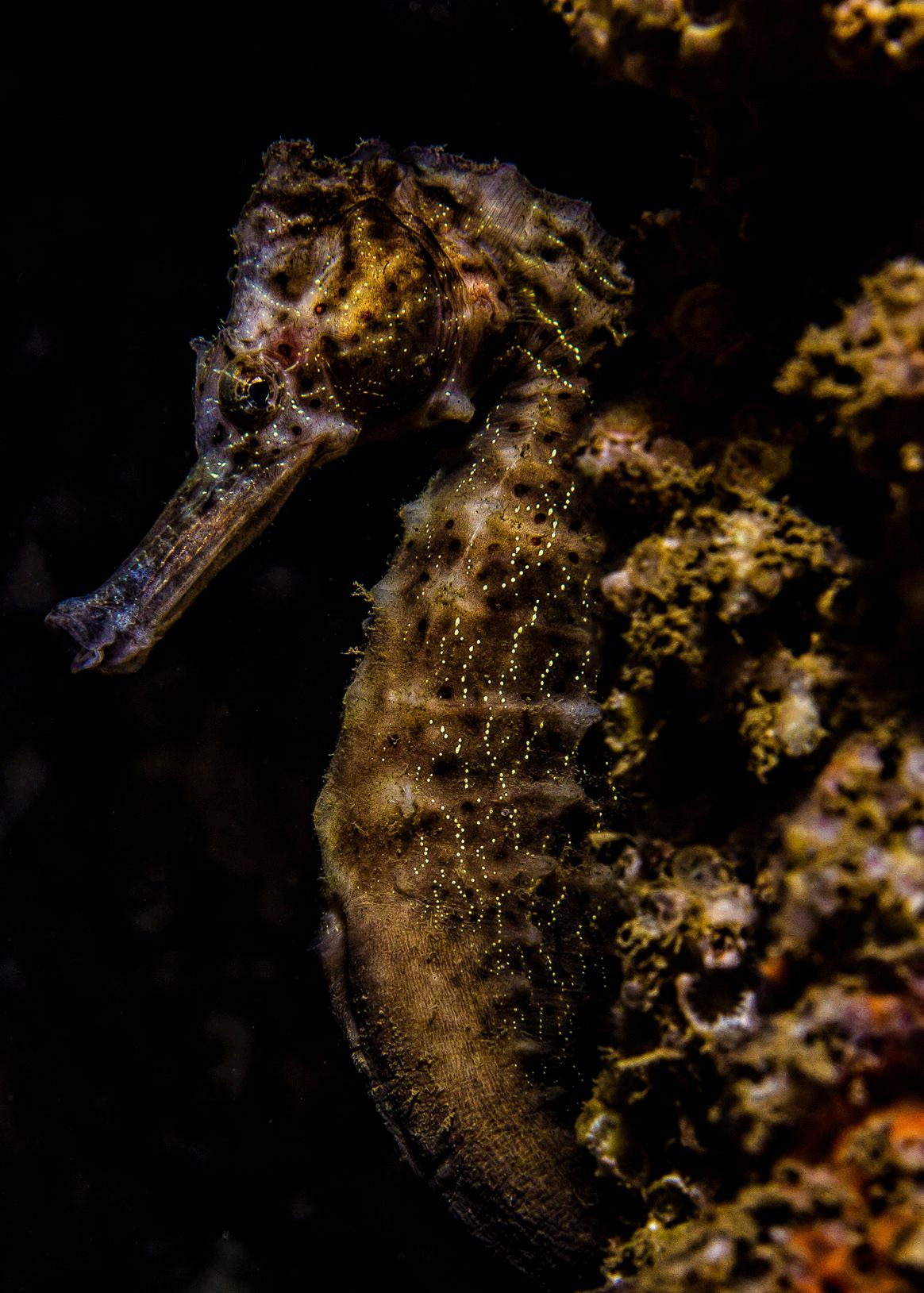
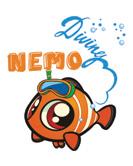




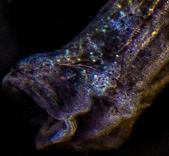
ENTER DIGITAL ONLINE EDA’S UNDERWATER PHOTOGRAPHY AND FILM COMPETITION 2023 WWW.EMIRATESDIVING.COM SUBMISSION DEADLINE Thursday 6th April 2023 at 11:59pm (GST)
Photo by Philippe Lecomte – Digital Online 2022
DIVERS FOR THE
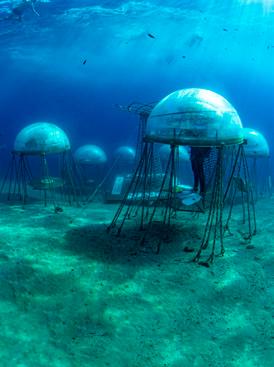
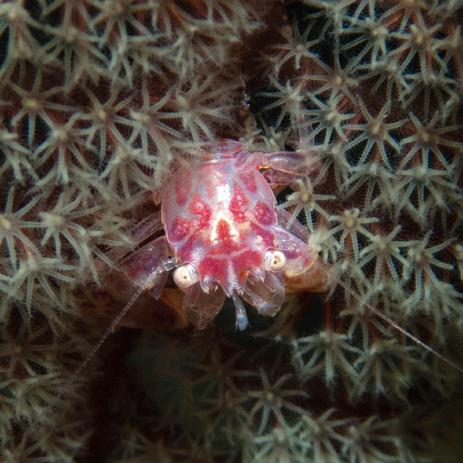
Please note that EDA’s magazine, ‘Divers for the Environment’ includes articles written by individuals whose opinions’, whilst valid, may or may not represent that of EDA’s. The magazine is a platform for individuals to voice their opinion on marine and diving related issues. You are welcome to suggest an article for the next issue released in June 2023. Send all articles, feedback or comments to: magazine@emiratesdiving.com
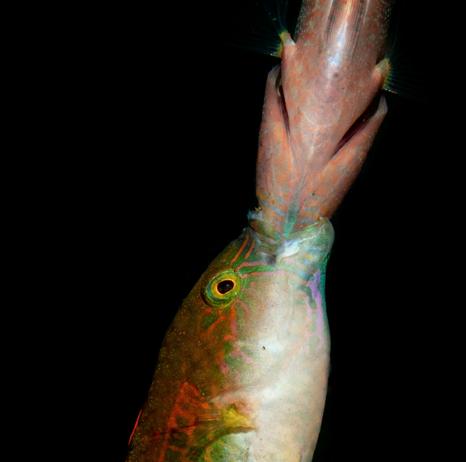
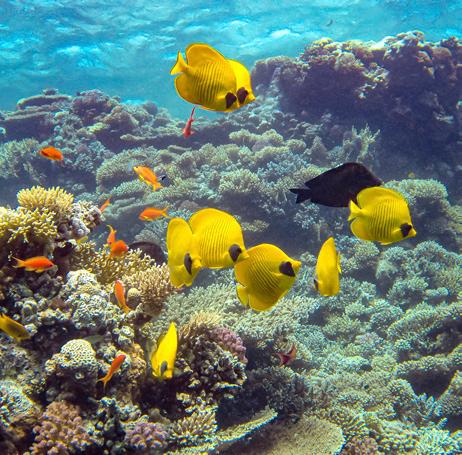
3 MARCH 2023 | DIVERS FOR THE ENVIRONMENT KIDS CORNER 16 The Arbor School Launches The Sea School Programme 18 Dr Jane Goodall Visits the Arbor School to Talk to the Roots & Shoots Members REEF CHECK 22 New Kelp Restoration Site in Big Sur, California 23 St Kitts & Nevis Launches Summer Reef Check Programme 24 Reef Check Malaysia’s Eventful 2022 25 Expanding Participatory Management With Reef Check Malaysia FEATURES 26 BCG’s 2023 Beach Clean-up 30 An Underwater Clean-up with Dubai Creek Resort & Marina 36 Nemo’s Garden Could Divers Become the Future’s Farmers? 42 Hold Your Breath – Without Stress 48 Dubai’s Underwater Hidden Secrets 52 A University Programme in Malta Is a Giant Step Forward for the Diving Industry 56 Coral Reefs Why We Need Them 60 Transformational Experiences with PADI
ENVIRONMENT
COVER
OCEANREEFGROUP &
REEF Could Divers Become the Future’s Farmers? DIVERS FOR THE ENVIRONMENT WWW.EMIRATESDIVING.COM MAGAZINE MARCH 2023 VOLUME 19 ISSUE Inspiring People to Care for our Oceans Since 1995 CUA REEF NEWS PROGRAMME TRANSFORMATIONAL REVIEWS COULD DIVERS BECOME THE FUTURE’S FARMERS? NEMO’S GARDEN REGULARS 5 EDA Co-Founder’s Note 103 Round-Up Upcoming Events and Updates 103 Did You Know? Shark News NEWS 6 An EDA Movie Screening Unmasking Monsters Below 8 Goumbook’s Save The Butt’s First Year’s Highlights 8 EDA & Goumbook’s Partnership For Save the Butts – Waste to Value Campaign 9 To Improve Marine Water Quality and Reduce Marine Pollution in Abu Dhabi EAD Issues a Marine Water Quality Policy 10 UNEP Names EAD’s Coastal & Marine Ecosystem Reservation & Rehabilitation Programmes Amongst its Top Ten Global Initiatives 12 As Part of the Abu Dhabi Mangrove Initiative Environment Agency –Abu Dhabi Plants One Million Mangrove Seeds by Drone 13 The IUCN, The World’s Oldest & Largest Environmental Network Convened in Abu Dhabi Under the Leadership of Razan Al Mubarak 14 An Introduction to Freediving Equalisation Techniques 15 PADI Teams up with Andy Casagrande To Save Sharks 74 80 88 CONTENTS
PHOTO BY
NEMO’S GARDEN BY OCEAN
PRODUCT REVIEW
64 Could Drysuits Become the Standard Exposure Suit?
UNDERWATER PHOTOGRAPHY
68 Enter Digital Online 2023
EDA’s Underwater Photography and Film Competition
74 Anilao
The Macrofauna Paradise for Underwater Photography Workshops

DIVING DESTINATIONS
80 Around the Wrecks & Reefs of the Red Sea
88 Dauin
The Philippine’s Capital of Muck Diving
94 New Year, New You, New Planet!
How to Turn Your Passion for Paradise into Positive Ocean Change
HEALTH
100 Pushing the Envelope: New Research into the Physiology of Deep Rebreather Diving
EDITOR & GRAPHIC DESIGNER
ALLY LANDES
Ally is EDA’s Project Director, Event Planner and Coordinator, Graphic Designer, Writer, Editor, Photographer and Videographer. She created and introduced ‘Divers for the Environment’ back in December 2004 as a free educational tool to share information by scientists, conservationists, underwater photographers, and other likeminded individuals from all over the world with a passion to conserve and protect our delicate marine life and underwater world.
THE CONTRIBUTORS
Meet the quarterly contributors who share their passions and stories with our readers. Want to contribute?
Email: magazine@emiratesdiving.com
DARCY KIERAN
Darcy is a former industrial engineer and sales & marketing executive that got the scuba diving “bug” and dove head first into the dive industry as a scuba diving instructor trainer & Course Director, dive stores & resorts owner/manager in Canada and the USA, scuba gear distributor and wholesaler, author, and consultant to the industry with the Business of Diving Institute. He write reports on the current state and the future of scuba diving, snorkeling, tankless diving, water sports, travel, and the great outdoors
https://wlo.link/@darcykieran
ALDO GUSTAVO GALANTE


Cardiovascular Surgeon, Rescue
Diver and Underwater Photographer. Aldo has travelled to 65 countries, in which he has dived 41 of them. He began his underwater photography in 1996, focusing mostly on capturing exotic species and has portrayed marine life amongst marine debris since 2005. www.instagram.com/aldogalante8
TONY SIDGWICK
Tony is a communications professional, writer and diver based in the UAE. He began his diving journey in 2016, and is now passionate about ocean conservation, with a Reef Check certification and several ocean clean-ups under his belt.


LUCAS ASENJO RIVAS

Lucas is a Spanish senior aquaculture technician specialised in coral reef restoration. He is an aquariology enthusiast, passionate about marine ecosystems, fish, and coral farming. He is involved in the study of the effects of climate change on coral reefs and finding possible alternative solutions.
www.instagram.com/lucasasenjo01
GORDON T. SMITH
Gordon has lived and dived in the Middle East region for the past 36 years. He is a frequent visitor to south east Asia, in particular to Indonesia and the Philippines. Nudibranchs and seahorses are his favourite subjects, and he’s always ready to dive in the UAE due to the variation in subjects he encounters.

4 DIVERS FOR THE ENVIRONMENT | MARCH 2023
36
CONTENTS
TOGETHER, WE ARE STRONGER!
I would like to welcome you all to the March issue of ‘Divers for the Environment’.We have started this year strong in conserving the marine environment. I would like to take this opportunity to thank our partners and sponsors, we are grateful for the support they have given EDA to enable us to continue our mission of conserving and protecting the UAE marine resources. We salute them for being environmentally responsible organisations, and we hope that our partnerships will last for years to come.
The Dive MENA Expo 2023 – the leading dive exhibition in the region is back this March where the diving community of the UAE and the region meets alongside the Dubai International Boat Show to discuss dive updates and share the latest in dive gear technology. We’re looking forward to seeing you all there.


I am especially looking forward to this year’s Digital Online – EDA’s Underwater Photography and Film Competition to see all our member’s new images of all the marine life they have seen on their travels. There are some really outstanding prizes to win from our sponsors. I want to welcome our new judges who have joined our resident panel this year, and thank them all in advance and wish them luck in their tough job coming up to review all the amazing underwater photos and videos that will be submitted. It’s going to be an exciting awards ceremony this year at Deep Dive Dubai.
I also want to take this opportunity to thank our EDA members who volunteer in our clean-ups, the hard work really pays off. We couldn’t do it without you. A big thank you also goes out to our members who continuously share their insightful diving experiences and underwater photos with us. Your experiences are imperative in recommending when and where to go diving, as well as what to look out for on our trips.
I do hope you enjoy reading this issue of ‘Divers for the Environment’. The EDA team continues to work tirelessly to bring more activities for EDA members to get involved in. We’re looking forward to seeing you all at the next EDA events.

Happy reading and safe diving,
 Ibrahim Al-Zu’bi
Ibrahim Al-Zu’bi
5 MARCH 2023 | DIVERS FOR THE ENVIRONMENT
EDA C0-FOUNDER’S NOTE
IBRAHIM AL-ZU’BI Co-Founder
AN EDA MOVIE SCREENING UNMASKING MONSTERS BELOW

EDA’s first Movie Screening social event of 2023 fully booked! Those who got caught up in traffic and missed to make the start of the film, were thankfully able to receive the online link and watch the documentary from home. We truly appreciate having the options available for our members.

Justin Sago’s new film, Unmasking Monsters Below was screened for EDA members on the 2nd of February at Deep Dive Dubai. A big thank you to Justin Sago and cinematographer Ryan Mathews for the rights to screen this special film, and to Deep Dive Dubai for continually supporting EDA and hosting these quarterly screenings.
SYNOPSIS
Unmasking Monsters Below (UMB) is a film that explores a passion for sharks discovered at a very early age by filmmaker Justin Sago. UMB chronicles his journey to Florida and the people along the way that brought him closer to sharks and ultimately, to the terrifying realisation of the troubles these majestic animals face today.
Unmasking Monsters Below invites you along on a path of shark discovery and the truths to the often-misunderstood animals patrolling our oceans. Be compelled to have your mind
changed, as Justin joins his travel compadre and fellow filmmaker Ryan Mathews to document the lives of three people at the forefront, spending their days interacting with sharks and doing their part to change the dreadful future these great animals face. Be prepared to witness the spiritual side of sharks and the incredible life changing impacts they have had on these individuals and others. As the UMB crew explore the waters of the shark capitol of the US, they will come face to face with sharks and attempt to unmask the monsters below.
www.unmaskingmonstersbelow.com
A MEMBERS VIEW WORDS BY HANNAH HALL
Unmasking Monsters Below, an independently filmed documentary about how humans and sharks interact, highlighted the critical role that sharks play in maintaining the balance of the ocean’s ecosystems. It also shed light on the many threats they face, including overfishing, habitat loss, and accidental capture in fishing gear. These challenges have resulted in declines in shark populations around the world, with some species now at risk of extinction.
What really stood out to me, however, was the dedication and passion of the individuals
working to protect these magnificent animals. From scientists studying their behaviour and migration patterns, to activists raising awareness and advocating for stricter conservation measures, it was clear that there are people out there who truly care about the future of sharks.
The film also emphasised the importance of community involvement in shark conservation efforts. By supporting sustainable fishing practices, reducing plastic waste that can harm marine life, and spreading the word about the importance of sharks, we can all play a role in ensuring their survival.



In conclusion, this film has left me feeling both humbled and empowered. Humbled by the sheer majesty of these creatures and the challenges they face.
WANT TO JOIN OUR EVENTS?
Our social event and online EDA Movie Screenings are only accessible to EDA members. Members must register by email to join in order to be added to the guest list to our social event, or to receive the special link to view the films online.
You can register for EDA membership or renew it via our website here: www.emiratesdiving.com/membership-form

6 DIVERS FOR THE ENVIRONMENT | MARCH 2023 NEWS




















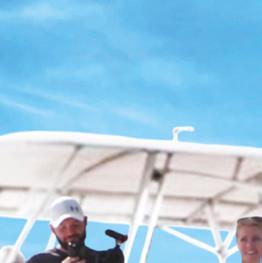

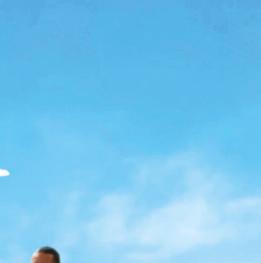


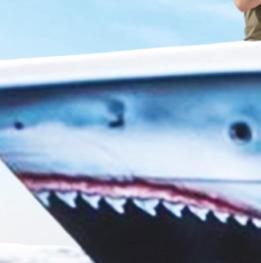

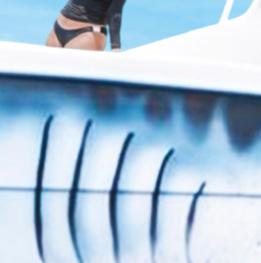
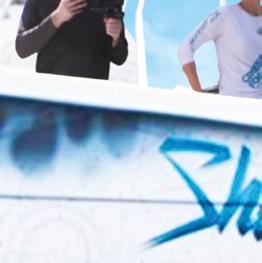
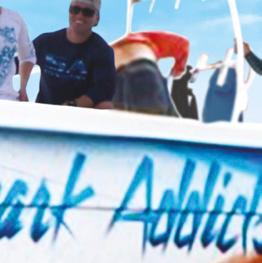
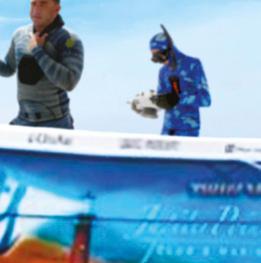
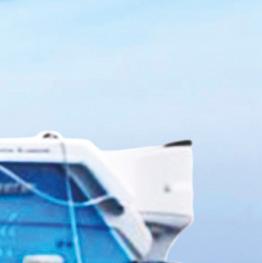

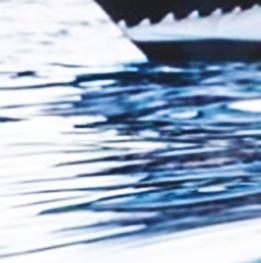

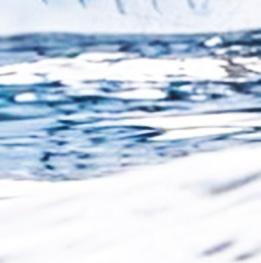


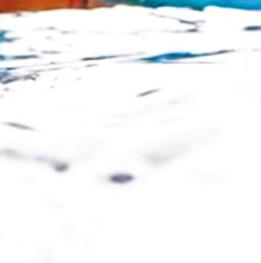

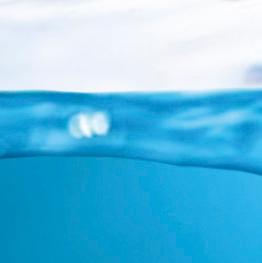
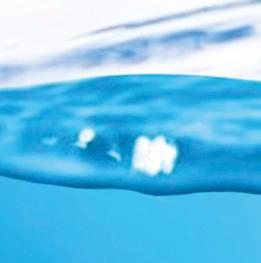
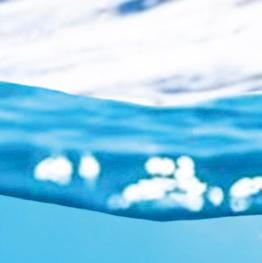
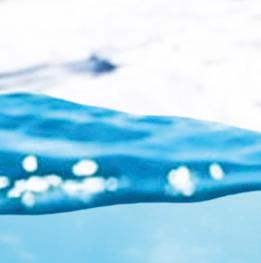
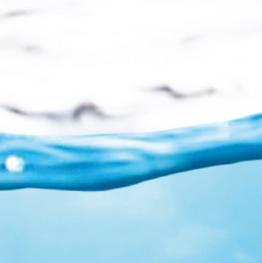

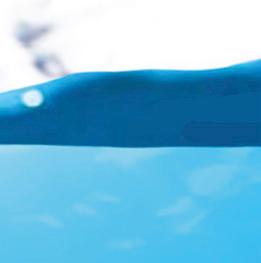
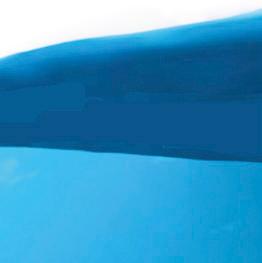








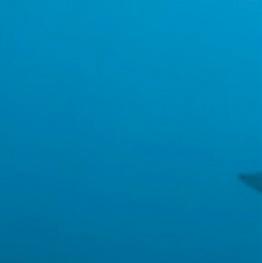
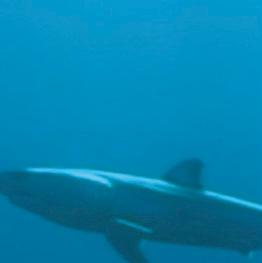


























































































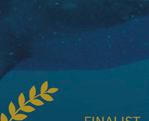








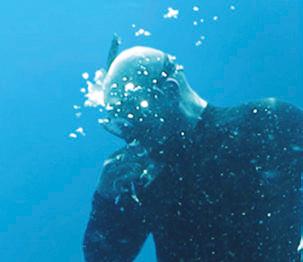

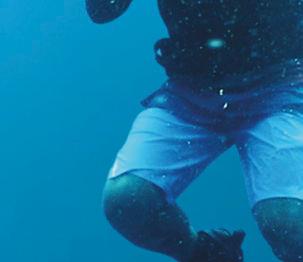

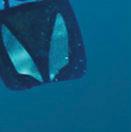



7 MARCH 2023 | DIVERS FOR THE ENVIRONMENT NEWS MONSTERS unmasking below ©MMXXIII LIST PRODUCTIONS ALL RIGHTS RESERVED WWW.UNMASKINGMONSTERSBELOW.COM DIRECTED AND WRITTEN BY JUSTIN SAGO CINEMATOGRAPHY BY RYAN MATHEWS UNDERWATER CINEMATOGRAPHY BY MICHAEL
STARRING CHRIS
RYAN MATHEWS,
ALVES,
SALAMONE,
SAGO EXECUTIVE PRODUCERS JUSTIN SAGO, RYAN MATHEWS PRODUCED BY DAN AULD, KEVIN LAPSLEY CAMERA OPERATORS DAN AULD, WILSON MCCOURTNEY SOUND EDITOR CHRIS MUNYON COLORIST AND TITLES KSKM, KEVIN LAPSLEY DRONE OPERATORS CAMERON CRENSHAW, TOM ROSS ADDITIONAL FOOTAGE BY JAKE MILMAN A SPECIAL THANKS TO SHARK ADDICTS AND SHARK ALLIES ORIGINAL MUSIC BY DAVISSON BROTHERS BAND, EL TEN ELEVEN, THIRD STORY, SOMA Unmasking Monsters Below invites you on a path of shark discovery told through the eyes of the people spending their lives in the presence of the most misunderstood animals patrolling our oceans. CINEMATOGRAPHY BY RYAN MATHEWS A FILM BY JUSTIN SAGO
DORNELLAS, MICKEY SMITH
CAMERON, MICHAEL DORNELLAS, CASSANDRA SCOTT, CADE STEURMER,
JOE
MANNY PUIG, DEBBIE
CHRIS GILLETTE AND JUSTIN
GOUMBOOK’S
SAVE THE BUTTS’ FIRST YEAR’S HIGHLIGHTS
This UAE National Environment Day on the 4th of February 2023, we proudly look back at what we have achieved together during the first year of Save The Butts:Thanks to more than 800 volunteers who participated in our different events and activations so far, we have been able to clean the UAE beaches and public spaces from over 233,000 cigarette butts. These have been collected and will undergo an innovative recycling process transforming them, along with other contaminated waste, into a sustainable alternative to plywood, thereby not only creating value from waste but simultaneously reducing the need for deforestation.
Save the Butts succeeds thanks to its unique partnership triangle: Bringing together the resources and expertise of three local organisations: Goumbook, ReLoop, and Terrax, each of which is an expert in their respective field whom also visualise that the fight against the pollution crisis is not a one-man show, but requires collaboration across companies and the involvement of all sectors of society.
Moreover, none of this would have been possible without the fantastic team from Dubai Municipality whom we thank sincerely for their enthusiasm and support.
This triple-win of environmental protection, circular solutions, and civic empowerment is what has made Save the Butts exceptionally well-received and popular with corporate clients, government partners, the hospitality and leisure sector, as well as schools, universities, and the general public.
One major milestone we are especially proud of having achieved during the campaign’s first year is the partial sponsorship of two important players in the field of ocean health and conservation globally and locally: The USbased organisation Ocean Conservancy and Dubai’s beach resort Atlantis The Palm have enabled us, with their funding and shared values, to extend our awareness programme to schools and the community, reaching more than 2,000 individuals within months.
EDA & GOUMBOOK’S PARTNERSHIP FOR SAVE THE BUTTS WASTE TO VALUE CAMPAIGN

233,650 cigarette butts collected during the campaign's first year
EDA have started this year with a new partnership with Goumbook through their Save The Butts – Waste to Value campaign.
EDA ran their first corporate beach cleanup of 2023 in February and our team of 12 volunteers from the Boston Consultancy Group (BCG in the Middle East) had collected 3,681 cigarette butts weighing in at 2kg in just over an hour especially for the STB campaign.
We’re proud to have partnered with Goumbook knowing that these butts will undergo an innovative recycling process transforming them into a sustainable alternative to plywood, thereby not only creating value from waste, but simultaneously reducing the need for deforestation.

Save the Butts – Waste to Value is a uniquely engaging environmental protection and circular economy campaign and the first to have been launched in the UAE in February 2022. Its objectives are to promote awareness of plastic pollution and ocean conservation and drive behavioural change.





































SAVE THE BUTTS VALUES Environmental Protection Circular Economy Community Action

www.goumbook.com/save-the-butts

NEWS
2
O U R I M P A C T I N N U M B E R S Collection period Feb 2022 - Jan 2023 Collection sites 5 beaches and 4 permanent collection points in Dubai I M P A C T 127.4 kg carbon emissions avoided 44.84 kg cigarette butts recycled into valuable material 37.72 kg general waste collected for recycling 111.5 mio L water protected from pollution O U T R E A C H 812 volunteers engaged 1,899 mins spent cleaning 120 awareness sessions 26 beach cleanups
TO IMPROVE MARINE WATER QUALITY AND REDUCE MARINE POLLUTION IN ABU DHABI EAD ISSUES A MARINE WATER QUALITY POLICY

The Environment Agency - Abu Dhabi (EAD) has issued a policy on sustaining marine water quality that reviews the current situation and main challenges related to marine water quality in the emirate. The policy is part of EAD’s efforts to maintain and sustain Abu Dhabi’s marine waters, and limit practices that can cause marine pollution.
The policy aims to develop relevant legislative and regulatory frameworks, and halt discharges that may have adverse impacts on the marine environment by fostering recycling and reuse programmes. The policy will also develop a programme that enhances preparedness in cases of emergency that affect marine water quality, and will enhance knowledge and awareness about the potential adverse impacts of pollutants, proposing solutions to mitigate these.
Contributing to addressing the challenges facing marine water quality in the emirate, the policy is part of a sustainable solution to achieve EAD’s vision. The implementation of the policy will improve the performance of environmental indicators in the emirate,
ensure the sustainability of fishing activities as part of the emirate’s social heritage, as well as promoting recreational, tourism and marine sports activities.
Throughout the development process of the policy document, EAD worked in close coordination and consultation with stakeholders and strategic partners, through workshops, bilateral meetings, and knowledgesharing. The policy is in alignment with national and local policies, plans and strategies, including the National Food Security Strategy 2051, the UAE Water Security Strategy 2036, Plan Maritime 2030: Abu Dhabi Coastal and Marine Framework Plan, the National Plan for Combating Marine Pollutants 2019, and the Abu Dhabi State of Environment Report.
Her Excellency Dr Shaikha Salem Al Dhaheri, Secretary General of EAD, said, “The sustainability of coastal and marine resources plays an important role in their preservation across generations, which enhances the social, economic and environmental value of coastal and marine areas. These include tourism, transport, oil and gas exploration
and commercial uses, in addition to the contributions of other sectors such as heritage, marine environments and protected areas. These natural resources could be exposed to threats in case there is a deterioration in marine water quality which may also cause habitat loss and reduction in attractive and endangered species, biodiversity and environmental services.
Her Excellency added, “For the proper governance and coordination between concerned authorities, the policy will be implemented in the emirate under our supervision through consultation, coordination and cooperation with strategic partners at the local and federal levels. We will also analyse the impacts of the policy’s implementation based on systematic procedures that will help us attain our goals. The policy implementation tools include initiatives that seek to manage discharges to the marine environment in a more sustainable manner, complete the relevant regulatory frameworks, and respond to environmental emergencies in accordance with the national policies, programmes and plans of the United Arab Emirates, as well as the local plans of the emirate of Abu Dhabi.”
9 MARCH 2023 | DIVERS FOR THE ENVIRONMENT NEWS
UNEP NAMES EAD’S COASTAL & MARINE ECOSYSTEM RESERVATION AND REHABILITATION PROGRAMMES AMONGST ITS TOP TEN GLOBAL INITIATIVES
His Highness Sheikh Hamdan bin Zayed Al Nahyan, Ruler’s Representative in Al Dhafra Region and Chairman of the Board of Directors of the Environment Agency – Abu Dhabi, praised the emirate’s achievements, led by the Agency in the field of rehabilitation of coastal, and marine ecosystems.
These efforts have strengthened the emirate’s leadership in preserving marine biodiversity in line with Abu Dhabi’s strategic environmental goals, which were inspired by the founding father Sheikh Zayed bin Sultan Al Nahyan, as well as the wise directives laid down by the late Sheikh Khalifa bin Zayed Al Nahyan. The initiatives also continue on the pathway set by His Highness Sheikh Mohammed bin Zayed Al Nahyan, President of the United Arab Emirates.

His Highness stated,“Abu Dhabi has confirmed its leadership and succeeded in strengthening its global position in the field of preserving the environment and protecting species, as well as implementing plans and programmes to restore and rehabilitate them.”
His Highness Sheikh Hamdan added, “We have worked in several directions to sustain our marine environments and have succeeded in restoring our fish stocks, strengthened our plans to plant and rehabilitate mangroves, and launched the region’s largest coral reef rehabilitation project – all of which further emphasises the emirate’s important role at both a local and global level in the conservation of species and their ecosystems. Efforts and resources are being directed to serve the goals of sustainable development and to preserve natural resources and ensure their sustainability for future generations ”
His Highness shared his comments on the occasion of the United Nations Environment Program’s announcement, which saw EAD-
led programmes in Abu Dhabi named among the top ten list of global initiatives to restore and rehabilitate coastal marine ecosystems. The announcement was made on the sidelines of the high-profile meetings of the UN Biodiversity Conference (CBD COP15), which took place from December 13-17 in Montreal, Canada

These programmes to preserve and rehabilitate coastal and marine ecosystems were selected following evaluations conducted in accordance with UNEP’s standards and requirements, proving some of the most promising and ambitious, and viewed as pioneering models at a global level. The selection was made from among more than 150 candidates from different countries, and approved by 70 government agencies, as a result of the Agency’s distinguished efforts in rehabilitating the unique biodiversity habitats of Abu Dhabi’s coasts and waters for endangered marine animal species and local communities
Her Excellency Dr Shaikha Salem Al Dhaheri, Secretary General of the Environment Agency – Abu Dhabi, said, “Our marine habitats thrive despite the challenges they face due to high temperatures and increased salinity in the emirate’s waters – which is unique in a world where the effects of climate change are increasing. In light of the pressures that our natural habitats face due to the rapid development in the region, as well as coastal development activities and projects related to housing, tourism and infrastructure – which have impacted critical coastal and marine habitats – we have taken proactive measures to balance the requirements of economic and social development, sustainable exploitation of resources, and the development of rehabilitation initiatives and ecosystem restoration within the framework of the emirate’s plans and strategies ”
Her Excellency elaborated, “The initiatives and programmes launched and implemented by EAD since its inception attracted UNEP’s attention and led to its recognition as a pioneer in the field of rehabilitation and the restoration of ecosystems. Our success story includes a remarkable improvement in our fish stocks, plus significant achievements in the field of mangrove, seagrass, and coral reef rehabilitation, which are among Abu Dhabi’s most important and productive marine habitats that support biodiversity, and provide a natural habitat for several types of fish and marine organisms ”
The Agency participated in UNEP’s inaugural session to select the ten best leading initiatives to prevent and reverse the degradation of environmental ecosystems around the world by reviewing the distinguished efforts of the programmes it implements at the local and international levels in promoting and protecting environmental systems. The Agency also assists in international efforts and fulfils its obligations stipulated in international environmental conventions and treaties. All these initiatives are among the priorities set forth in EAD’s strategic plans to support objectives derived from the leadership’s wise vision that aspires to make Abu Dhabi a world leader in preserving the environment
The coastal and marine areas of Abu Dhabi, located on the southern border of the Arabian Gulf, are considered a hotspot for biodiversity, housing various habitats that support a wide range of marine species and large fish. The Agency has worked to improve the condition of deteriorating fish stocks that had been depleted by up to 85% according to its studies and surveys.
Implementing EAD’s guidance in this context helped protect fish stocks, with data showing
10 DIVERS FOR THE ENVIRONMENT | MARCH 2023 NEWS
that Abu Dhabi is on track to achieve its goal of sustainable fisheries by 2030. An improvement has also been achieved in the sustainable fishing index for three consecutive years, rising from 8.9% in 2018 to 62.3% by the end of 2021. The Agency will continue working to ensure the recovery of fisheries, while achieving a level of sustainable fishing
Efforts made by the Agency to establish and manage natural reserves through the Sheikh Zayed Protected Area Network, which comprises six marine reserves representing 14 per cent of the emirate’s marine environment, have also contributed to preserving biodiversity in Abu Dhabi, ensuring the sustainability of resources and promoting associated social and economic development.

These efforts have generated positive results for a number of habitats and species, helping to stabilise important organisms and increase the number of birds such as flamingos, and stabilise important marine habitats such as coral reefs – for which the Authority launched a special rehabilitation initiative. The Agency has also launched the region’s largest coral reef rehabilitation project, with the aim of cultivating more than one million colonies of coral reefs to increase their area and mitigate the pressures on coral reefs as a result of climate change and rising temperatures at the sea floor.
The Agency also focused its efforts on protecting mangroves through targeted programmes for planting and rehabilitating mangrove areas and using modern technologies in agriculture, such as drones. These initiatives were recognised by the World Economic

Forum as one of the most innovative in the field of blue carbon sequestration. Over the past 10 years, 15 million mangrove trees were planted, contributing to more than a 35% increase in the area of Abu Dhabi’s mangrove trees, which today exceeds 176 square kilometres, including natural and cultivated trees. Studies conducted by the Agency revealed the ability of mangroves in Abu Dhabi to store carbon at a rate of 0.5 tons per hectare annually, which is equivalent to 8,750 tons at the emirate level, and to the energy consumption of 1,000 homes per year
The Agency’s efforts also led to the preservation of the integrity of the emirate’s seagrass meadows, contributing to the stability
of dugong numbers in their natural habitats. Abu Dhabi is home to the second-largest group of dugongs, with numbers exceeding 3,000 – the highest density per square metre in the Arabian Gulf region.
Studies also showed an improvement in the number of turtles and their stability in the emirate in recent years, with numbers estimated at about 5,000 hawksbill turtles, green turtles and loggerhead turtles. The Agency’s efforts also ensured protection of three types of dolphins and one type of porpoise, with the emirate’s waters hosting a population of more than 700 dolphins, most of which live in marine protected areas – including the largest group of Indian Ocean humpback dolphins in the world

11 MARCH 2023 | DIVERS FOR THE ENVIRONMENT NEWS
AS PART OF THE ABU DHABI MANGROVE INITIATIVE ENVIRONMENT AGENCY – ABU DHABI PLANTS ONE MILLION MANGROVE SEEDS BY DRONE
The Environment Agency – Abu Dhabi (EAD) has successfully planted one million mangrove seeds using drones as part of the first phase of a drone mangrove plantation project supporting the Abu Dhabi Mangrove Initiative.
The Abu Dhabi Mangrove Initiative was announced in February 2021 during His Royal Highness Prince William, the Duke of Cambridge’s landmark visit to the UAE, where he met with His Highness Sheikh Khaled bin Mohamed bin Zayed Al Nahyan, Member of the Abu Dhabi Executive Council and Chairman of Abu Dhabi Executive Office, at Jubail Mangrove Park.
This initiative, which is implemented by EAD with a series of local, regional and international partners, supports Abu Dhabi’s ambitious plans to establish the emirate as a global hub for research and innovation in support of the conservation of mangroves, and focuses on the importance of mangroves for carbon sequestration to combat climate change.
The initiative supports the UAE Ministry of Climate Change and Environment’s target, announced during COP26 in Glasgow in 2021, that unveiled a nationwide plan to plant 100 million mangroves by 2030. Following this, in February of this year, the Abu Dhabi Mangrove Initiative was launched.
EAD is the first organisation to utilise and plant mangroves at a large-scale utilising ecological principles, enhanced by drones. The planting of one million seeds follows a successful initial phase implemented by EAD in partnership with ENGIE, the global energy company, and Distant Imagery, a drone engineering solutions company.
This initial phase focused on planting mangroves via drones in 2020, with up to a
48% success rate. EAD then scaled up the project, with one million mangroves planted via drones at different locations around Al Mirfa, in Al Dhafra Region.
The use of drone technology to plant mangroves has several advantages as the environmental footprint of the methodology is low, since it removes the need of intense labour, and the need of sapling transportation. It is also cost effective as it reduces the overall price of mangrove planting, eliminates the need of mangrove nurseries and associated costs, and facilitates reaching remote and difficult areas. The project is also running a trial on incorporating machine learning for future monitoring phases.
Her Excellency Dr Shaikha Salem Al Dhaheri, Secretary General of EAD, said, “The UAE began mangrove plantation in the 1970s under the guidance of the late Sheikh Zayed Bin Sultan Al Nahyan, Founder of the UAE and also known as the First Environmentalist. He commenced mangrove plantation along the coasts of the islands and mainland of the emirate of Abu Dhabi. Using the knowledge of local communities and his foresight, Sheikh Zayed advised on and supervised the project, and for the late Sheikh Zayed, the plantation of mangroves, whether it was on terrestrial or marine habitats, was a passion. The Eastern Mangrove plantation was the inception of the first mangrove plantation programme of Abu Dhabi.
She added, “Despite the fact that the world’s mangroves are declining due to natural and human challenges they are facing, Abu Dhabi has a different story to tell as the plantation of mangroves has continued in the UAE at large, and in Abu Dhabi in particular, in a slow but steady manner. A prime example is our latest project of planting one million mangrove
seeds via innovative drone technology. This project is one of a number of programmes run by the Abu Dhabi Mangrove Initiative in support of the UAE’s pledge to plant 100 million mangroves in 2030.
She elaborated, “The success rate for this year’s planting looks great so far and based on the data we will do a refilling of areas for future successes of the project. This project is a continuation of our efforts to mitigate the disastrous effects of climate change as mangroves have proven to be very efficient at carbon sequestration, thus reducing the levels of carbon dioxide entering the atmosphere.”
With each planting round EAD has been evolving not only its methodology for seed germination and site planting patterns, but also seed dispersal mechanisms and drones so that they can fly longer. The drone is self-designed and engineered to drop seedlings from the air, monitor the growth of mangrove saplings, map the habitat, and create 3D imaging.

The Agency plans to further evolve its methodologies and technology. Data has shown that the growth of the seed in-situ using drones has a success rate that remains stable over three years.
In Abu Dhabi, plantation programmes have helped increase the range of mangroves. The increase of mangrove areas in Abu Dhabi was more than 35%, and is the result of plantation and restoration programmes, as well as protection laws and regulations that ensure the sustainability of environmental ecosystems.
In the past 10 years, EAD and its key stakeholders, from both the government and private sector, have planted more than 15 million mangroves along the coast of Abu Dhabi.
12 DIVERS FOR THE ENVIRONMENT | MARCH 2023
NEWS
THE IUCN, THE WORLD’S OLDEST & LARGEST ENVIRONMENTAL NETWORK
CONVENED IN ABU DHABI UNDER THE LEADERSHIP OF RAZAN AL MUBARAK
Her Excellency Razan Al Mubarak, President of the International Union for Conservation of Nature (IUCN), the world’s oldest and largest environmental network, announced the IUCN would hold its 108th Council Meeting in Abu Dhabi from the 18-20 January 2023. The meeting convened just one month after the historic Kunming-Montreal Global Biodiversity Framework took place where nations pledged to halt and reverse biodiversity loss by 2030 and to protect at least 30% of terrestrial and marine areas.
With over 1,450 member organisations and more than 15,000 international experts, the IUCN provides public, private, and non-governmental organisations with the knowledge and tools that enable human progress, economic development, and nature conservation to take place together.
The IUCN meeting brings together nearly 100 Council members, staff, and expert volunteer conservationists from around the world, including West and Southeast Asia, Oceania, South and North America, Africa, and West, Central, and East Europe. The meeting focused on the latest developments in nature conservation and exploring opportunities to incorporate nature and biodiversity conservation into the United Nations Climate Change Conference (COP28) process. COP28 will take place at Expo City Dubai from November 30 to December 12, 2023. The IUCN meeting was made possible with financial support from the Abu Dhabi Government.
Ms Al Mubarak was elected to a four-year term as President of the IUCN in September 2021. In her role, she presides over the work of the Council; guides the IUCN Director General on issues and policies; works to elevate further the high regard in which the IUCN is held in the international arena; enhances the contribution it makes to support the protection of nature; facilitates its access to governments and international organisations at the highest level; and represents the IUCN at international events and meetings.
“I am honoured to welcome conservation leaders from around the world to Abu Dhabi. With the UAE as host to COP28 later this year, this is the perfect opportunity to explore the convergence of agendas between biodiversity and climate change,” said Ms Al Mubarak. “I am so proud that Abu Dhabi has prioritised nature and species conservation internationally, both through its sponsorships of events like this, and by leading important national and global initiatives to conserve Oryx, Houbara, and a myriad of threatened species.”
Ms Al Mubarak said the IUCN Council Meeting will also provide an opportunity to showcase the UAE’s leadership and innovation in nature conservation, particularly that of UAE-based IUCN members including the Ministry of Climate Change and Environment, Environment Agency – Abu Dhabi, Dubai Desert Conservation Reserve, Al Ain Zoo, International Fund for Conservation of Houbara, as well as the Mohamed bin Zayed Species Conservation Fund, Emirates Nature –
WWF, and the Emirates Environmental Group.
This is not the first time that Abu Dhabi has hosted IUCN functions. Beginning in 2008, and again in 2012, 2015, and 2019, Abu Dhabi sponsored the leadership and planning meetings of the IUCN’s Species Survival Commission – an entity responsible for the IUCN Red List of Endangered Species. Over 200 delegates from around the world convened in Abu Dhabi during each of those four events.

ABOUT RAZAN AL MUBARAK
Elected President of the International Union for Conservation of Nature (IUCN) in September 2021, Razan Al Mubarak is the second woman to lead the organisation in its 75 year history and its first president from West Asia. She also serves as UN Climate Change
High-Level Champion for the leadership team of COP28 UAE, which will take place in Dubai from November 30 to December 12, 2023. For more than 20 years, Razan has played a vital role in guiding the United Arab Emirates toward a more sustainable future while spearheading progressive environmental protection, species conservation, and climate action across West Asia and globally. Her diverse experience leading the largest environmental regulatory agency in the Middle East, an international philanthropic organisation supporting species conservation projects worldwide, and an NGO focused on citizen engagement earned her recognition as one of the top 100 Young Global Leaders by the World Economic Forum in 2018.
13 MARCH 2023 | DIVERS FOR THE ENVIRONMENT
NEWS
AN INTRODUCTION TO FREEDIVING EQUALISATION TECHNIQUES
BY BASSEL OUNAH – INSTRUCTOR TRAINER & FREEDIVING JUDGE
Freediving, also known as breath-hold diving, is a popular activity for people who enjoy the thrill of diving without using scuba equipment. One of the most critical skills in freediving is equalisation, which allows divers to safely and comfortably descend to deeper depths.
Equalisation is maintaining equal pressure in the middle ear and the surrounding environment during a dive. As a diver descends, the pressure of the water around them increases, which can cause the eardrum to become painful, or even rupture if not adequately equalised.
There are several techniques that divers can use to equalise their ears, including the “Valsalva manoeuvre,” the “Frenzel manoeuvre,” and the “Mouthfill manoeuvre.” The Valsalva manoeuvre involves pinching the nose and blowing gently against it to force air into the middle ear. The Frenzel manoeuvre involves tensing the back of the throat and blowing gently to force air into the middle ear. In the Mouthfill manoeuvre, we have air in the oral cavity and the tongue is down so we can charge more air into the mouth. With this manoeuvre, we first press with the jaw, then with the cheeks, and then with the tongue.
Another vital aspect of equalisation is learning how to equalise at the right time. Many divers make the mistake of waiting too long to equalise, which can cause discomfort or injury. It is essential to start equalising as soon as the descent begins, and to continue equalising throughout the dive.
It’s also vital not to over equalise. It’s easy to become obsessed and end up doing too much, which can lead to injury. The key is to find the right balance between equalising enough to avoid discomfort and equalising too much.
Equalisation is essential for any freediver and should be practiced and mastered before attempting deeper dives. With proper technique and timing, divers can safely and comfortably explore the ocean’s depths.


IN CONCLUSION:
Freediving equalisation is a crucial skill that allows divers to safely and comfortably descend to deeper depths. It involves using techniques such as the Valsalva, Frenzel, and Mouthfill manoeuvres to maintain equal pressure in the middle ear, and the surrounding environment. It’s important to start equalising as soon as the descent begins, and to continue equalising throughout the dive. With practice and patience, divers can master this skill and safely explore the ocean’s depths.
14 DIVERS FOR THE ENVIRONMENT | MARCH 2023 NEWS
PADI TEAMS UP WITH ANDY CASAGRANDE TO SAVE SHARKS
PADI has teamed up with shark conservationist, Discovery’s Shark Week personality, and Emmy Winner, Andy Casagrande to design a PADI Gear™ signature collection to create positive ocean change for sharks.
Saving sharks, which are keystone species as the top apex predators in the ocean, is an integral part of PADI’s Blueprint for Ocean Action, with the established goal of reducing the number of sharks and rays facing extinction by 25% in the next decade. To date, PADI has already helped secure protection measures for 51 species of sharks and rays, with the goal of protecting 54 more in the next three years.
“PADI and Andy Casagrande have worked closely together to design a sustainable limitededition collection that gives consumers a more balanced perspective of sharks and inspires them to join us in being united in fins and taking action to protect them,” explains Lisa Nicklin, Vice President of Consumer Marketing at PADI Worldwide.
PADI X ANDY CASAGRANDE RECYCLED PLASTIC TRAVEL TOWEL
PADI has selected one of Andy’s iconic shots to be featured on a recycled plastic towel that contains the equivalent of 14 plastic bottles. Great for beach days, dive days, yoga, travel and camping adventures, your purchase also helps protect the Great White Shark, a threatened shark species. 15% of proceeds go to PADI AWARE’s shark campaigns. Sustainable and soft, our exclusive Great White Shark towel is versatile without sacrificing performance, so you can own less and do more. Made from Repreve, our GWS towel contains 80% recycled polyester from post-consumer plastic.

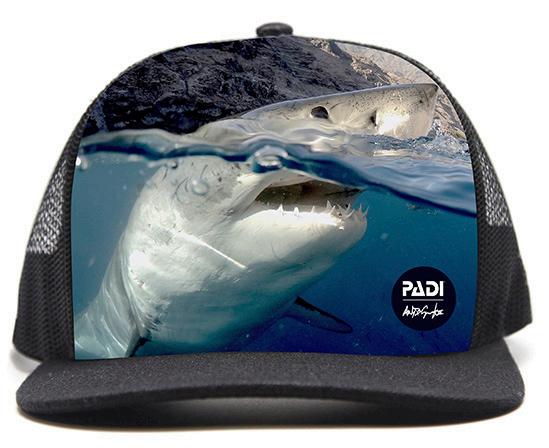
DETAILS:
• Made with recycled plastic bottles
• Holds up to the washing machine – and gets softer with each wash
• Double-sided exclusive Great White Shark print (one side in full colour, the other, in black and white)
• Super absorbent & quick drying
The signature collection features a recycled plastic towel, sustainable tee and recycled plastic trucker hat – all made with eco-friendly material that features Andy’s iconic imagery. For instance, the PADI x Andy Casagrande recycled plastic towel is equivalent to 14 plastic bottles taken from the ocean.
Designed to encourage consumers to rethink the shark and highlight the beauty and importance of this 450 million-year-old predator, this collection is one with a purposedriven cause. PADI and Andy Casagrande have committed 15% of the net proceeds towards funding shark conservation efforts around the world – with the most recent campaign being focused on advocating for the CITES protection of 50 new species of sharks.
“I love sharks more than anything,” says Casagrande. “This special collection with PADI has allowed me to fund their protection and change people’s perspectives about their role in the health of our shared blue planet.”
PADI X ANDY CASAGRANDE RECYCLED PLASTIC TRUCKER HAT
Made from recycled plastic (35% of it recycled from ocean plastic), each hat contains the equivalent of 8 plastic bottles.Your purchase of this hat and any other item from our exclusive collection helps protect the endangered great white shark. 15% of proceeds go to PADI AWARE’s shark campaigns.
DETAILS:
• Flat bill, trucker cap
• Universally flattering; looks great on men and women
• Medium profile, single panel, stiff fabric front
• Woven patch with collection logo in lower corner
• One size fits most
• Mesh sides and back with a plastic, adjustable snap back
This signature collection is the third in which PADI has teamed up with shark conservationists who are also award-winning shark photographers. Last year PADI teamed up with AmbassaDiver™ Mike Coots for a special Shark Week collection.
“PADI Gear has helped remove more than 60,000Ibs of plastic from the ocean, which will only continue to grow through special collaborations like these,” continues Nicklin.
The PADI x Andy Casagrande signature collection is available now, just in time to give a gift that supports saving sharks and their watery home, with limited supply. To see the collection, go to: www.padigear com
For divers by divers, PADI is obsessed with transforming lives and with its global foundation, PADI AWARETM, creating positive ocean change. Seek Adventure. Save the Ocean.SM
www padi com
This is a classic unisex Jersey crewneck long sleeve t-shirt which will keep you warm and cozy.
DETAILS:
• Made from 100% Airlume combed ringspun cotton
• Features a stunning Andy Casagrande original Great White Shark photo
• Printed collection logo on shirt front and back photo design
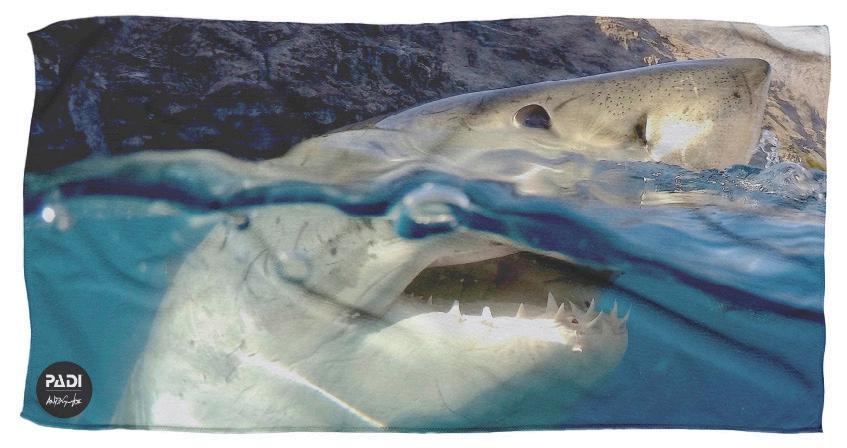
15 MARCH 2023 | DIVERS FOR THE ENVIRONMENT NEWS
PADI X ANDY CASAGRANDE UNISEX LONG SLEEVE T-SHIRT
THE ARBOR SCHOOL LAUNCHES THE SEA SCHOOL PROGRAMME
The Arbor School is proud to announce the launch of its new Sea School programme, a unique educational experience that combines traditional classroom learning with hands-on, experiential education in marine biology and conservation.
The Sea School programme, which will be available to students in Foundation Stage through to Key Stage 3,provides the opportunity to explore the ocean and learn about the diverse marine life that inhabits it. Through a combination of classroom instruction and field trips to local marine habitats, students will gain a deeper understanding of the ocean and the importance of protecting it.


Principal of the Arbor School and Ecologist, Brett Girven, commented, “Place-based learning is about making the walls of a school more permeable – bringing our learners to the world beyond our gates and inviting the world in. Connecting with and learning about
‘this place’ is the foundation of caring for this place, and where better to do that than within the natural world right on our doorstep. I am only jealous that I can’t escape from my office more often to join the Sea School!”
The programme will be led by a team of experienced educators including the Arbor Scientist in Residence – Dr Tiffany Delport, a marine biologist who will provide Arbor students with the knowledge and skills needed to understand and protect the ocean.
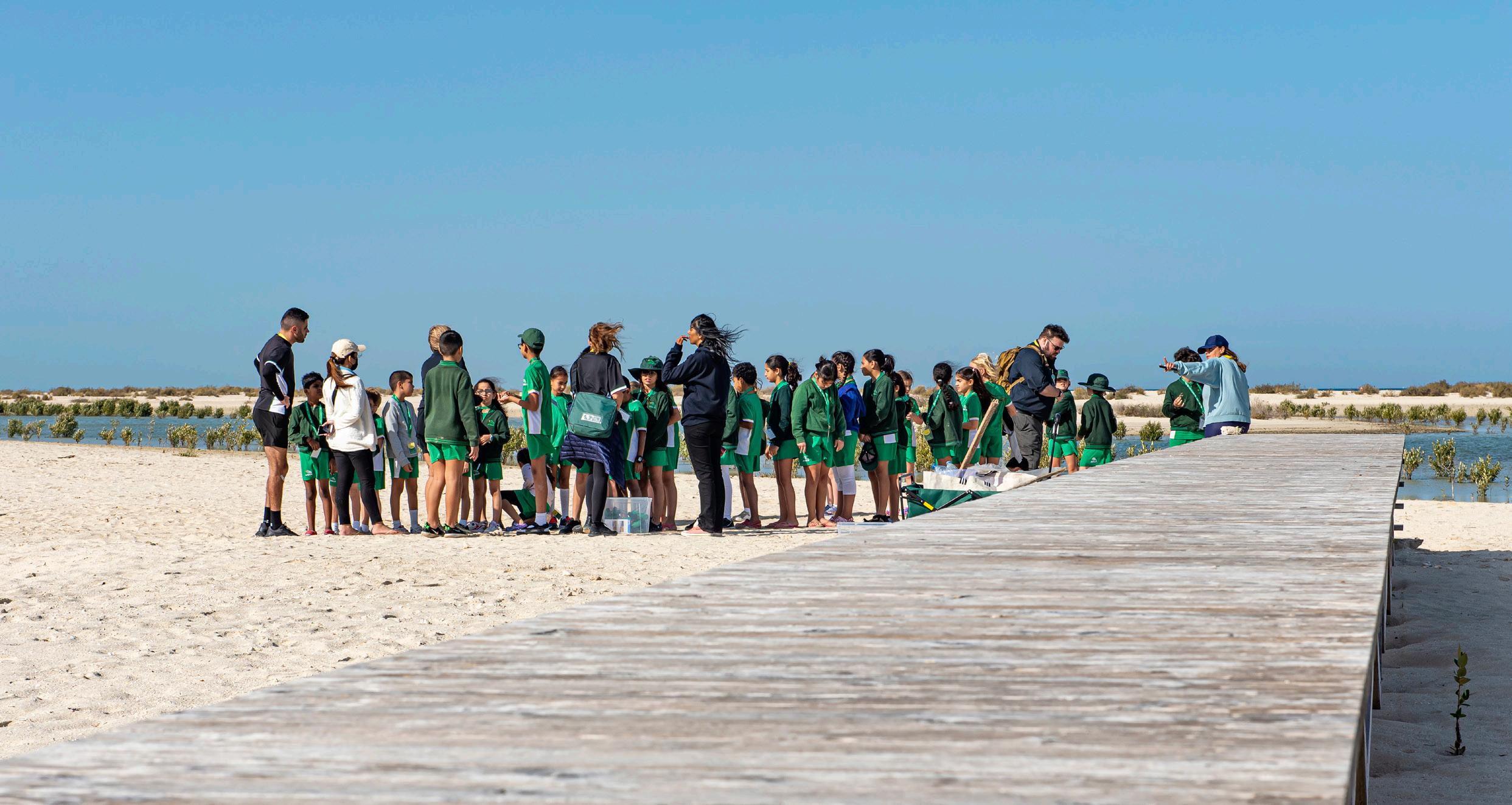
“Jebel Ali Wildlife Sanctuary is an ecologically significant area,” says Dr Tiffany. “Rich in biodiversity, this beautiful coastal wetland supports over 500 species of marine flora and fauna. Conserving our wetlands is crucial for the survival of the species they support. Sea School is a unique opportunity for students to observe and connect with marine habitats, while learning invaluable skills for safeguarding their future.”
In addition to classroom instruction, students will participate in field trips to local marine habitats, such as The Jebel Ali Wildlife Sanctuary and other marine protected areas, where they will have the opportunity to study and observe marine life firsthand.

The Arbor Sea School programme will also include opportunities for students to participate in hands-on research projects, such as monitoring water quality and tracking marine animals, as well as opportunities to engage with the local community through conservation and outreach efforts.
The Arbor School is committed to providing students with a high-quality education that emphasises environmental stewardship and sustainability. The Sea School program is just one example of the school’s commitment to providing students with hands-on, experiential learning opportunities that will inspire them to make a positive impact on the world.
16 DIVERS FOR THE ENVIRONMENT | MARCH 2023 KIDS CORNER
FEATURE
LANDES
HANNAH HALL PHOTOGRAPHY ALLY
The Arbor School students curiously explore the Jebel Ali Wildlife Sanctuary with binoculars and magnifying glasses, and took part in a beach clean-up where they learnt to record and weigh the marine debris collected as part of their environmental stewardship.
For more information about the Sea School programme, email Hannah Hall, Head of Marketing and Communications at the Arbor School.









EMAIL: hhall@thearborschool.ae

17 MARCH 2023 | DIVERS FOR THE ENVIRONMENT KIDS CORNER
DR JANE GOODALL
VISITS THE ARBOR SCHOOL TO TALK TO THE ROOTS & SHOOTS MEMBERS
FEATURE HANNAH HALL PHOTOGRAPHY ALLY LANDES
Dr Jane Goodall, a renowned primatologist and anthropologist best known for her long-term study of chimp behaviour in Tanzania’s Gombe Stream National Park, visited Dubai’s leading school of ecology on Friday 27th January, providing students with an incredible opportunity to learn from one of the world’s leading experts on environmental conservation and animal behaviour.
Receiving Dr Jane were students from Arbor’s Secondary School, Principal Brett Girven and Dr Sa’ad Al-Omari, the Arbor School’s Chief Executive Officer and a recognised Palaeoclimatologist.
Dr Jane was given a tour of the Arbor Biopark by students who also demonstrated to her the many crops grown there as part of the Farm to Plate initiative. Following the tour, they dined on a multi-course vegan meal made on site by Michelin-trained chef Anna Marie Herreras and including produce from the school farm.
The Farmhouse at Arbor, run by Chef Anna, is renowned for its dedication to sustainable agriculture and use of locally sourced products
in its parent café and school lunches. Dr Jane appreciated a meal that was both creative and environmentally friendly, with each dish created to bring out the tastes of the food from the school farm.
After lunch, the Arbor School welcomed Roots & Shoots members from Dubai Schools Mirdif and Al Barsha, the American School of Dubai, Rawafed Private School, Dubai British School, Horizon International School, Abu Dhabi Indian School, and GEMS United Schools to the school’s auditorium for a special presentation by Dr Jane Goodall, facilitated by Principal Brett Girven.
The founder of Roots & Shoots and the Jane Goodall Institute, a global wildlife and environmental conservation organisation that is dedicated to promoting understanding and protection of great apes and their habitats, began her talk by giving a pant-hoot, a loud chimpanzee call to introduce herself. Dr Jane then detailed her life story and the most important scientific observations of modern times in a remote African rainforest where she “witnessed a creature other than a human in the

act not just of using a tool, but of making one.”
Brett Girven, Principal of the Arbor School, commented, “Dr Jane told a story of hope – the hope that we can make a difference by simply starting. Large or small, just do something which will bring us closer to the more beautiful world we know is possible. If the impoverished families living on the periphery of Gombe in Tanzania can do it, then surely, we, in our privileged position can do it. In fact, we MUST do it.”
QUESTIONS ASKED BY THE STUDENTS
Student 1: What pushed you to continue your research even when you faced criticism? What do you do when you feel disheartened?
Dr Jane Goodall: I didn’t really want a PhD – I wanted to write books. I was doing the PhD for Louis Leakey, and when they wouldn’t leave me alone, I thought, well Louis Leakey believes in me, and I know what I’m doing is right because of my dog, so I just went on quietly doing it, and thinking – you know – poof to them! I’m just going to prove that they’re wrong, and I’m right.
18 DIVERS FOR THE ENVIRONMENT | MARCH 2023 KIDS CORNER
Student 2: Knowing what we know about your work and the people you’ve inspired, what rights do you think we should give to these and other equally important animals and plants?
Dr Jane Goodall: Well, what rights? I don’t know, you know I think it’s about human responsibility and there are human rights which are violated everyday, all around the world. It’s fine to give great apes and other animals rights, it’s just one step, it shows that countries are understanding finally that we’re not the only sapient creature on the planet. I think Roots & Shoots will do more for animals then any kind of legislation. I could talk to you for hours about animal intelligence. So it’s up to all of you, and tell your friends. Lets understand that every single animal in one of those factory farms, every cow, every pig, every chicken – they are all individuals, they’re all capable of feeling fear, terror and pain. Every one of them.
Student 3: During all of your research spent out in the field, what is the strangest or most surprising experience with the chimpanzees?
Dr Jane Goodall: I don’t know about the strangest thing, but the saddest thing. I talked about some of the ways they are like us, and I was very sad to find out that like us, they have a dark and aggressive side, capable of a kind of war, and they can be very nasty to each other. They can kill! The sad thing is that they share that dark side with us. We too can be cruel and brutal, only we understand more about what we’re doing, we can plan the future to do bad things. They can’t do that, they just act on the moment. But also like us, they have a kind, compassionate side, and they can help each other, like a young male can adopt an orphaned infant who’s lost his or her mother, and that can be quite bad for them. They can get attacked when they rescue that baby from big excited males, so when I first talked about chimpanzees having warfare, I was told again
by the scientists that I shouldn’t talk about that because people shouldn’t understand them. But you know, I won’t be shut up when something’s true. I will continue to talk about it. And now we know that we’re different because we can understand, we can plan to torture somebody in a foreign country, chimps just act the way that they feel in the moment.
Student 4: What advice would you give young people who are passionate about restoring the earth’s ecological systems, biodiversity and climate, and creating a world where humans value their relationships with one another and the natural world over competition and consumer culture?
Dr Jane Goodall: Well the obvious thing is join Roots & Shoots, and work in Roots & Shoots. You can’t change the world, but you can change your immediate environment, your family, your friends. You can work on saving water, you can work on food waste. There’s so


much you can do, but choose what you care about. Choose what you feel is important and roll-up your sleeves to work on that. That’s what Roots & Shoots is all about, choosing to do something you are passionate about. That will help you in your career too.
Student 5: Your credibility as a global eco influencer is the result of your remarkable achievements as a scientist and researcher, but in the age of social media, how does someone without your expert knowledge become a credible voice for animal rights and the urgent need to stop climate change and the loss of biodiversity?
Dr Jane Goodall: With social media you can post stories that tell people about what animals can do.You can link them to something you’ve seen. I’m sure many of you have seen the film My Octopus Teacher which talks about how amazing octopuses are. I could tell you a few stories of my own about octopuses. Just share the information that is exciting to you and it tells people how amazing animals can be. Animal friendships for example. I had 2 tortoises, one died, the other moped, and a black cat appeared every single day and went and sat with that tortoise. Those kinds of things make people think.
Student 6: To what extent do you think climate change may impact chimpanzees and their behaviour if harm from human activity continues?
Dr Jane Goodall: What climate change seems to be doing to the chimps is changing the time when fruits become ripe, it’s harming their habitat. Luckily, chimpanzees can be very adaptable and we now know that in Gombe, every night chimps make a nest and they don’t leave it until the morning. In Senegal and Mali, where we study chimps at night, they sometimes forage for food in the moonlight because it’s so hot in the day. And in Uganda,
19 MARCH 2023 | DIVERS FOR THE ENVIRONMENT KIDS CORNER
a brand new way to show how quickly they can adapt as their own environment is invaded by humans, they’ve taken to crop raiding. So they’ve learnt that going out to raid crops in the moonlight is safer for them than doing it during the day. So hopefully the chimpanzees will be able to adapt and hopefully we’ll be able to help them.
Student 7: How do you feel the methods of environmental conservation and sustainability movements will change over the next 10 or so years?
Dr Jane Goodall: I think one important change that’s happened in the last 10 years, is a growing awareness. Fewer people are climate change deniers, and those that are, mostly don’t really believe it, they just don’t want to admit it. So how will it change in the future? Partly, that depends on the youth of today. As I say, it’s not only Roots & Shoots, there’s other youth organisations, but I know about Roots & Shoots, I know the difference it’s making. I know that some of what I call the alumni out in decision making positions, means will from governments and businesses to change the way they operate. That’s really key, but it’s also key for each one of us to think about our own environmental footprint. It’s this collective spreading of awareness. As I say, we know what to do, but so many people know what they should do, where they should shop, they know how they should
live, but they can’t make that effort to change. That’s older people. Younger people, all of you, you know the danger, you haven’t got set in ways of how you must behave everyday. You can change, and you can change your parents and your grandparents. But I think it’s what young people all around the world, the way they’re acting, and the way they’re feeling the urgency of it who can change the way
business operates, change who’s elected into government. Force these changes to happen. It won’t be easy, but the window of time that we have isn’t that big. I have no idea how big it is, people make predictions, but there’s no way of proving them. But we do know the window is still closing, but there’s hope leaning here, there and everywhere. I see our human race at that mouth of a very long dark tunnel, and right at the end, a little star is shining. That’s hope! But we have to roll up our sleeves, crawl over, climb under, work our way around all the obstacles that lie between us and the star, like climate change, harming biodiversity, poverty, overconsumption, industrial farming, poisoning the land. And all the other problems, we’ve just got to do it. We do what we choose. We can’t tackle it all, but we’ll reach the star together.
Student 8: In your writing, you say that you have a reason for hope because of the energy of the youth, the power of the human brain, the resilience of nature, and the power of social media. What do we have to gain if we get it right?
Dr Jane Goodall: What you have to gain, young man, is a future for yourself and your children – if you have any. I mean, what we do now is crucial, and we just have to think about everything we do and realise every single day that we live – each one of us – that we make some impact on the planet. There’s enough of us that can choose to make that difference.


20 DIVERS FOR THE ENVIRONMENT | MARCH 2023 KIDS CORNER
When you join a Reef Check EcoDiver Training Course, you will learn about our local ecosystems and you will be able to participate in our regular survey dives which will help us to understand the threats our corals are facing by providing important data. EMAIL: reefcheck@emiratesdiving.com
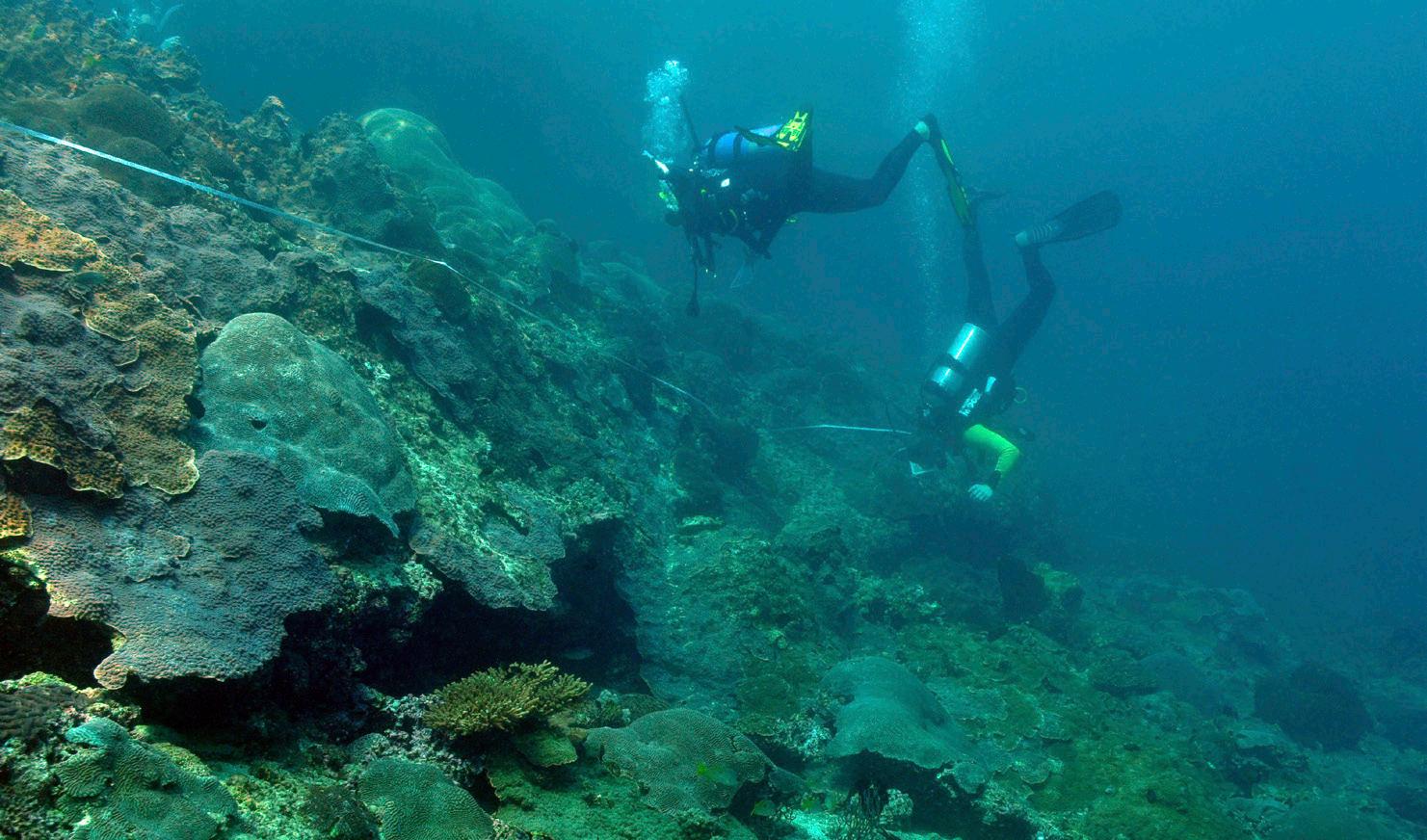
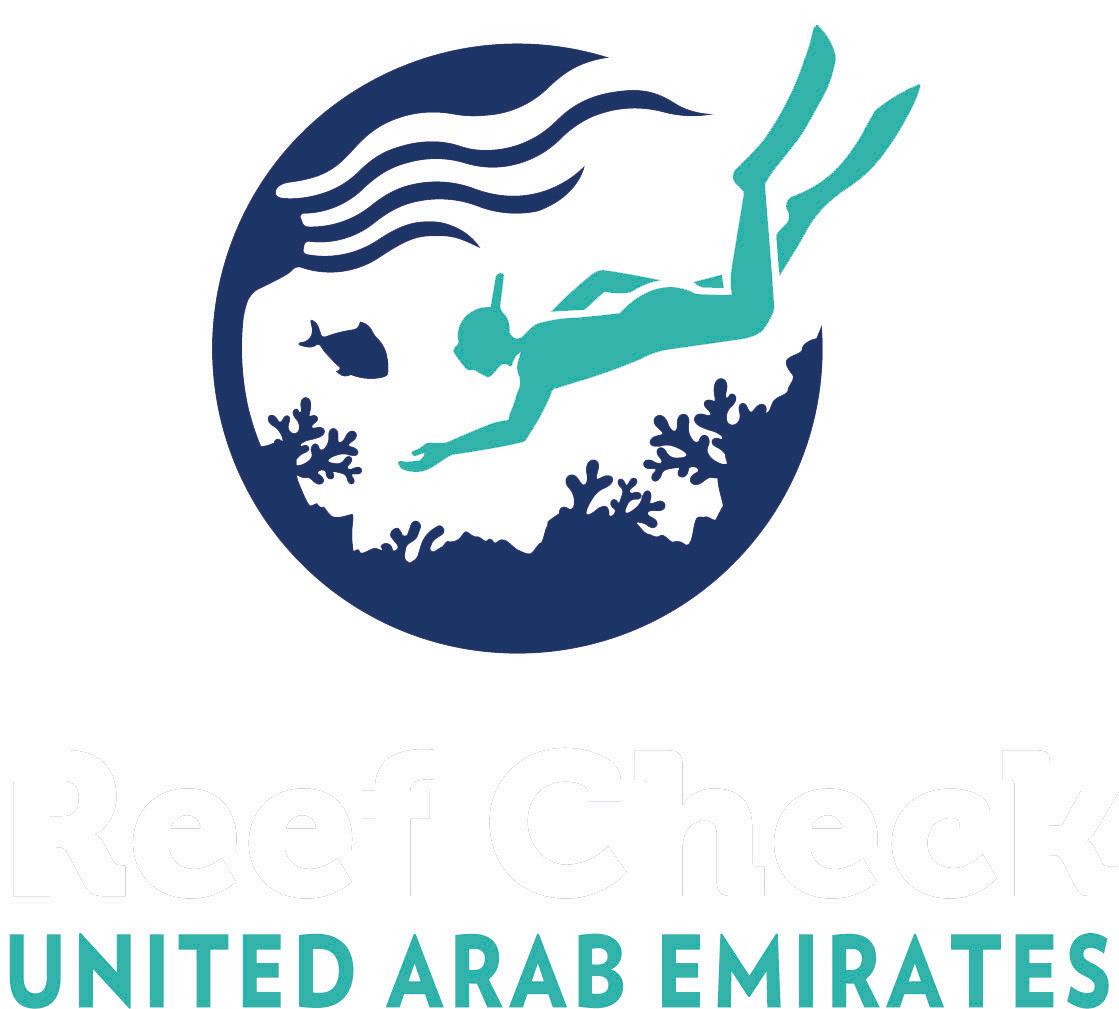
21 MARCH 2023 | DIVERS FOR THE ENVIRONMENT
WEBSITE:
EDA IS A NON-PROFIT NGO ACCREDITED BY UNEP AS AN INTERNATIONAL ENVIRONMENTAL ORGANISATION
www.emiratesdiving.com/events/reef-check
NEW KELP RESTORATION SITE IN BIG SUR, CALIFORNIA


 BY ANNIE BAUER-CIVIELLO, REEF CHECK DIRECTOR, RESTORATION PROGRAMME
BY ANNIE BAUER-CIVIELLO, REEF CHECK DIRECTOR, RESTORATION PROGRAMME
Big Sur is known for its lush canopies of kelp forests made up of giant kelp and bull kelp. It has substantial ecological and cultural significance to California and is rated among the top tourist destinations for outdoor activities. However, like other sites in California, recent Reef Check survey results show signs of kelp decline.
Since 2015, Reef Check has monitored eight sites across the Big Sur coast. When surveys began, purple urchin densities averaged less than one urchin per square metre. However, recent surveys conducted in 2022 show that urchin densities have increased to an average of about seven urchins per square metre.


In the last two years, a multiple of our longterm sites have reported over 20 urchins per square metre across transects. Urchin densities have been found to be highly variable and patchy. In addition, the overall average of giant kelp densities has shown a decline since 2015. This increase in urchin populations and decline of kelp has raised concern. It suggests the urgency of protecting some of the most pristine habitats on the California coast.

When a local community member of Big Sur indicated their concern for kelp forests, particularly at Big Sur Reef at a barren approximately 2.5 acres in size, Reef Check began surveying this site. Initial results identified urchin densities to average 22 urchins per square metre, with a complete loss of canopy kelp within the barren.What is unique about this site is that it is surrounded by relatively healthy kelp forest on all sides. We believe that this will assist with a faster recovery of the kelp forest.
In October, Reef Check partnered with commercial urchin divers to reduce urchin loads at the site. In 12 days, divers removed 6,000lbs of urchins, averaging 3.7cm (1.45 inches) in size. Divers have reduced urchin densities in the barren to less than a quarter of their densities before the intervention.
In the new year, Reef Check plans to use various restoration tools combined with ecosystem monitoring to understand how early intervention can improve restoration efficiency. We are looking forward to returning to this site in early spring to see the effects of the urchin removals. The learnings from
22 DIVERS FOR THE ENVIRONMENT | MARCH 2023 REEF CHECK
this project will improve our understanding of how early intervention may be scaled for restoration along the West Coast.
CHECK PROGRAMME
ST KITTS & NEVIS LAUNCHES SUMMER REEF
BY VALERIE GREGOIRE, REEF CHECK ST KITTS & NEVIS COORDINATOR
Last August, 10 students braved the summer heat and came to C.A.R.E. SKN at Oualie, Nevis in the Caribbean to start their Reef Check EcoDiver course. All students live on St Kitts and Nevis and some are native residents. Their ages ranged from 16 to 51 years old. The class was hosted by C.A.R.E. SKN, (Coral reef Assistance, Restoration & Education in St Kitts & Nevis), a newly registered NGO (2021) that started operations with a coral nursery pilot project in June 2022. For C.A.R.E. SKN, the Reef Check certification is a very important tool. It brings awareness to the community and the public and builds up a local team of “Reef Warriors” from the citizen scientists helping C.A.R.E. SKN with data collection.

The class was offered through snorkelling, not scuba diving, in order to reach a wider audience of the local community. Here in St Kitts and Nevis, 70% of the population does not know how to swim, and most of them are scared of the water. However, now there are more swimming programmes emerging and growing, therefore we have hope that we will continue in the future to have more candidates for our Reef Check programme.
Our class was held at the NASC (Nevis Aquatic and Sailing Center) at Oualie, Nevis, a local NGO that teaches sailing and aquatic activities. For NASC, the marine environment is vital and awareness and classes about the ocean are part of their goal, therefore C.A.R.E. SKN partners with NASC and offers marine biology classes to their students during their kid’s camp.
Our classroom was set up at NASC, outdoors underneath a shade while the in-water sessions were done at the breakwater in front of the Four Seasons Resort. St Kitts and Nevis does not have much direct reef access from the shore, but the breakwater did give us a good location to use for Reef Check.
With easy access, it’s shallow for snorkelling and we saw a lot of marine life, including a frogfish, stingray, spotted eagle ray, green turtle, barracudas, butterflyfish, grunts, parrotfish, porcupine fish, lobster, flounders, damselfish, and Acropora palmata, Millepora, Pseudodiploria and Porites species of coral.
We successfully certified 10 new Reef Check EcoDivers in substrate, invertebrates and fish.
We were also able to complete a survey at the end of the class. Eventually the breakwater will undergo coral restoration, so these surveys will be useful.
We had two local instructors and three instructors from the USA, which made our inwater class perfect with a ratio of two students to one instructor. To James Hewlett, Brooke Day and Marissa Hassevoort from the USA, a special thank you for coming down to Nevis and teaching our Reef Check class. Thank you as well to Vaughn Sturge from Nevis.
Our goal at C.A.R.E. SKN is to promote and offer a Reef Check every summer and we hope to be able to have two classes of 10 students each year.

23 MARCH 2023 | DIVERS FOR THE ENVIRONMENT REEF CHECK
REEF CHECK MALAYSIA’S EVENTFUL 2022
 BY REEF CHECK MALAYSIA
BY REEF CHECK MALAYSIA
It has been a most eventful year for Reef Check Malaysia, and the past three months have been no exception. We are most grateful for the support we have received throughout the year and humbled by the recognition we have received too.
In October, we had our first physical Annual Event for the first time since the pandemic. We had the opportunity to meet our funders, supporters and volunteers in person. It was a night to thank them, give an update on our programmes and discuss plans for the future.
We run a waste management programme and have a recycling centre on Mantanani Island, Sabah. The Mantanani Plastic Recycling Centre (MPRC) is where the waste collected is sorted
before being sent off the island to either the landfill or a recycling centre on the mainland.
Aligning with our goal to make it sustainable, we embarked on a solar installation project for the MPRC. In August 2022, the solar system was installed. The solar system covers both Reef Check Malaysia’s building areas, i.e. the recycling centre and the Virgin Coconut Oil (VCO) processing factory.

However, more was needed to power all of the machines. It was only sufficient to power fans, light bulbs, field offices, and several machines in the VCO building. In November, the solar system was upgraded, and it can now also power the Baler machine and the extruder machine used for recycling. This means that
the MPRC is now fully solar-powered!
We are also pleased to have signed a Memorandum of Understanding (MOU) with the Department of Fisheries Malaysia, representing the Government of Malaysia. The strategic partnership between DOF and Reef Check Malaysia has been ongoing for several years and has been carried out through multiple programme collaborations, particularly in Marine Parks. The MOU is essential to enable Reef Check Malaysia to continue its work to support the conservation of marine ecosystems in Malaysia.
It is hoped that the partnership will benefit all stakeholders involved and ensure a sustainable marine ecosystem.

24 DIVERS FOR THE ENVIRONMENT | MARCH 2023 REEF CHECK
EXPANDING PARTICIPATORY MANAGEMENT WITH REEF CHECK MALAYSIA
BY REEF CHECK MALAYSIA
• Reef Check Monitoring Surveys
• Coral Bleaching Surveys

• Crown of Thorns Monitoring/Removal
• Reef Clean-ups
• Rapid Response
• Liaison with Tourism Operators
• Snorkel Guide Training
• Assist in Marine Park organised Programmes
• Progress Reporting
Despite still being in its infancy in 2022, it has shown great potential, fostering good relationships between the local community, tourism operators as well as government agencies on the island. The Global Biodiversity Framework has also reiterated the importance of empowering and including the indigenous people and local communities (IPLCs) in the management of protecting biodiversity.
Reef Check Malaysia (RCM) believes in involving local communities to participate in the management of marine resources. A study in 2014 by RCM, based on 100 interviews within the local community on Tioman Island, revealed that the vast majority of respondents showed an interest in working for the Department of Marine Parks (DMPM – now Department of Fisheries, Malaysia). Thus, the Tioman Marine Conservation Group (TMCG) was born.
Members of TMCG were given training that was designed to empower them to undertake a variety of tasks that would normally be the responsibility of the Department of Fisheries, Malaysia (DoF). This provides members an opportunity to participate in the management of the Tioman Marine Park.
Now,TMCG is to undertake the following tasks:
• Mooring Buoy Monitoring/Maintenance
• Reef Rehabilitation Monitoring/Maintenance

Recognising the importance of participatory management, Reef Check Malaysia has extended participatory management at four new islands: Redang, Perhentian, Mabul and Semporna. The success of TMCG has encouraged this expansion and TMCG’s framework will act as a blueprint in the effort to extend participatory management on these four new islands.The work is already underway and we hope for an effective collaboration.

25 MARCH 2023 | DIVERS FOR THE ENVIRONMENT REEF CHECK
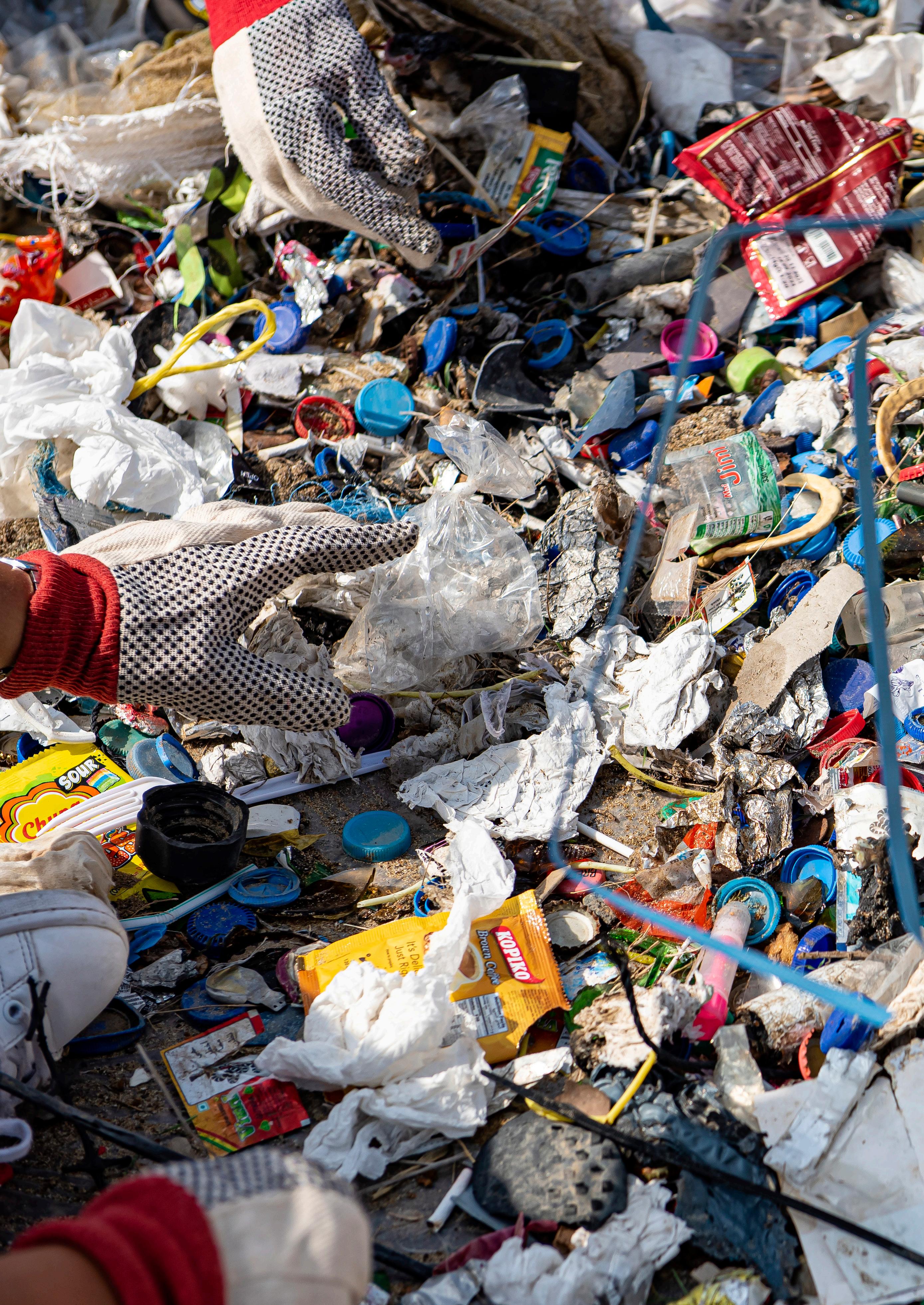
BCG’S 2023 BEACH CLEAN-UP
FEATURE AND PHOTOGRAPHY ALLY LANDES
We have seen a noticeable change over the years where we now collect much smaller and broken down items which beach visitors leave behind, and street cleaners ignore.
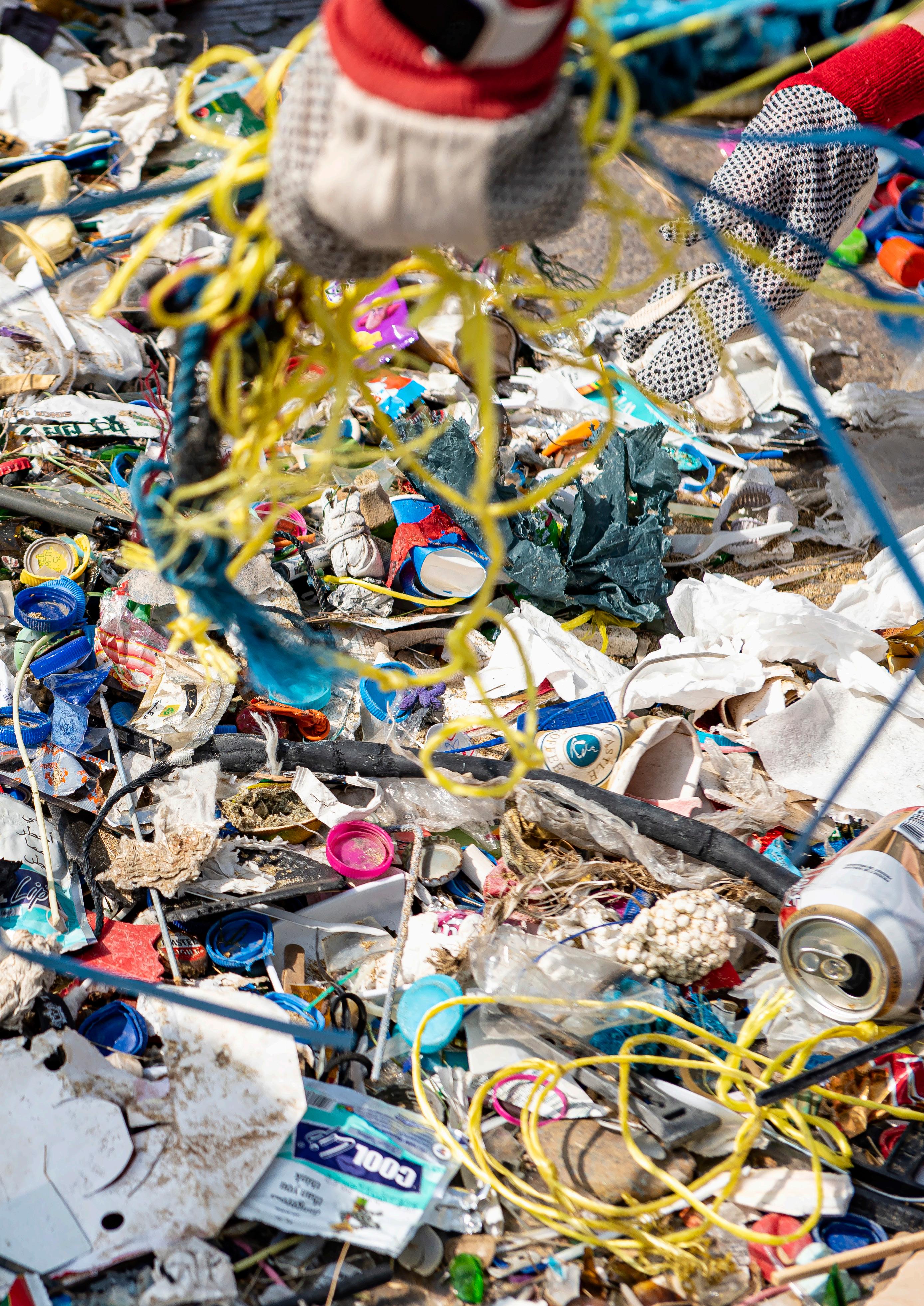
The Boston Consulting Group (BCG in the Middle East) did their regular annual beach clean-up with us on the 3rd of February as part of our Cleanup Arabia campaign, and their Community Service Day. The BCG team collected an impressive 30kg of rubbish in an hour and 15 minutes with 12 volunteers concentrating on collecting all the smaller items found on the beach grounds. The rest of the time was spent on the task of sorting out the items to count the individual materials found, and weigh the final results.

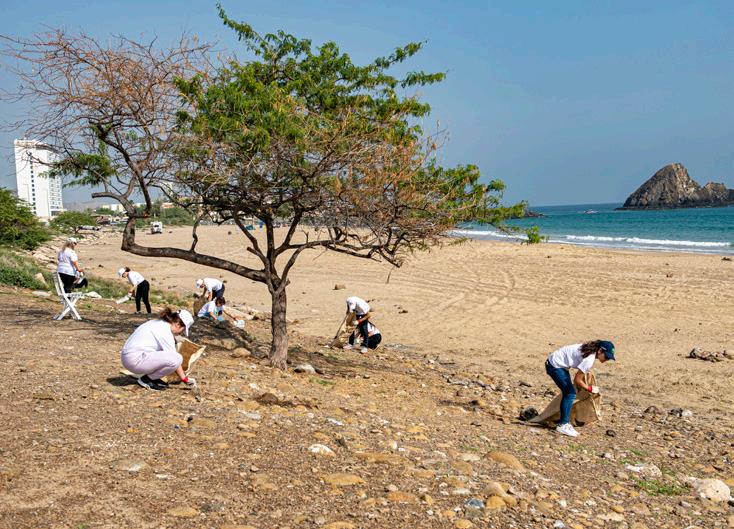

Their results have been shared to the International Coastal Cleanup’s Ocean Conservancy database, and added to EDA’s total weight collected by EDA members and partners through EDA’s Cleanup Arabia campaign since 1995. That figure now stands at 56,519.15kg.


We have seen a noticeable change over the years where we now collect much smaller and broken down items which beach visitors leave behind, and street cleaners ignore.
2kg of that rubbish was 3,681 cigarette butts!!!
Those have been handed over to Goumbook to their ‘Save the Butts – Waste to Value’ which is the first sustainability initiative run in the UAE that adopts a Circular Economy approach to environmental pollution, by recycling cigarette butts into valuable manufacturing material.

According to The World Health Organisation (WHO) and its published report – Tobacco and its Environmental Impact: “Cigarette butts have consistently comprised 30-40% of all items picked up in annual international coastal and urban clean-ups since the 1980s”.
For more information on ‘Save the Butts’, go to: www.goumbook.com/save-the-butts

28 DIVERS FOR THE ENVIRONMENT | MARCH 2023 FEATURES



29 MARCH 2023 | DIVERS FOR THE ENVIRONMENT FEATURES BEACH CLEAN-UP | DIBBA, FUJAIRAH Al Aqah Beach | 12 Adults MOST LIKELY TO FIND ITEMS TOTAL Grocery Bags (plastic) 9 Beverage Bottles (glass) 12 Beverage Bottles (plastic) 15 Beverage Cans 8 Bottle Caps (metal) 573 Bottle Caps (plastic) 285 Cigarette Butts 3,681 Cups, Plates (paper) 15 Cups, Plates (plastic) 183 Food Containers (plastic) 12 Food Wrappers (candy, chips, etc) 43 Lids (plastic) 17 Straws/Stirrers (plastic) 13 Utensils (plastic) 56 FISHING & BOATING Line, nets, traps, rope, etc 48 ILLEGAL DUMPING Construction Materials 1 PERSONAL HYGIENE Cotton Bud Sticks (swabs) 1 Syringes 2 OTHER ITEMS/DEBRIS Clothing 1 Electronic Waste (phones, batteries) 4 Footwear (shoes/slippers) 1 Tobacco Products (lighters, wrap) 12 Toys 3 Other Plastic Waste 23 Other Waste (metal, paper, etc) 11 TINY TRASH LESS THAN 2.5CM Plastic/Foam Pieces 780 OTHER ITEMS NOT LISTED Plastic Playing Cards 10 Broken Glass 487 BBQ Metal Tongs 1 GRAND TOTAL OF ITEMS 6,308 TOTAL BAGS COLLECTED 3 TOTAL WEIGHT (KG) 30
AN UNDERWATER CLEAN-UP WITH DUBAI CREEK RESORT & MARINA


Our divers did an amazing job with the day’s limited underwater visibility, managing to bring up 696 items weighing in at 302.5kg!
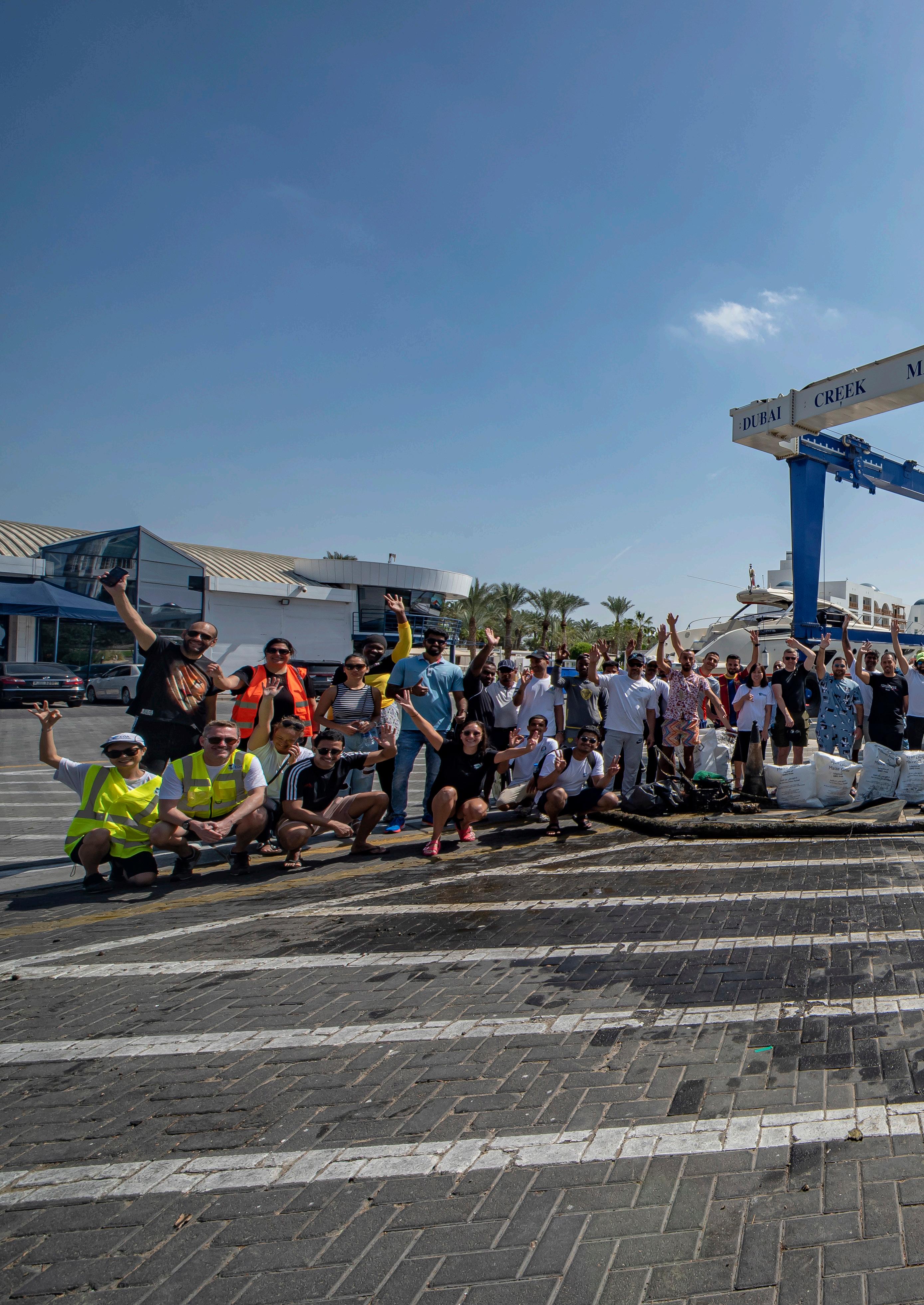
FEATURE AND PHOTOGRAPHY ALLY LANDES
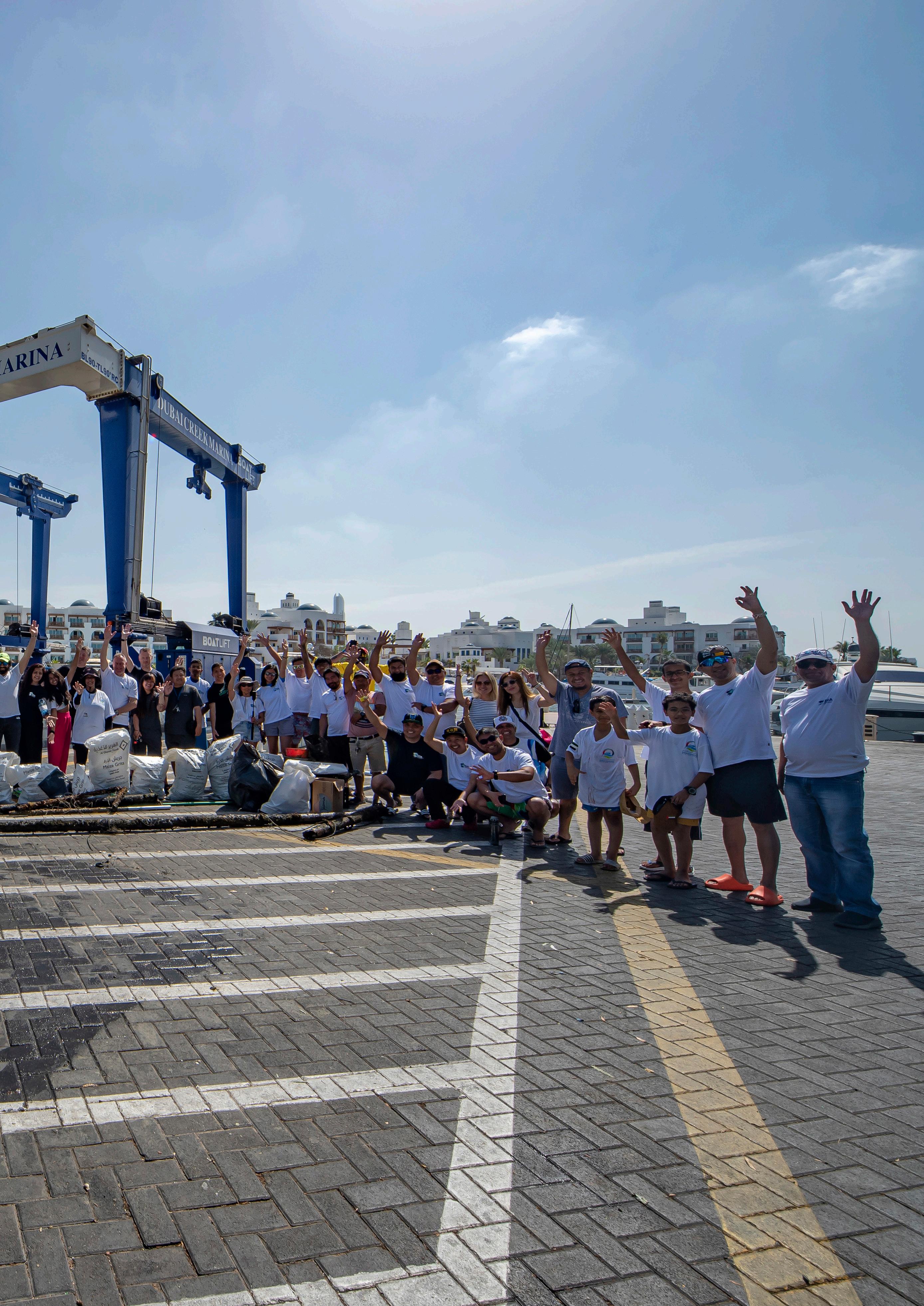

INSPIRING PEOPLE TO CARE FOR OUR OCEANS SINCE 1995

We had such a fantastic turnout on Saturday the 18th of February for our Cleanup Arabia Dubai Creek Marina dive with Dubai Creek Resort. Divers Down and Al Boom Diving provided the event’s tank and weights.

The event was fully booked for 68 divers. There were 2 informed cancellations, 53 divers checked in at the morning’s scheduled registration – 5 couldn’t dive due to sinus issues, but they came to volunteer as surface support – making it a total of 48 divers taking part. Our divers did an amazing job with the
day’s limited underwater visibility, managing to bring up 696 items weighing in at 302.5kg! The most collected item were plastic bags, followed by plastic cups, plates, and food containers.



EDA’s Reef Check Trainer, Rania Shawki Mostafa made sure to carefully collect the small marine life that was found hiding in some of the marine debris with our younger volunteers and they were put back into the marina. They included little crabs, snails and small starfish. It was a super fun day with outstanding teamwork by all.
A huge shout out to the 14 support volunteers from the Dubai Voluntary Dive Team for all the dedication they provided with registration and surface logistics. The kayakers were an asset to our divers as marine debris collection points and handing out spare mesh bags when needed, as well as providing drinking water.
We want to thank Dubai Creek Resort for providing our eco warriors with a lunch buffet at the Casa de Tapas at the end of the activity, and for making the event such a success.
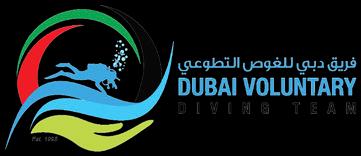
32 DIVERS FOR THE ENVIRONMENT | MARCH 2023 FEATURES
18 FEBRUARY 2023 | WWW.EMIRATESDIVING.COM
PARTNERS: EVENT ORGANISER: CLEAN-UP PARTNER: VOLUNTARY PARTNER:
EVENT


















MARCH 2023 | FEATURES

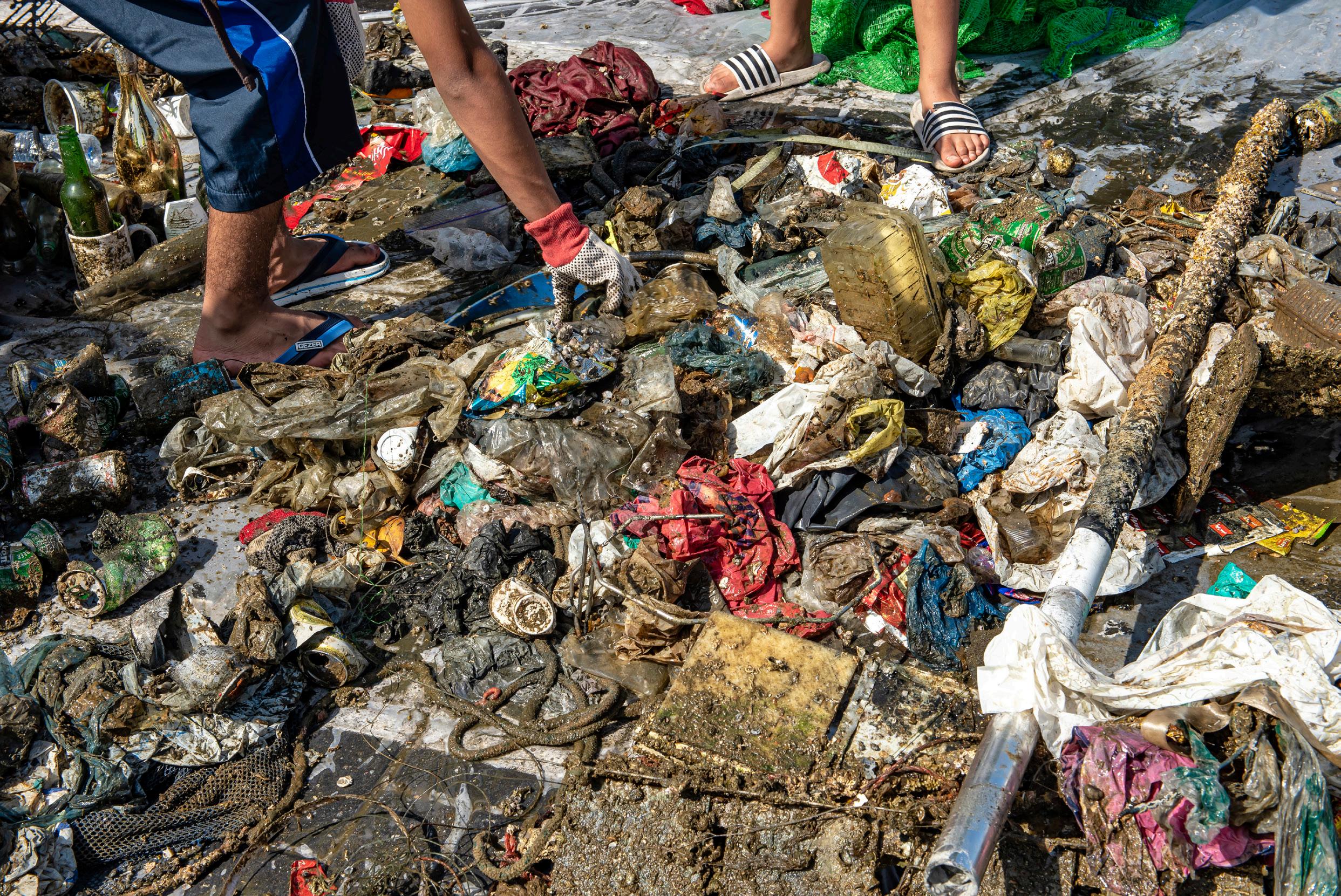

FEATURES

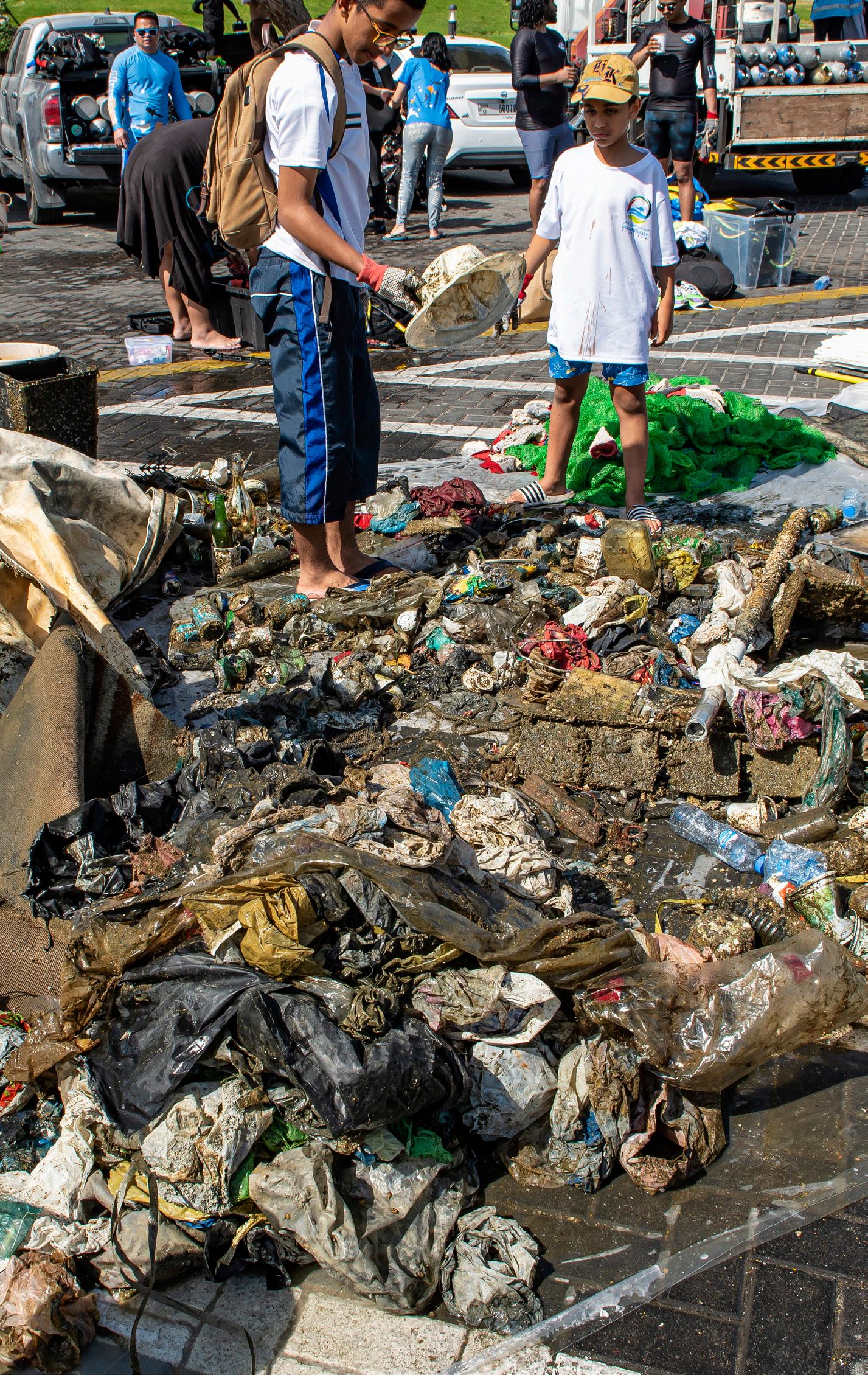

35 MARCH 2023 | DIVERS FOR THE ENVIRONMENT FEATURES DUBAI CREEK RESORT DIVE CLEAN-UP Dubai Creek Marina | 48 Divers MOST LIKELY TO FIND ITEMS TOTAL Grocery Bags (plastic) 20 Other Bags (plastic) 344 Beverage Bottles (glass) 27 Beverage Bottles (plastic) 47 Beverage Cans 25 Bottle Caps (metal) 1 Cups, Plates (plastic) 46 Food Containers (plastic) 69 Food Wrappers (candy, chips, etc) 17 FISHING & BOATING Line, Nets, Traps, Ropes, etc. 23 ILLEGAL DUMPING Construction Materials 15 PERSONAL HYGIENE Gloves & Masks (PPE) 1 OTHER ITEMS/DEBRIS Clothing 14 Electronic Waste (phones, batteries) 1 Other Plastic Waste 20 Other Waste (metal) 2 PERSONAL HYGIENE Mask (PPE) 1 OTHER ITEMS NOT LISTED Plastic Razor 1 Carpet 2 Plastic Boat Cover 1 Bricks 4 Traffic Cone 1 Plastic Crates and Buckets 11 Anchor 1 Hammer 1 Sunglasses 1 GRAND TOTAL OF ITEMS 696 TOTAL BAGS COLLECTED 17 TOTAL WEIGHT (KG) 302.5

NEMO’S GARDEN
COULD DIVERS BECOME THE FUTURE’S FARMERS?

FEATURE ALLY LANDES PHOTOGRAPHY OCEANREEFGROUP & NEMO’S GARDEN BY OCEAN
REEF
Imagine cultivating food crops underwater. Well, the concept was born in 2012 off the coast of Noli, Italy behind the mastermind Sergio Gamberini, founder of the OceanReefGroup. A passionate diver with another strong passion in gardening married both topics in conversations with friends. There are regions in the world not ideal for agriculture, but what about coastal areas, or countries with other bodies of fresh water? So, he asked the question, “Why not try to grow basil underwater?” And thus, the experiment began.
Imagine cultivating food crops underwater.Well, the concept was born in 2012 off the coast of Noli, Italy behind the mastermind Sergio Gamberini, founder of the OceanReefGroup. A passionate diver with another strong passion in gardening married both topics in conversations with friends.There are regions in the world not ideal for agriculture, but what about coastal areas, or countries with other bodies of fresh water? So, he asked the question, “Why not try to grow basil underwater?” And thus, the experiment began.


As an innovative entrepreneur, Gamberini invested his own funds into the start-up after some initial research, and with the help of his team at Ocean Reef, six 20-foot transparent biospheres were sunk to the bottom of the sea, filled with approximately 2,000 litres of air, and are fixed at different depths, between 5 and 10 metres. The diving farmers have a step grid in which they are able to stand up and have half their bodies inside the pods while they tend to the crops, while the other half of their bodies are out.
The goal behind the project is to be selfsustainable, with an eco-friendly alternative form of agriculture, and to be economically viable. With the use of renewable energy from the sun and fresh water obtained by desalinating seawater, the microclimatic and thermal conditions inside the biospheres are the optimal environments for crop growth. No soil is used, it is instead a hydroponic culture in which the plants are grown in a controlled environment using nutrient-rich solution to deliver water and minerals to their roots.
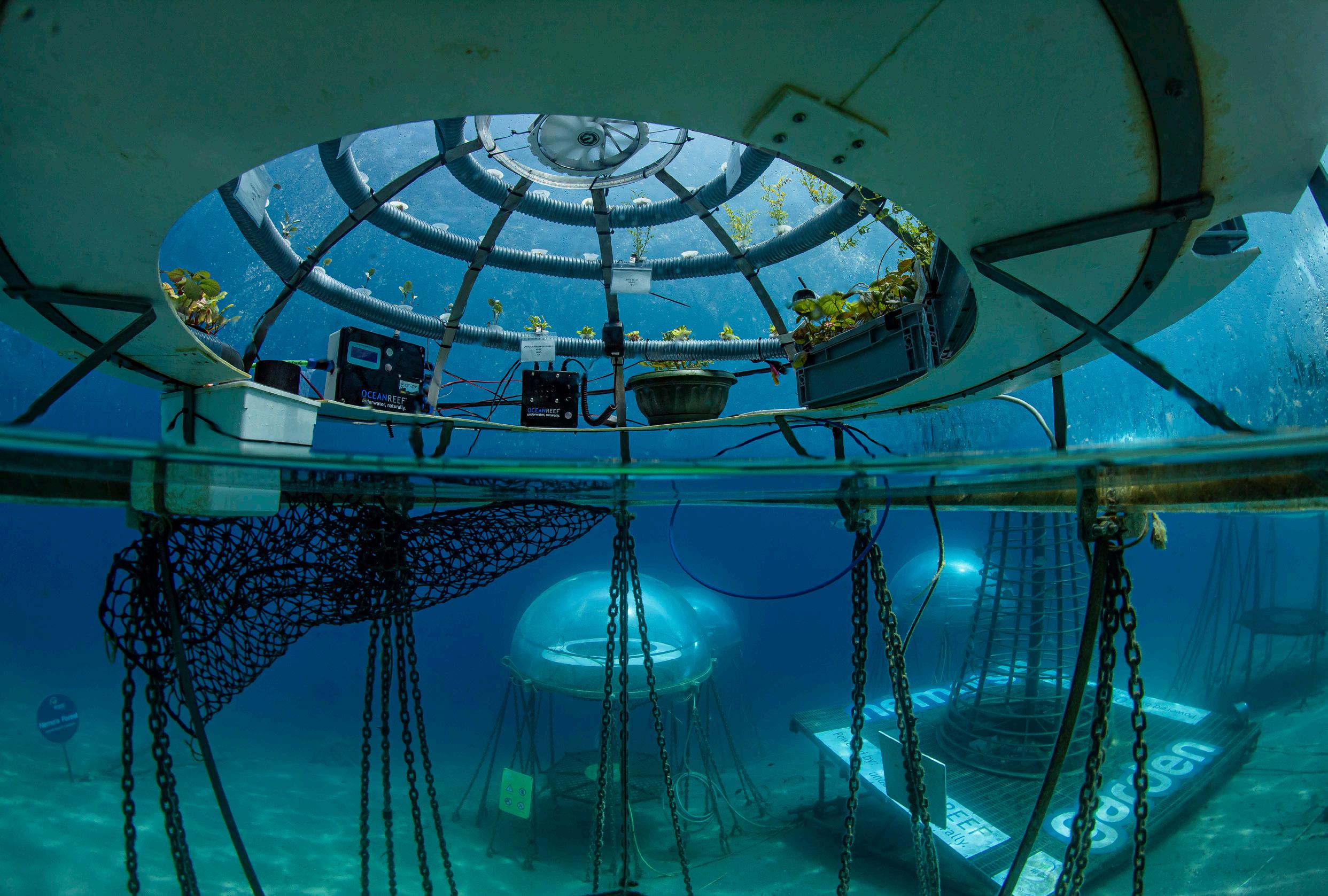
38 DIVERS FOR THE ENVIRONMENT | MARCH 2023 FEATURES
With the difference in temperatures of the air inside the pod, and that of the water around it, water at the bottom of the biosphere evaporates to easily condensate to the internal surface area sustaining the growing crops. Each biosphere is equipped with sensors for CO2, O2, humidity, air temperature and sunlight. The external water temperature is regularly checked at both the shallower and deeper biospheres through a control tower equipped with 5 monitors and a laptop that enables the team to also communicate with each other
through an intercom. It is the near-constant sea temperature between day and night that creates the ideal growing conditions for the crops. With the setup devised, there is no need for LED lighting, power, or temperature regulating tools that are used in regular greenhouse systems on land.
Basil was the first crop grown, and by 2015 they had produced green basil and red basil, a variety of 4 different salads, tomatoes, courgettes, green beans, peas, 5 other herbs,
flowers, aloe vera, and mushrooms to name just a few in the ongoing experimental process. Through trial and error, the biospheres were upgraded, and their number increased, thus resulting in today’s successful underwater habitats. There are now over 100 different fruits, vegetables, herbs, and flowers being grown in this underwater odyssey.
The project has been picked up by other companies in the interest of science to see what plants grown underwater could unveil



39 MARCH 2023 | DIVERS FOR THE ENVIRONMENT FEATURES
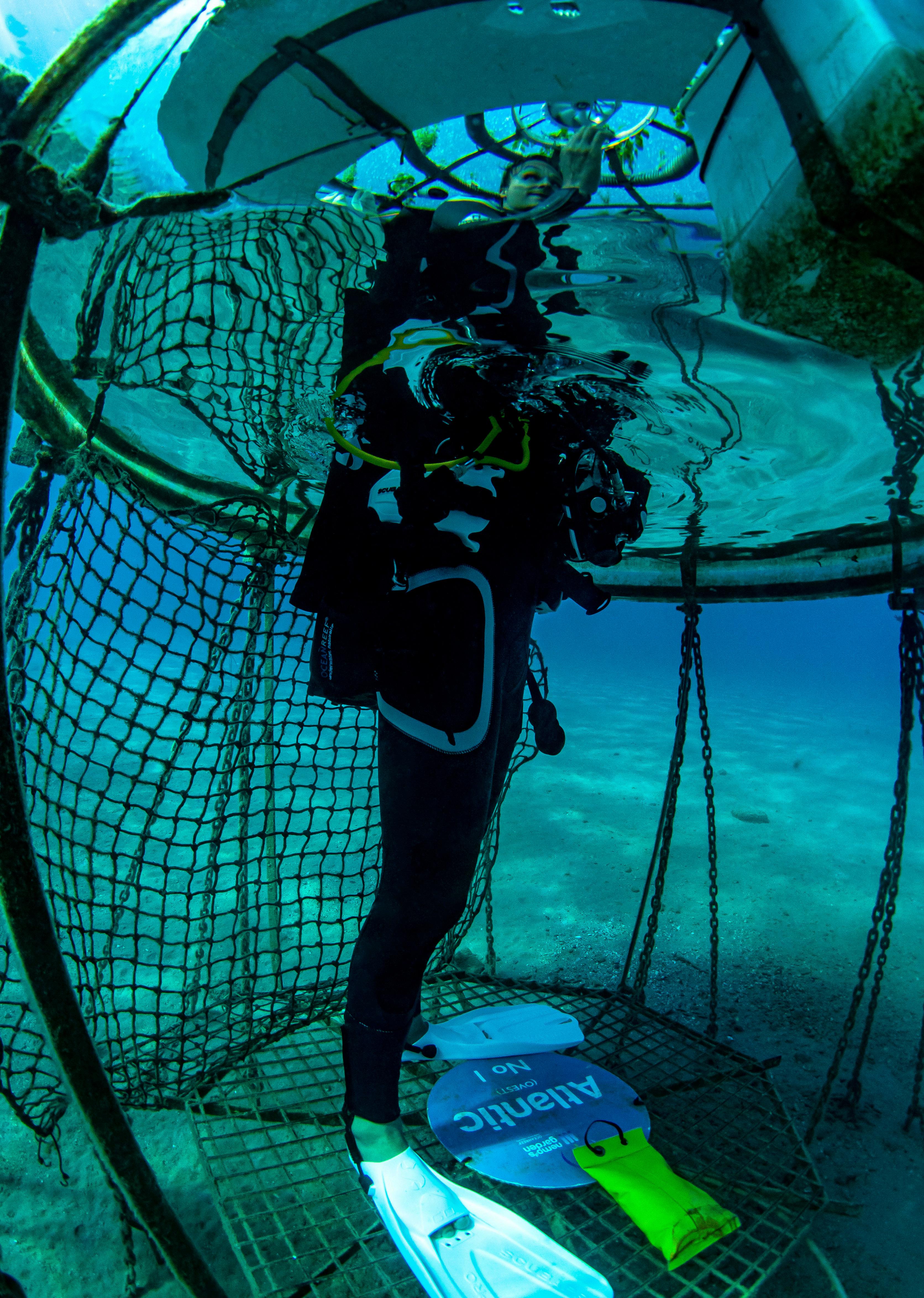
FEATURES
for the future. Plants have been grown in experiments for cosmetics and pharmaceutical products, turning them into underwater labs, as well as looking into other possible uses for the biospheres toward eco-tourism, fish farming, seaweed farming, and more.
This underwater greenhouse project could solve the issue of pesticides. The closed ecosystem within the biospheres is protected from parasites, eliminating the use of these

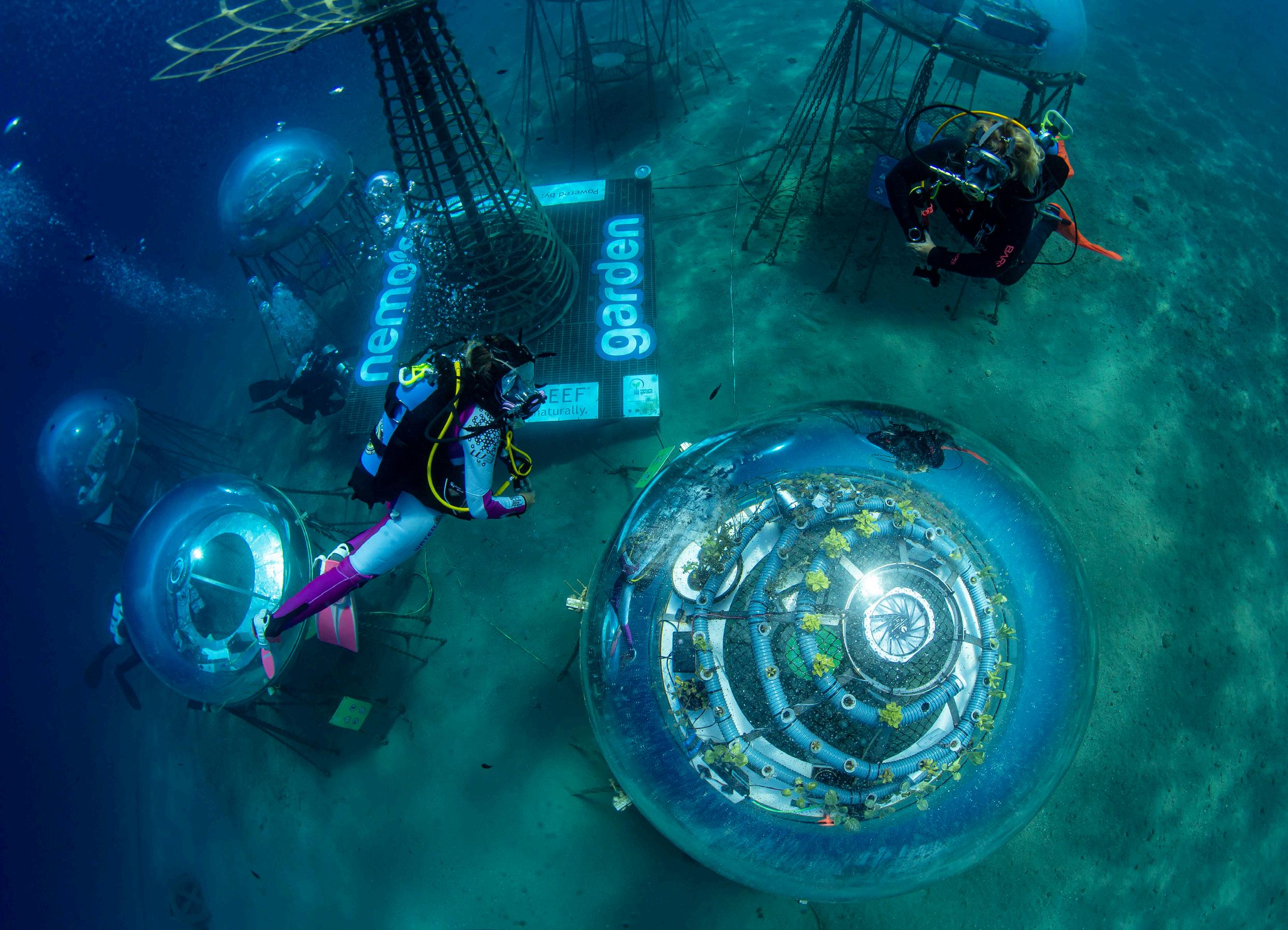

chemicals to run a strict ecological environment with the seawater, causing no disruption to the ecosystem. A natural product is used to supply the plants with the nutrients that are essential to their growth, but further research is being done on the possibilities of producing natural fertilisers from algae found directly in the sea where future farms will be installed.
In 2021, Nemo’s Garden partnered with Siemens, one of the world’s leading technology
companies, who are providing support, studying, modelling, and improving the technology of Nemo’s Garden and finalising its industrialisation as a sustainable food alternative for the world.
Progress on this collaboration will be shared on NG’s website. If you would like to learn more about the project, further info can be found on www.nemosgarden.com
41 MARCH 2023 | DIVERS FOR THE ENVIRONMENT FEATURES
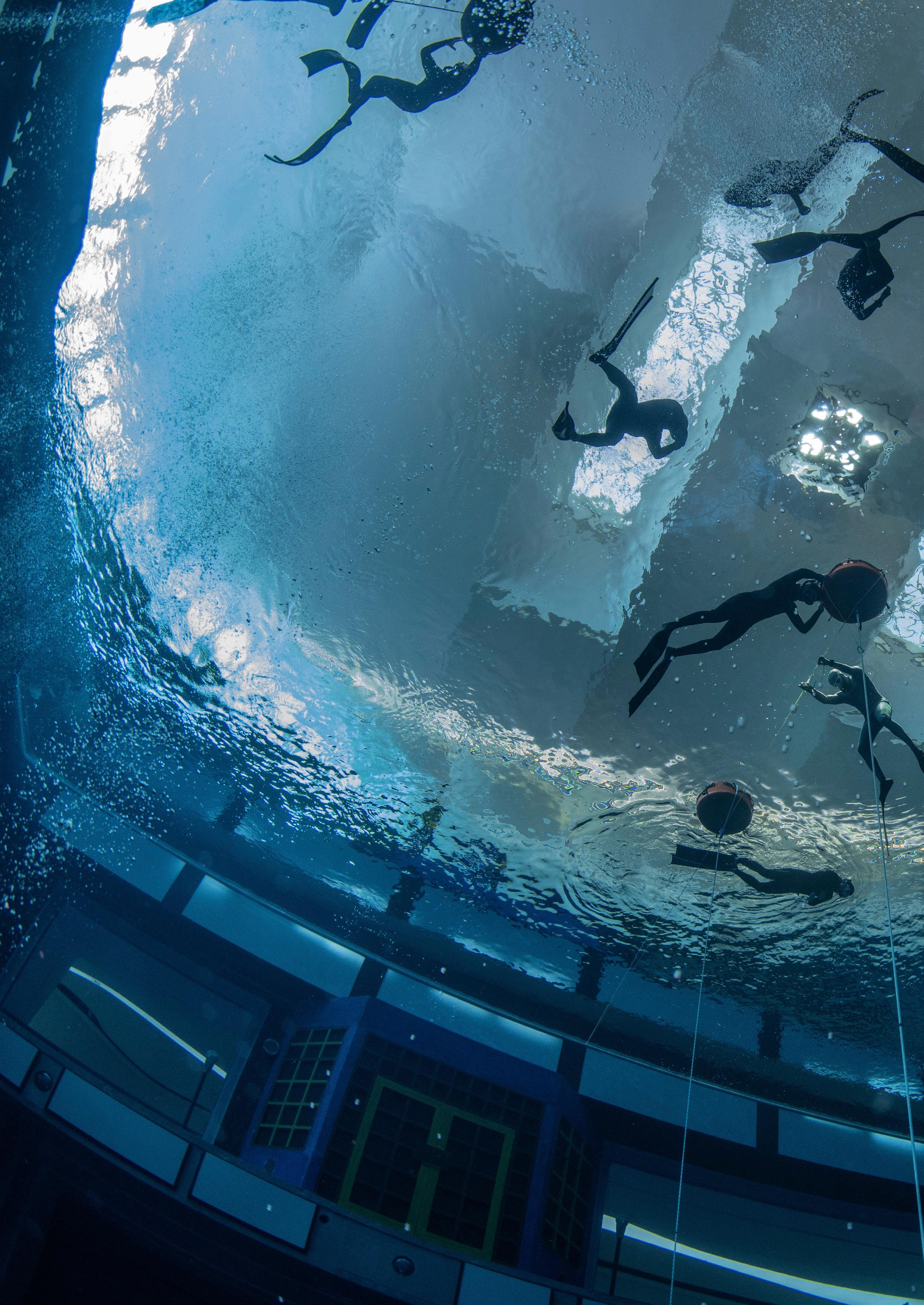
HOLD YOUR BREATH – WITHOUT STRESS
Deep Dive Dubai is a paradise for freedivers. You will find a water temperature of 30°C, no waves, no currents, and infinite visibility at all times, and it’s right in the middle of a metropolis. It now becomes convenient to fit your freediving training into your weekly schedule
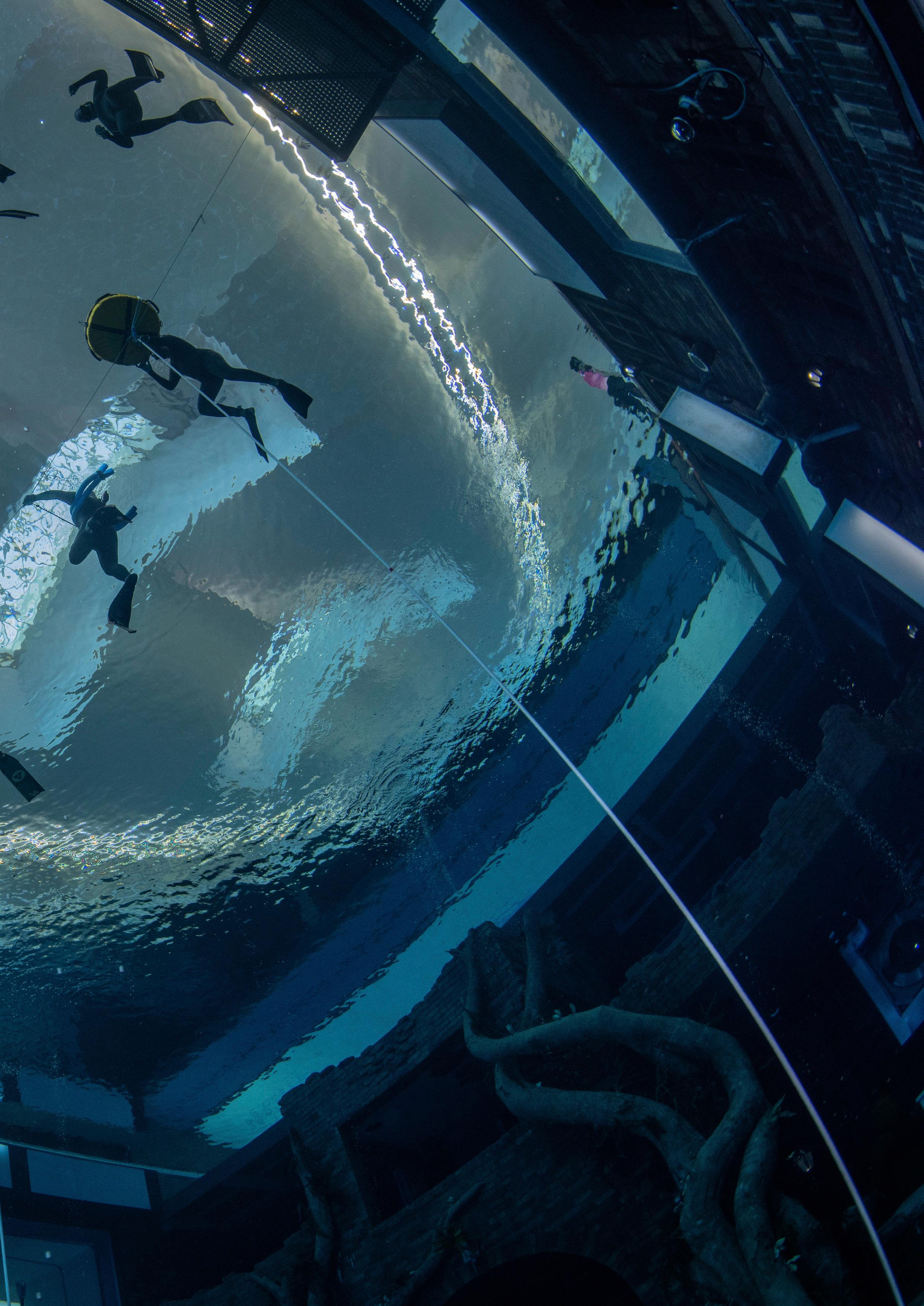
FEATURE GASPARD GARRY-GENDRE PHOTOGRAPHY JESPER KJØLLER & MIKE RALL – BASE FILMS
COVER PHOTO: Deep Dive Dubai by Jesper Kjøller.
If you are a scuba diver, you were told never to hold your breath on the first day of your entrylevel course. And you might be reluctant to try freediving. But learning proper breath-hold techniques will provide you with a whole new outlook on freediving and liberate you from the weight of the tanks. Deep Dive Dubai’s resident freediving instructor extraordinaire, Frenchman Gaspard Garry-Gendre, shares his secrets of stress-free breath-hold.

Imagine being five metres underwater on a single breath and staying there for a bit without scuba tanks. Imagine now that instead of using all your mental power to manage this stressful situation, you have a relaxed experience. You do not feel the need to breathe, gravity is cancelled, and a pleasant silence surrounds you. Temporarily, you just belong. You are rediscovering your love of the water.
Maybe it sounds crazy, but most people can achieve this result in just two hours if they are already comfortable in the water.The beauty of it, is that the learning process doesn’t have to be particularly challenging as long as the teaching methodology focuses on a stress-removal approach. At the recreational level, freediving requires very little physical adaptation, and relaxation can do a tremendous job for you. But how can you remove stress in freediving?
To achieve relaxation, we need to divide our final goal into smaller parts that will make up the components of our experience.
For beginners, we can identify those parts as the following:
1. Breath-hold technique
2. Understanding breath-hold anxiety on land
3. Understanding breath-hold anxiety in the water
The goal is to now work on those parts in that order.
BREATH-HOLD TECHNIQUE
There are different ways to perform a breathhold. If you use the wrong muscles or too much unnecessary energy, the act of holding your breath will be uncomfortable by itself and generate stress from the very beginning of your breath-hold. Holding your breath with the wrong muscles can also create subsequent equalisation issues when it is time to go down. Developing a good breath-hold technique is not challenging at all, and several breathholds of a maximum of three seconds with a competent instructor will help you figure it out.
BREATH-HOLD ANXIETY ON LAND
Once you find a good breath-hold technique in the previous step, the newly gained comfort will start to build up your confidence.
Yet, we must acknowledge that holding our breath is not normal or natural initially: we are land creatures, and for a vast majority of us, we did not grow up doing such a thing. To work on breath-hold anxiety, we must realise that more is not better. Instead of holding your breath to
your limits, making repetitions of short breath holds (20 seconds) can have a big impact on your mental comfort. Keep the same duration every time, and observe if it becomes easier and easier. If that’s the case, it is primarily because the anxiety is slowly disappearing.
BREATH-HOLD ANXIETY IN THE WATER
Holding our breath on land is one thing, but of course, doing the same in the water creates another level of anxiety at first. Here again, performing repetition of easy to very easy breath holds will guarantee an enjoyable physical and mental experience. The positive experience of your dive will be key to removing anxiety, developing confidence, and achieving relaxation.
This learning process, despite not being challenging, should be made with an instructor who can make sure that all your breath holds are being performed with a high level of quality. The main thing that can slow down or stop your progression in freediving is to look for short-term results by exposing yourself repetitively to a non-sustainable level of stimulation: patience and little steps with repetitions usually goes way faster and further.
ADAPTATION
Even if it is possible to skip those building blocks to achieve the same end result, following them will guarantee adaptation. When we are adapted to something, it means that it feels natural, and we are not using mental power
44 DIVERS FOR THE ENVIRONMENT | MARCH 2023 FEATURES
ABOVE: Georgio’s Wreck by Mike Rall/BASE Films. OPPOSITE PAGE: Deep Dive Dubai freediving instructors having fun between courses, by Jesper Kjøller.
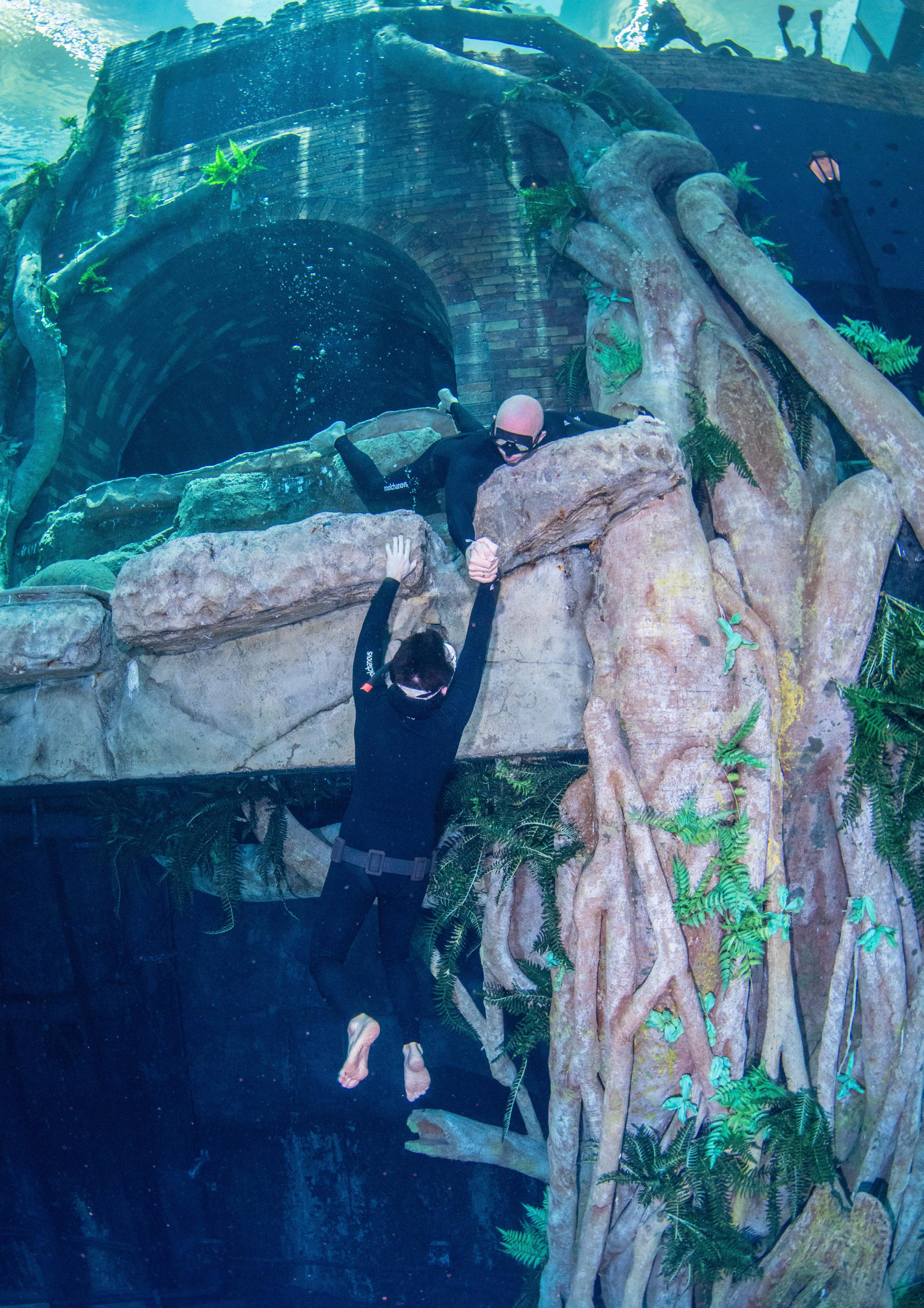
FEATURES
to do it. A typical example that many of us are familiar with is driving a car: Imagine that you arrive in a new country, and you need to drive daily from point A to point B. In the beginning, it will require a lot of focus, and you might feel slightly tired once you arrive at your destination. But after a few days or weeks, navigation will become second nature, and you will be able to keep the same driving quality while conversing with your passenger. From an external point of view, those two situations might look the same. A car being driven correctly from point A to point B, but for you as the driver, there is a big difference in terms of comfort and relaxation. This difference is adaptation, and it is what we generally seek in freediving training (at any level).
THE WORLD OF FREEDIVING

Once you start to enjoy holding your breath in the water, a whole new world opens itself. The term freediving covers a very wide range of activities. Explore the sea, lakes, a quarry, or deep pools in a single breath, act as an underwater model or photographer, hold your breath floating at the surface, go for depth, play chess underwater, play with dolphins or whale sharks, take part in marine conservation
programmes, or simply practice laps in a swimming pool. There is an infinite number of ways to use your breath-hold skills. The entry to all those activities is a freediving course. Like in scuba diving, different organisations can get you certified, and they usually have more similarities than differences. What will make the biggest difference is mainly the instructor. In a freediving course you will develop efficient techniques that will make your dives easier, smoother, and longer. You will practice freediving as a sport. But recreationally, it means diving well within your limits.
Most importantly, you will learn about safety. There are different levels of safety in freediving, and the first level is yourself! A course will guarantee that you learn and maintain good habits in your own diving. Did you know that, for example, we never dive with a snorkel in the mouth?
You will also learn and practice rescue techniques for different situations. Yes, from your first course, you get taught how to save your buddy from a hypoxic state, and the beauty of it is, the way you learn it in a beginner course, is the same way professional safety
divers do it in international competitions.
A SOCIAL ACTIVITY
The golden rule of freediving is never freedive alone, which means you should always have a buddy who has also taken a freediving course, and knows how to react in case of an incident. Far from being a constraint, this rule actually makes freediving even more fun and enjoyable. During your freediving journey, and when travelling to different freediving destinations, you will meet plenty of buddies who will become lifelong friends. The freediving community is small enough to include all profiles of freedivers. In popular freediving destinations such as Dahab in Egypt, it is common to meet world-class athletes along with someone who just took the first course and is excited about the journey ahead.
Usually, the biggest gathering of freedivers is during competitions. Here you will meet not only the athletes but, also judges, coaches, friends coming to support their friends, safety divers, and curious spectators and fans who just want to watch. Believe it or not, many freedivers are not usually competitors at freediving competitions.
46 DIVERS FOR THE ENVIRONMENT | MARCH 2023 FEATURES
ABOVE: Shushah Island by Mike Rall/BASE Films.
DEEP DIVE DUBAI, A PARADISE FOR FREEDIVING DEVELOPMENT



Despite being a sport accessible to anyone comfortable in the water, good conditions for learning and training to freedive are rare in our world. Usually, we seek accessible depth close to the shore to avoid long boat rides. But that’s not all. Freedivers are also very sensitive to sea conditions. A big wave just before you take your last breath can have a huge negative impact on relaxation. The same happens if the water is too cold and you start shivering. We can also mention thermoclines (sudden shifts in temperature) which can create a big shock while going down smoothly. Finally, having good visibility in the water is a huge advantage in terms of safety and enjoyment. Even if they dive on a single breath to depths that can sometimes seem crazy from an external point of view, freedivers actually really appreciate comfort and can be particularly picky when it comes to diving conditions.
There are destinations around the world that meet these criteria. The Red Sea and more specifically, Dahab in Egypt is known as the Mecca of freediving. The Philippines, with its thousands of islands, is also a very popular freediving destination. On the bucket list, you will also find Mexico and the cenotes. Finally,
places like the Caribbean, Greece, Cyprus, and Bali are popular amongst freedivers.
Yet, if you get hooked on freediving, those destinations are usually far from home, and travelling there for more than two weeks will not fit everyone’s lifestyle.
Therefore, Deep Dive Dubai is a paradise for freedivers. You will find a water temperature of 30°C, no waves, no currents, and infinite visibility at all times, and it’s right in the middle of a metropolis. It now becomes convenient to fit your freediving training into your weekly schedule, and on top of it, you get the comfort of a premium facility with bathrobes, showers, an equipment shop, and a restaurant as soon as you exit the water.
Of course, freediving in the ocean has a magic that a pool can never replace, but be sure that with consistent and regular training, your skills, comfort, confidence, and performances will transfer very well to any kind of underwater breath-hold activity you might want to take part of during your holidays. You will enjoy the ocean and its wonders on a whole new level!
Get more information and book at: www.deepdivedubai.com
TESTIMONIAL ZEBA MOOPEN – FREEDIVING TRAINEE
Training with Gaspard at Deep Dive Dubai has changed the game of freediving for me. Fairly new to the sport and freshly certified, I booked my first session out of curiosity more than anything else. What I did not anticipate was the paradigm shift I got when freediving with Gaspard’s training technique. A sport I had touted as meant for those with natural ability suddenly seemed accessible to me as someone who had never identified as a natural athlete.
Gaspard’s focus on technique, down to the smallest detail, without focusing on trying to get the ‘next milestone depth’ was different from what I had encountered with other freediving instructors who pushed hard on depth, to the point of extreme discomfort (which I assumed was part of the sport). Within a few sessions, I was able to see the method work – reaching depths I struggled to get to previously with unexpected ease and enjoyment!
Training in the conditions at Deep Dive Dubai is also a dream. The lack of current, access to depth, and amazing visibility (and the whale soundtrack in the background) make it a conducive environment to focus on technique and progress. I am so grateful I took a chance with Deep Dive Dubai and Gaspard, as I’ve reaped the benefits of it immensely!
As a scuba diver with a decade before trying freediving, I had always assumed that my interactions with marine life would be best supported by scuba and the ease associated with it. That belief came under heavy scrutiny a few months into freediving at Deep Dive Dubai
I had booked a trip with shark enthusiast and conservationist, Ocean Ramsey to scuba and freedive with tiger sharks in Fuvahmulah in the Maldives. I was pleasantly surprised by how much my freediving training had translated to the ocean, giving me confidence, helping me relax, and really enjoying my interactions with these beautiful apex predators on a single breath. I had never thought I’d be able to bypass my dependency on the reliable – but cumbersome equipment of scuba – and have truly ‘free’ interactions with the sharks like I did. It changed my perception of freediving as only a competitive sport involving you and a line (though there is so much beauty to be unlocked there, too), to a skill that I was equipping myself with for meaningful interactions in the wild.
47 MARCH 2023 | DIVERS FOR THE ENVIRONMENT FEATURES
ABOVE: Gaspard Garry-Gendre; the DDD pool; Gaspard & Zeba Moopen during training. Photos by Jesper Kjøller.
DUBAI’S UNDERWATER HIDDEN SECRETS
FEATURE GORDON T SMITH
Whilst this type of diving may not be everyone’s “cup of tea”, it can provide good training for navigation, buoyancy control, and a good practice area for photography, plus there are no boat schedules.
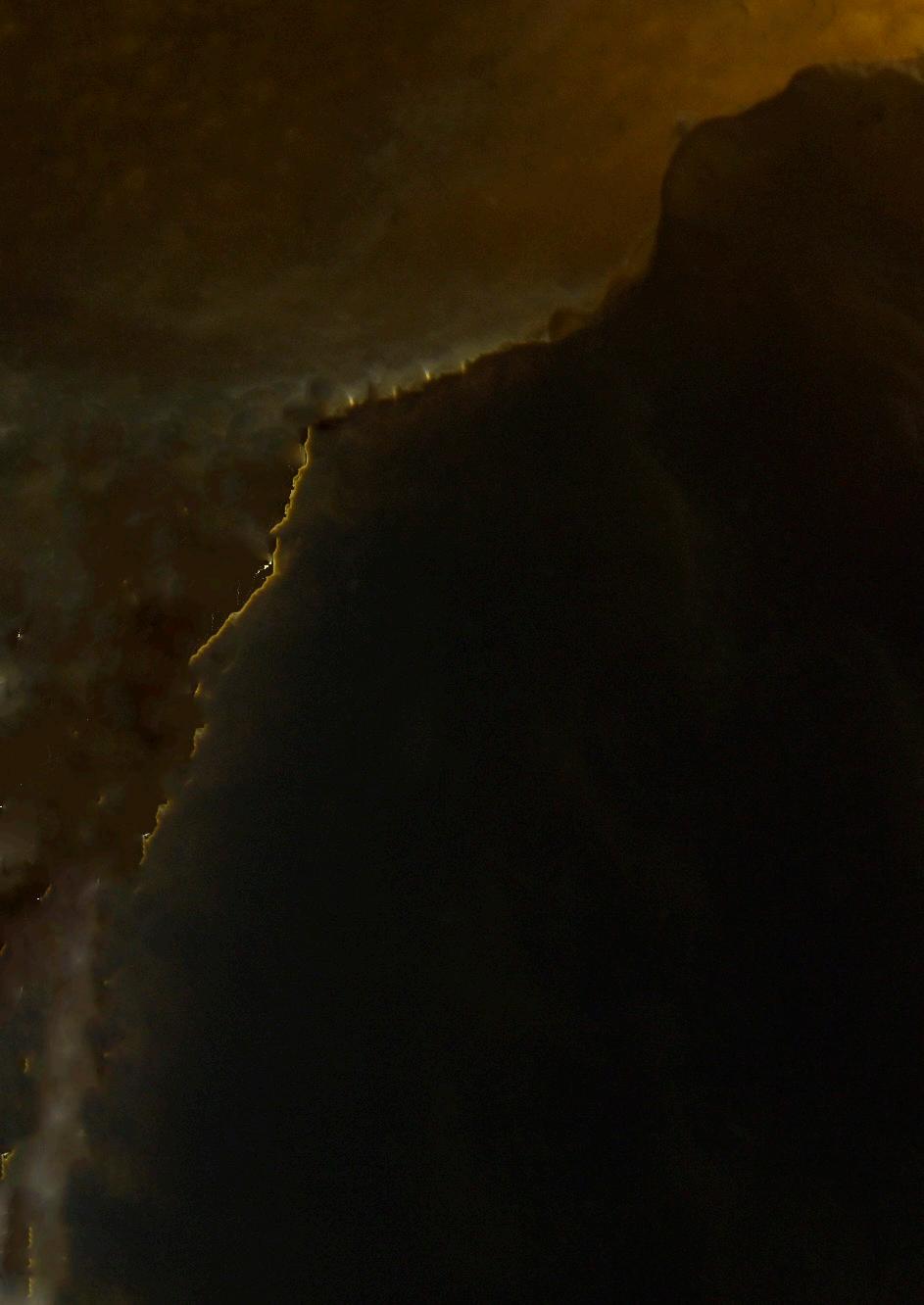 COVER PHOTO: Hippocampus kuda
COVER PHOTO: Hippocampus kuda

When I first arrived in Dubai back in 1997, I was rather disappointed regarding the lack of shore diving compared to where I lived in Jeddah and diving the Red Sea.
I had heard about a reef off Jebel Ali, but I had no reference of where to dive and was still establishing where to dive. Practically all of the west coast dive sites require a boat for access, and I didn’t have enough information, and a lack of dive buddies didn’t help. Remember, this was really before the internet took off, and most information was by word of mouth, usually talking to people at the dive shop, which in my case was Scuba Dubai at the Trade Centre Apartments.
Over the years, I occasionally did a shore dive because I was involved in a training dive or wanted to test some equipment in salt water rather than a fresh water pool, and I rarely saw anything worth noting.These dives were usually off “Russian” beach in Jumeirah. The onset of
the offshore island construction destroyed any decent visibility in the mid-2000s.
Pre-COVID, my main buddy, Kerstin and I had started to explore the seagrass behind Sunset Mall, having been told about the existence of seahorses lurking there – but after many dives we found nothing. We did however find a few seaslugs, primarily sapsuckers, Elysia species, but also some Hypselodoris infucata and Goniobranchus obsoletus nudibranchs.
In 2022, having retired from full time work, I had more time on my hands, and I continued to try and find and photograph at least one seahorse off Dubai. My breakthrough happened when a friend of mine, Vanjie, mentioned that some instructors had seen seahorses and nudibranchs close to La Mer.



At the first opportunity, we set off to find them. Our first dive proved fruitless, plenty of hermit crabs and shelled slugs, but no

seahorses. I then dived with Vanjie and we found three small seahorses in the seagrass close to the breakwater south of La Mer in less than 2m depths. These are Hippocampus kuda, the same species as the larger seahorses found on the east coast of the UAE.
I then dived this area frequently mid-week when it was quiet and there were no training dives being done. However, visibility here is rarely more than 2m and it’s very difficult at times to maintain a visual contact with your buddy, a bright torch helps a lot, but we resorted to almost diving solo at times. Having a DSMB floating above helps to locate the missing diver, but a bit inconvenient when taking photographs.
During the summer of 2022, some construction was taking place around La Mer and the visibility was practically reduced to zero just as another one of my friends, Joan, had a week off and we planned to dive here to photograph the seahorses.
50 DIVERS FOR THE ENVIRONMENT | MARCH 2023
FEATURES
ABOVE L-R: Cuttlefish (Sepia sp); Nudibranch (Goniobranchus obsoletus); Nudibranch (Jorunna sp.), Nudibranch (Armina sp.).
We checked out a few more sites and luckily came across more seahorses as well as frequent sightings of nudibranchs along several accessible areas along the Dubai coastline.

I’ve been very surprised at the variety of marine life that I come across too, from a large leopard ray, to mating cuttlefish, as well as my favourite subjects of nudibranchs, and of course, seahorses.
This is muck diving, maybe not as good as Lembeh or Anilao, but there’s stuff to be found provided you move very slowly and avoid kicking up any silt as the visibility is generally not very good at the best of times. Ensure that you keep in a good horizontal trim too, you might be looking for seahorses but please don’t swim like one.
Note that when diving in these conditions, the preferred swimming technique is the frog kick, as the flutter not only causes silting and
decreased visibility – especially for the diver behind you – but it can also dislodge the small creatures hidden in the sea grasses up into the water column.



HAZARDS
A key point to be aware of is the presence of surface crafts. Whilst paddle boarders may not present too much of a hazard, although I wouldn’t want to get hit on the head by one, jet skis and other motorised crafts do. Plan your exit/entry points carefully.There has been an uptake of motorised electric surfboards recently, so please take care.
If for any reason, you need to surface away from the shore, it is strongly advisable to use a DSMB to signal your position. If you don’t have one, then I strongly advise obtaining one and learning how to use it correctly with a reel or finger spool. It’s also preferential to carry a compass and take bearings on the surface before you dive.
Another hazard to be aware of, are people fishing from the breakwaters. If you see people fishing, then keep clear of that area.
TIDES AND WEATHER
Prior to planning your dive, it’s always good to check the tide timetable for Jumeirah. Personally, I prefer to dive during slack high or low tides in order to avoid any strong currents during spring tides.
Water temperature varies from a nice toasty 33ºC during the hot summer months, to a very chilly 18ºC in the winter season. That might not sound cold, but after two hours in the water, you will soon start thinking about investing in a drysuit!
Whilst this type of diving may not be everyone’s “cup of tea”, it can provide good training for navigation, buoyancy control, and a good practice area for photography, plus there are no boat schedules.
51 MARCH 2023 | DIVERS FOR THE ENVIRONMENT
FEATURES
ABOVE L-R: Seahorse (Hippocampus kuda); Nudibranch egg ribbon; Toadfish (Batrachoididae family), Indian Flathead (Platycephalus indica).

A UNIVERSITY PROGRAMME IN MALTA IS A GIANT STEP FORWARD FOR THE DIVING INDUSTRY FEATURE DARCY KIERAN – WWW.SCUBANOMICS.COM PHOTOGRAPHY ARKADIUSZ ADRIAN SREBNIK How to improve your dive professional abilities at providing outstanding customer service to today’s scuba divers.
COVER PHOTO: Students of ITS Bsc Science in diving safety managment together with DAN Europe Internship students posing for a group photo with professors in Gozo Hondoq Bay.
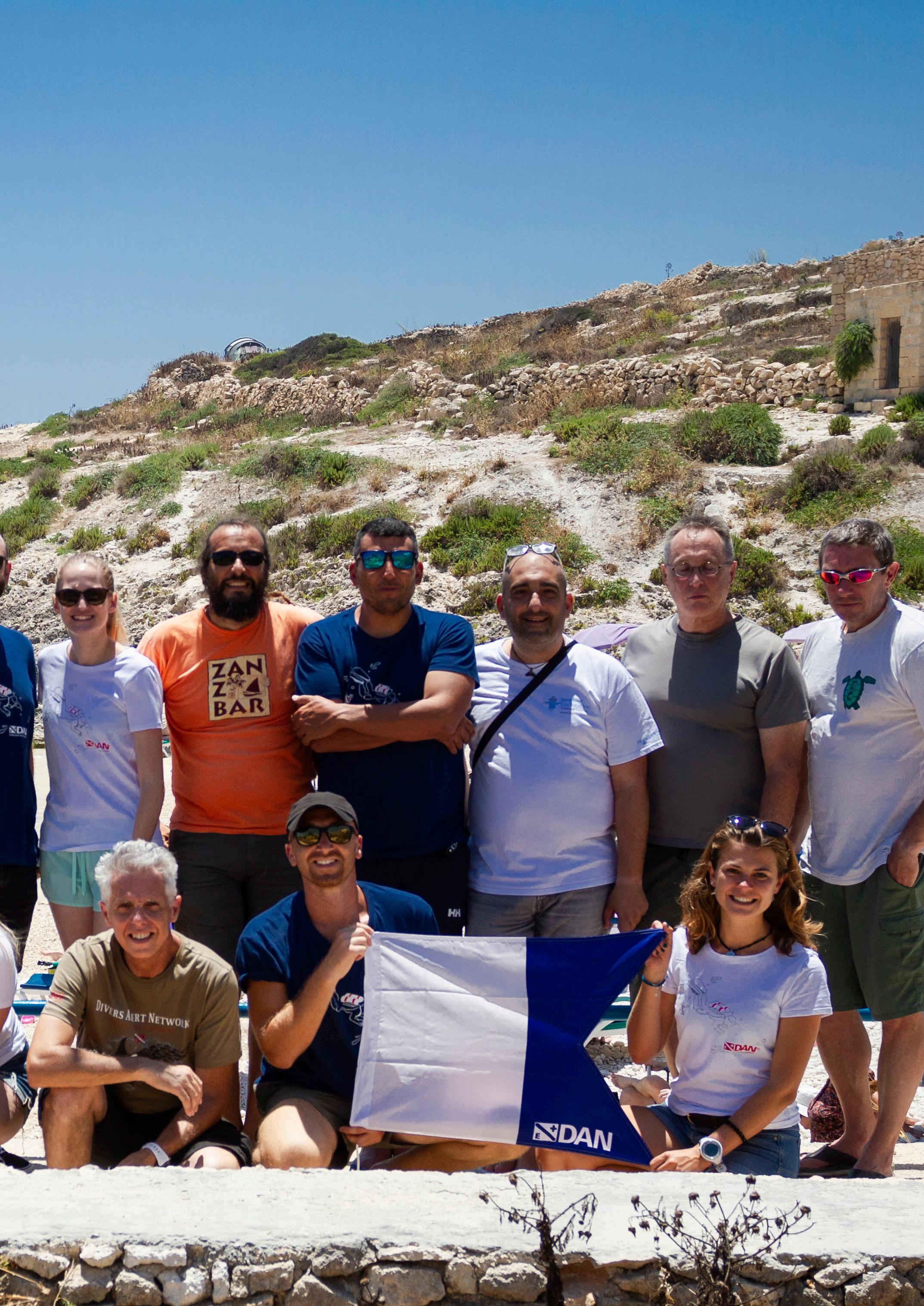
“Even if you are on the right track, you will get run over if you just sit there.” Will Rogers
Thankfully, Malta’s Institute of Tourism Studies is not just “sitting there.” In fact, about two and half years ago, they introduced a new Bachelor programme dedicated to scuba diving. And the first cohort will graduate this coming June.
In this article, we will first look at the new Bachelor programme in Malta and what impact it could have on the diving industry. Then, we will discuss the possibility of a similar programme in other regions. Finally, we will list five steps that dive professionals can take today to improve their ability to provide outstanding customer service.
This morning, I had a quick look at the preliminary results of an InDepth/Scubanomics survey we will publish next week. A significant majority of dive professionals (almost a consensus) believe in a severe lack of consistency in the quality of the experience in the diving industry.
Between two dive centres or two dive instructors associated with the same training agency, the quality of service provided is often significantly different.
Furthermore, a large majority of dive centre owners and managers feel they do not have the training, tools, and support to properly manage a dive centre and offer scuba courses that satisfy the high expectations of today’s consumers.
Part of the problem is a lack of quality control by the brands operating in the dive industry. If 82% of McDonald’s customers felt like they never knew what they would get at a McDonald’s, you can be sure there would be drastic measures taken at the headquarters, and some local owners of McDonald’s restaurants would lose the right to use the name.
I understand that these restaurant operators are franchisees which is not the case in the diving industry. But the problem remains: there is no brand we can trust in the diving industry!
Another part of the problem, is a lack of business and management training for dive professionals. We train dive instructors to teach new divers how to remove and replace a mask underwater, but where is the training programme about customer service, quality control, and business management?
Many dive centres are operated by dive professionals passionate about scuba diving. I’m convinced they want to offer a quality experience. We just need to help them do it.
A BACHELOR OF SCIENCE IN DIVING SAFETY MANAGEMENT IN MALTA
Wait a minute! How can a programme focusing on diving safety be a step in the
right direction to offer business management training to dive professionals? Bear with me for a minute, please!
Yesterday, I had a long conversation with Simon Caruana, Senior Manager, Academia, at the Institute of Tourism Studies in Malta. Their bachelor degree is a three-year programme offered in collaboration with DAN Europe. That explains the focus on diving safety! But there are quite a few business management courses within the programme.
Here are some of the modules in the Bachelor of Science in Diving Safety Management in Malta:
• Tourism Marketing
• Economics
• Employee Engagement & Relationships
• Health & Safety in the Workplace
• Legal Aspects & Regulations in the Diving Industry
• Public Policy
And there’s one important point to mention about the list: changes are coming.
Malta’s Institute of Tourism Studies launched the Bachelor of Science in Diving Safety Management a little more than two years ago, right at the beginning of the pandemic. The first cohort of 6 students will graduate this coming June. With the imminent completion of the first three-year programme, they are proceeding with a review of the whole programme.
Therefore, if you are interested in joining the next start of the programme in October 2023, you should expect improvement in the lineup of courses.
HOW DOES THE MALTA PROGRAMME WORK?
The Bachelor of Science in Diving Safety Management is a hybrid programme with all theory modules offered online while face-toface activities are only required for practical applications.
Furthermore, the more traditional scuba diving courses that are part of the programme can be done at other locations, or you could be credited for already having done them, like Enriched Air Diver, Divemaster, Instructor, and Gas Blender.
Simon insisted that they were pretty flexible in scheduling their activities, as some students were only coming to Malta for face-to-face sessions every once in a while. Furthermore, the programme is always in recess from June to October, giving a chance to students to be active in the diving industry during its busy months in the Northern Hemisphere.
WHAT IS MISSING IN THE MALTA PROGRAMME?
It seems to me there are three areas of study that could be added or beefed up.
• Business. It’s what we mentioned above about general business management, quality control, customer service, sales & marketing, bookkeeping, and the like.
• Climate-friendly Tourism. A 2022 global study by Expedia found that 90% of consumers nowadays look for sustainable options when travelling. “The environment” is no longer a side story and even more so in an activity highly dependent on it, such as scuba diving.
• Outdoor Activities. There’s a need for dive centre operators to widen their horizons and actually be outdoor or water sport centre operators. Younger generations tend to be less interested in diving-only travel than the baby boomers are.
Although Simon agreed with this assessment, there is no guarantee these modules will be added before the next cohort starts in the programme in October 2023. So, suppose you are interested in a Bachelor of Science in something directly related to the diving industry. In that case, I suggest you keep an eye on that programme on the Institute of Tourism Studies website and contact them.
HOW COULD OTHER REGIONS GET A BUSINESS OF DIVING DEGREE?
A while back, Nova Southeastern University in Fort Lauderdale, Florida, had a project to create a business of diving degree as an add-on to its highly successful scuba diving programme. But at the time, they opted to develop a Minor in Scientific Diving instead. That programme was just launched last Fall. It makes sense for them because scientific diving is of interest to their marine biology students.
However, the director of the scuba diving programme at Nova, Tec Clark, told me yesterday that the door was not totally shut on the possibility of Nova Southeastern University reviving its business of diving projects.
Having such a programme in both Malta and South Florida would be great for the dive industry. And both locations are wonderful diving destinations, on top of that!
By the way, if you want to see a well-run scuba diving programme, visit Nova Southeastern University! Tec runs a professionally managed programme in all its minute details, including proper cleaning and disinfecting of dive gear in a way I have never seen anywhere else.
Another option would be for the Malta Institute of Tourism Studies to partner with an academic facility in another region of the world to offer at least part of their Bachelor of Science programme at that location.
5 STEPS YOU CAN TAKE TODAY TO IMPROVE YOUR CUSTOMER SERVICE & QUALITY MANAGEMENT ABILITIES AS A DIVE PROFESSIONAL
Even if we still do not have a complete
54 DIVERS FOR THE ENVIRONMENT | MARCH 2023 FEATURES
business of diving degrees to improve the quality of the experience provided to scuba diving consumers, there are many resources available to the dive professional serious about a career in diving. And here are five of them.
1. TEC CLARK’S PODCAST: The Dive Locker
It’s free, and it’s a complete meal! Among many valuable episodes of The Dive Locker, I suggest you listen to ‘Deconstructing The Diving Industry’, and ‘The Economics of Being A Diving Instructor.’
2. ALEX BRYLSKE’S BOOK: Beneath The Blue Planet
We mentioned earlier in this post how a majority of today’s consumers are sensitive to planet-friendly travel. In the case of scuba diving, it goes one step further: our clients hire us to connect with that planet!
And Alex has made his mission to promote a renewal of the dive industry to focus on “why” we dive, not on selling gear and courses (those will sell better anyways under the new model). Sustainable tourism is a fast-moving train the dive industry needs to get on board immediately. It includes addressing trends such as citizen science and “voluntourism.”
‘Beneath The Blue Planet: A Diver’s Guide to the Ocean and Its Conservation’ by Alex Brylske should be every dive professional’s ocean bible. The “Doing The Right Thing” section on implementing sustainable dive practices is a gem.
3. GARETH LOCK’S ONLINE COURSE: Essentials in Human Factors in Diving
This one-of-a-kind course covers the foundations to understand the human impact of diving and how to ensure the dives you have are safe. ‘Essentials in Human Factors in Diving’ is about reducing the number of errors you make, and if you do make some, it covers how to be resilient and continue in your instructional task.
4. MY BOOK: Your Career and/or Life as a Scuba Diving Instructor
“The chapter ‘Teaching For Success,’ I think is especially masterful and portions of this book will become part of my curriculum.”
Dr Alex Brylske.
‘Your Career and/or Life as a Scuba Diving Instructor’ covers many aspects of being a professional ‘dive professional,’ including customer experience and satisfaction, customer expectations, and offering
coaching sessions instead of selling c-cards.
5. TEC CLARK’S ONLINE COURSE: Risk Management for Diving Professionals
Talking of human errors… Tec Clark’s online course provides practical strategies and tactics to ensure your safety and that of your client divers.
“The course will not only make you a more informed diving professional, but will help protect you and those in your charge so that your focus can be squarely on the wonderful sport of scuba diving.” Dan Orr.

THE AUTHOR
Darcy Kieran is principal at the Business of Diving Institute in Miami, specialising in dive industry market research and strategic planning.
The dive industry as a whole doesn’t yet provide the level of customer service today’s consumers expect, but we can work on making progress.
Join Darcy Kieran for business of diving discussions at www.scubanomics.com
55 MARCH 2023 | DIVERS FOR THE ENVIRONMENT FEATURES
ABOVE: Students during a briefing before diving with Massimo Casabianca, Professor Riccardo Pellicia and Professor Massimo Pieri. They will dive to calect a set of various data for marine life, tele medicine and diving data.
CORAL REEFS WHY WE NEED THEM
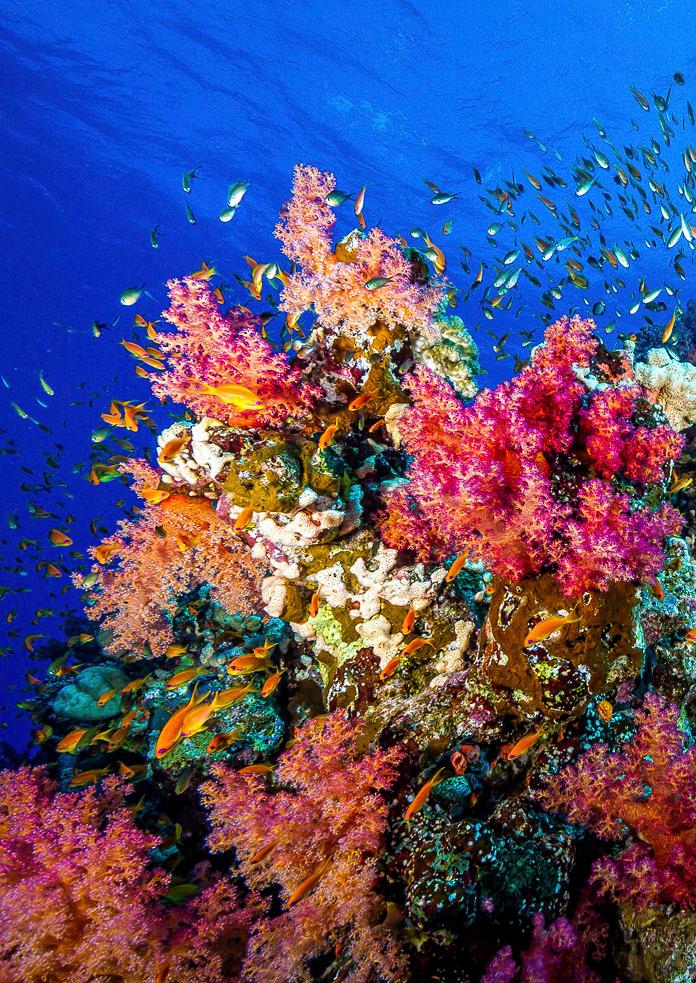
LUCAS
reefs have existed for millions of years, since the Triassic. Despite their ancient origins, coral reefs continue to play a vital
in the health of our oceans.
FEATURE
ASENJO RIVAS Coral
role
COVER PHOTO: A coral reef in Egypt by Philippe Lecomte.

Coral reefs have existed for millions of years, since the Triassic. Despite their ancient origins, coral reefs continue to play a vital role in the health of our oceans.
They provide important ecosystem services as they are one of the planet’s main sources of oxygen. They protect coastlines from storm surges, provide habitat and food for countless marine species, and generate income for human populations living near them through activities such as fishing and tourism.
In recent decades, coral farming has increased exponentially due to the rapid decline of coral reefs, mainly as a consequence of climate change. Another cause of reef extermination is the export of corals from the marine environment without repopulating the reef, either through poaching or by small local companies making direct sales.
Corals are an endangered species and therefore their import, export, transfer and cultivation is regulated by the CITES (Convention on International Trade in Endangered Species of Wild Fauna and Flora).
CITES species are divided into three appendices according to the level of protection they require. Corals are in appendix II, which indicates that it is a species that is not in imminent danger of extinction, but its trade must be compatible with its survival and is subject to authorisation by means of a CITES certificate.
Reefs harbour and protect one-third of the world’s fish species. One of the most important is the Scaridae family, commonly known as parrotfish. They have a fundamental role since they feed on the invasive algae that inhabit and suffocate the corals. In addition, they participate in the cleaning of the reefs as they crush the dead corals forming the beautiful white sandy beaches.
There are two main classifications of corals, hard corals that have calcareous structures, and soft corals that lack calcareous structures. Within the hard corals we can differentiate two subclasses according to the size of their polyps, they can be LPS (Large Polyp Stone) and SPS (Short Polyp Stone).
According to CITES, the largest exporters of live corals since 1997 have been Indonesia (81%), Fiji Islands (12%) and the Solomon Islands (7%), as is the case with the export of live rock and coral for ornaments or jewellery, whose main exporting countries are Hong Kong, Korea, and Taiwan. The global export value of the marine aquarium coral trade averages $40 million per year.
CITES also estimates that the United States is the largest importer of live coral and reef rock, accounting for 80% of the live coral trade. There are also other coral importing countries such as Germany, France, the Netherlands, the United Kingdom, Japan, and Canada. According to the CITES database, permitted exports of
coral from 1996 produced 2.5 million pieces of live coral and 3,000 tons of coral entering international trade each year for aquarium use.

Because of this, new ways of growing coral efficiently are now being sought to maintain the vast majority of imports without resorting to the sea.
One of the systems most commonly used by small exporting companies that used to harvest corals from the sea, is the cultivation or planting of corals directly in the sea. It is an efficient way to generate new corals in large quantities and with very little impact on the environment while generating new reefs that quickly become home to various fish.
In addition, this method has great advantages since they do not have space limitations, nor do they need very large plots, so they do not have to worry about sizing the facilities for the cultivation phase. It is also very beneficial as they do not have to worry about parameters, current or electricity costs.
The most used method nowadays is the culture in closed systems with water recirculation which allows to develop the culture anywhere without having to be in the sea. The main components for the propagation of corals in closed systems needs tanks, lighting systems, water pumps, filters and good physicalchemical conditions of the water. Good quality is essential for their development.
58 DIVERS FOR THE ENVIRONMENT | MARCH 2023 FEATURES
ABOVE: The World Wide Corals farm in Orlando, Florida, USA is dedicated to the cultivation of corals for sale for private aquariums. There are currently two stores in the US.
To increase the efficiency and production of corals, we must begin by understanding that the vast majority of corals live in symbiosis with a type of microalgae called zooxanthellae, whose main food source comes from light through photosynthesis, although they also occasionally feed on zooplankton and phytoplankton.
It is important to keep in mind that each coral species will have different needs. Within the taxonomy of corals, they are mainly divided into two subclasses: hexacorals and octocorals.
The name hexacoral derives from the number of tentacles they have, which are six, or multiples of six, they are also known as hermatypic or hard corals which are reefbuilders. Two main species are Acropora and Pseudodiploria strigosa known colloquially as brain coral.


The octocorals have 8 tentacles surrounding their mouths and are mostly formed by soft corals among which the gorgonia stands out. This is important because depending on the subclass they will have different requirements.
Corals, especially hard corals, are characterised by being covered by the tissue of individual units called polyps. Polyps exhibit the same biological properties and a high degree of internal communication, so that a colony behaves as a physiological unit.
The polyps present a symbiosis with
photosynthetic dinoflagellates of the genus Symbiodinium, which reach densities between 1-5 million per cm² of tissue.
These dinoflagellates produce lipids and carbohydrates from photosynthesis, providing the coral with 95% of the nutrients necessary for its maintenance, growth, and reproduction. In return, the coral provides the dinoflagellate with a substrate with suitable conditions for photosynthesis. Because of this association, corals develop where the concentration and circulation of nutrients is low, but the amount of sunlight is high. Corals respond with greater growth to wavelengths between 620 and 700 nanometres.
Corals can reproduce asexually by cloning polyps or by accidental fragmentation if found in the sea, or they also employ sexual reproduction that includes a season of gamete production and spawning.


Sexual reproduction represents greater potential advantages for the individual and the population because it involves genetic exchange, resulting from meiosis. But it also has disadvantages.The population must be of large dimensions to avoid recycling of the genes present, the process has a high larval mortality and normally occurs sporadically. Usually once a year with some special environmental factors – mainly due to the sea surface temperature accompanied by moonlight due to its influence on the release of gametes,
related to the heating and illumination of the surface water and the sea.
Microfragmentation is the most modern and efficient strategy of asexual reproduction. There is no genetic exchange, as it is generated from a previously established colony. One of the advantages is that there is a high probability that the fragment will find the right conditions, since it is installed a few metres away from the mother colony or in a base in the case of human cultivation.
This process is favourable for the development of new coral colonies in stable environments as it is rapid and results in low mortality rates. However, the drawbacks of asexual reproduction are that the polyps or fragments behave exactly the same as the colony of origin as there is no genetic exchange, so the new colony may be just as strong, but also just as weak to environmental changes.
We can find hermaphrodite corals, that is, corals that develop gonads of the same sex within the same polyp, and gonochoric species if they have only one of the two sexes.
Due to global warming and ocean acidification, it is estimated that by 2050, more than 80% of reefs will be extinct. Therefore, more research is needed on the cultivation of corals in recirculating systems to select and reproduce the most resistant individuals for future restocking to ensure their survival.
59 MARCH 2023 | DIVERS FOR THE ENVIRONMENT
FEATURES
ABOVE L-R: The remains of Porites lobata embedded in rock; Acropora nasuta; Pseudodiploria strigosa known as brain coral; Parrotfish with Porites lobata
TRANFORMATIONAL EXPERIENCES WITH PADI
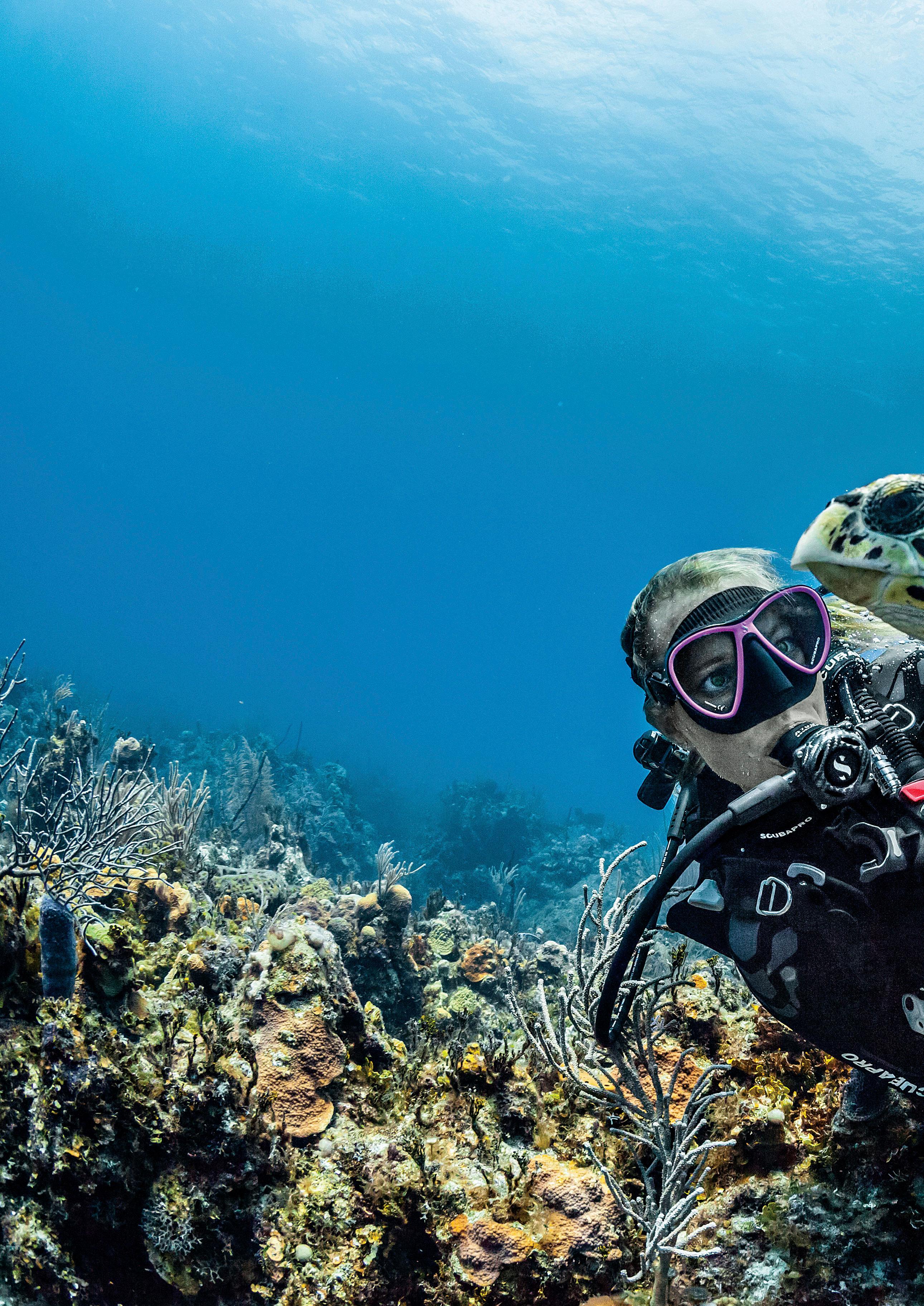
FEATURE AND PHOTOGRAPHY PADI To help make 2023 the year of transformation for both yourself and the planet, PADI offers a range of immersive experiences – from mermaiding to scuba diving – that allow you to join the underwater world and create positive ocean change.
COVER PHOTO: By Neil Andrea
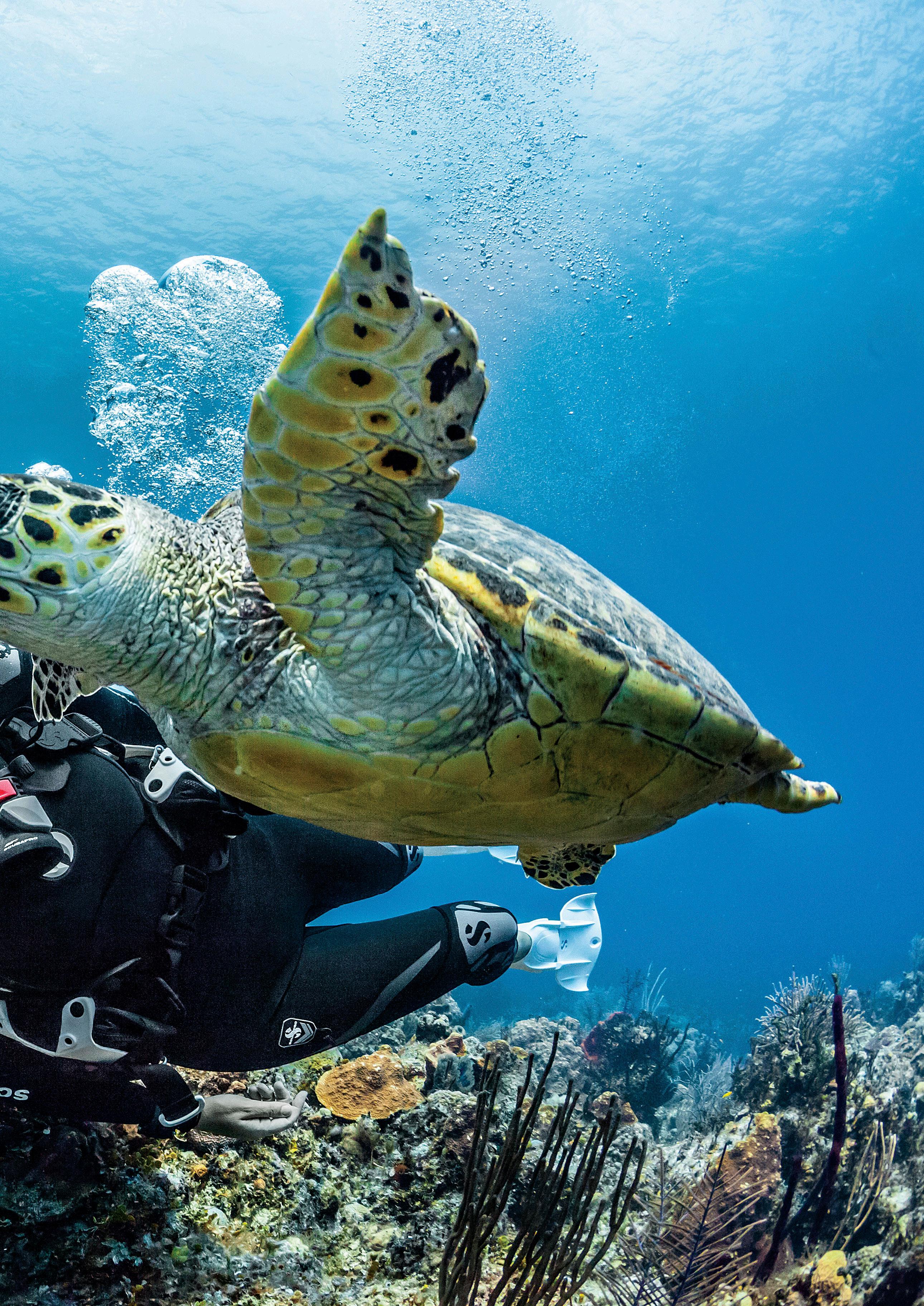
THE TOP 3 TRANSFORMATIONAL EXPERIENCES WITH PADI
To help make 2023 the year of transformation for both yourself and the planet, PADI offers a range of immersive experiences – from mermaiding to scuba diving – that allow you to join the underwater world and create positive ocean change.
1. DISCOVER SCUBA DIVING
Have you dreamed of taking your first breaths underwater? Now you can turn that into a reality and join the incredible world beneath the surface.
The PADI Discover Scuba Diving (DSD) is a short try-diving experience for adults and children aged 10+. This course introduces you to the basics of scuba diving without certifying you as a diver.The DSD programme is a singleday activity, so it’s ideal for those interested in trying scuba, but lacking the spare time.
The PADI DSD programme typically involves a detailed briefing on the effects of water pressure, underwater communication, equipment use, and diving safety.Then, you’re ready to go!
2. FREEDIVING
Connect with yourself and boost your confidence in a single breath. As a PADI Freediver, you will harness your inward power, discipline and control – which allows you to go beneath the surface quietly and on your own terms.
To enroll in a PADI Freediver course , you must be at least 15 years old. You need adequate swimming skills and need to be in good physical health. No prior experience with snorkelling, skin diving or freediving is required.
3. MERMAIDING
Harness your own magic and learn to become a PADI Mermaid where you will learn to not only swim, dive and perform mermaiding skills with a monofin and tail, but also learn how to be a voice for the ocean and all life that calls it home.
Anyone as young as 6 years old can start their mermaid journey with PADI Mermaid Centres around the world ready to teach you the art of tail flipping in a truly transformational journey.

TOP REASONS SCUBA DIVING IS REGENERATIVE BY NATURE
Learning to dive not only changes your life and the way you see the world, but also allows you to explore in a regenerative way.
PADI Scuba Divers are regenerative by nature, as they are:
1. NON-EXTRACTIVE
Admiring the world they are immersed in, scuba divers don’t leave anything but bubbles behind.
2. IMMERSIVE
Immersed in the underwater world, scuba divers leave distractions behind up at the surface and
truly live in the moment – allowing themselves to be mesmerised by colourful nudibranches, dancing manta rays or friendly sharks.
3. INCLUSIVE
PADI makes becoming a scuba diver possible for nearly anyone, with adaptive diving supporting those with physical and mental disabilities explore beneath the surface.
4. DIVERSE
PADI Scuba Divers are amongst the most diverse in the world, with anyone as young as 10 years old able to become certified and those of all genders and race welcomed in –equally being provided the opportunity to turn their passion for scuba diving into a profession
5. RESTORATIVE
Restore Yourself: have profound underwater adventures that empower you to be deeply immersed in the magic of the sea to enrich your life, connect to nature and elevate your and our blue planet’s wellbeing.
Restore the Ocean: help restore the health of the ocean and collective hope by joining the global community of ocean torchbearers to take meaningful action to protect what we love from home and abroad. As a diver, you are certified to make a difference with your own two hands on our blue planet
Restore Community: reconnect and grow together by taking part in experiences
62 DIVERS FOR THE ENVIRONMENT | MARCH 2023 FEATURES
that honour local communities, champion sustainable coexistence, nurture diversity, and cultivate kindness.
HOW SCUBA DIVERS CAN CHANGE LIVES THROUGH TRAVEL

As a scuba diver, freediver or mermaid, you uniquely earn the skills and increased ability to heal our blue planet.

1. BE THE CHANGE
Be the best version of yourself through meaningful ways to make a difference: citizen science , reducing impact and diving for good. Lead by example.
2. IMMERSE IN PURPOSE
Travel ethically, responsibly and sustainably. Travel with purpose and for YOU. Cherish experiences – not stuff. Protect paradise.
3. UNPLUG AND RECONNECT
Travel to return to what’s important. Slow down, disconnect from technology + enjoy the moment. Connect with kindness.
4. HEAL FOR AND WITH THE OCEAN
Heal ourselves before we heal the planet. Celebrate the gifts from the ocean: a blue state of mind. Return the favour.
5. CONNECT TO COMMUNITY
Extend kindness and remove boundaries. Experience journeys formed by culture and benefit the community. Give more than take.
63 MARCH 2023 | DIVERS FOR THE ENVIRONMENT FEATURES
Photo by Neil Andrea
THE STANDARD EXPOSURE SUIT?
COULD DRYSUITS BECOME

FEATURE AHMED NABIL PHOTOGRAPHY HUISH OUTDOORS, USA
Compared to my buddies who were experiencing the temperatures of the cold water and their heavy wetsuits, I was enjoying my warmth and comfort. We reached the surface and one by one ascended into our boat. Amongst the shivering smiles of the divers back onboard, I was smugly feeling extra dry.
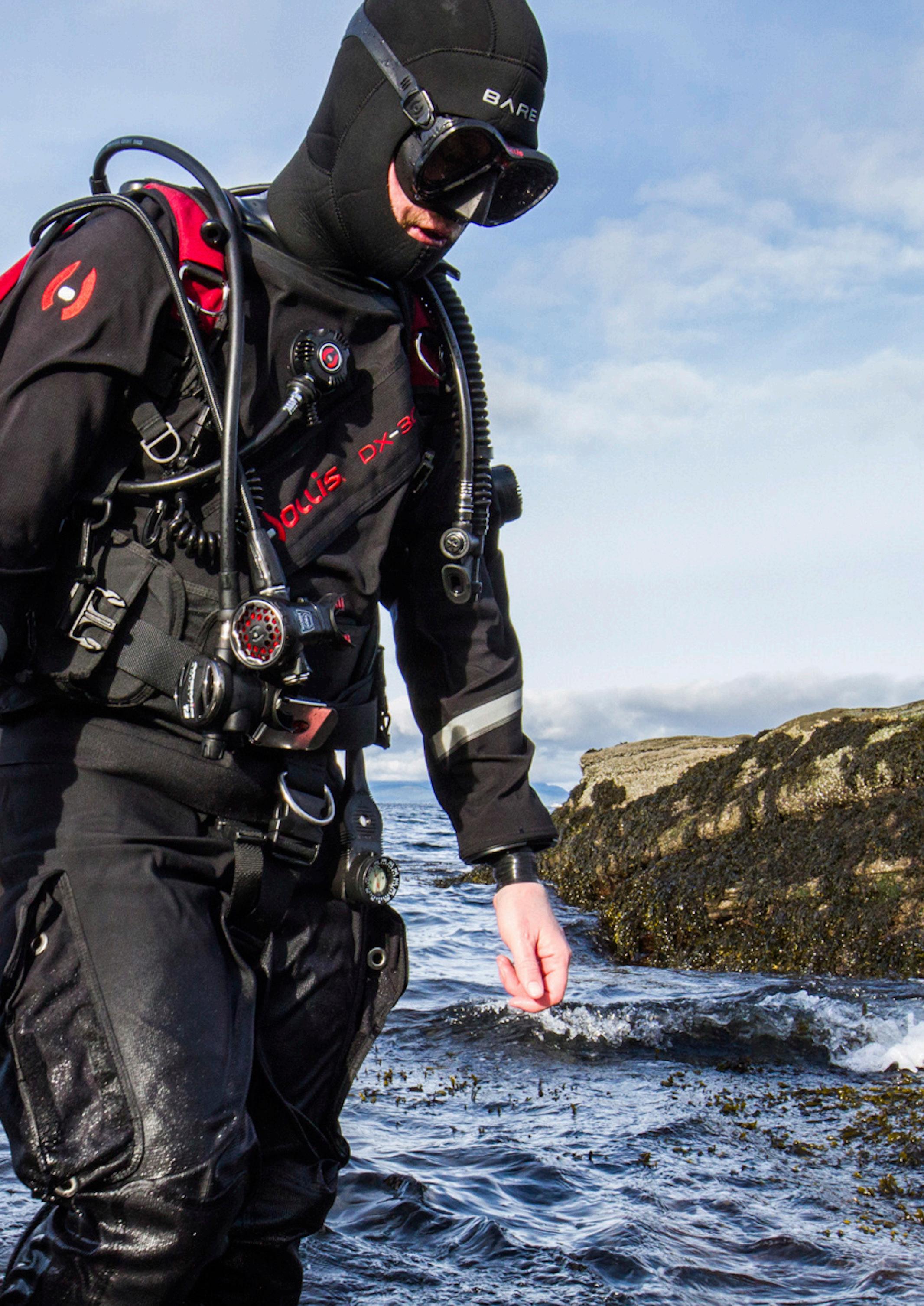
Our winter season in the UAE is about to come to its end. For people addicted to diving, such as myself, we enjoy our sport and underwater meditation 365 days year round!
An enjoyable stance in 21ºC at the surface, turns out to be challenging when diving at the same temperature underwater down at depth. Heat transfers 20 times faster underwater than in air. Without the proper protection from an exposure suit, we would start shivering after 10 minutes of being in the water.
On this subject, the dry suit pops up as a solution for cold weather diving. Surprisingly, diving with a dry suit can be done any time of the year, not only in cold and extreme conditions. The dry suit itself is an envelope sealing the water from the diver’s body. The heat protection is actually achieved via the undergarments a diver puts on under his dry suit. The colder it is, the heavier the undergarments are needed to be.


It was time to dig out my dry suit. Being a dry suit speciality instructor, it excites me to refresh my skills and resume diving with it.
Divers share many common habits and one of them is that we all enjoy our pre-dive preparations. Mine included watching the dry suit speciality video course, doing a quick knowledge review, inspecting my suit and ensuring it is in good working condition, to
then selecting my dive site, and ticking off all other last minute logistics. It’s all part of the fun and the excitement. I was happy to find my dry suit again, a Hollis BX200 BioDry Drysuit, a necessity for my winter season dives.
Divers must be certified in a Dry Suit Speciality course before attempting to dive in one. Diving with a dry suit requires a couple of extra skill sets which are very different from those of a standard wetsuit. Adding new air space to your equipment, avoiding a suit squeeze, and adding extra weight to compensate for buoyancy are only a few points to mention. It is not complex, but a diver needs to learn and practice a couple of new techniques they will not already be familiar with.
Please approach your dive centre or instructor for details, it will grant you enjoy a safe and fun dive.
THE 2 TYPES OF DRY SUITS
Each type has its own pros and cons: Price, features and durability.
• Neoprene, which consists of compressed neoprene. It provides the warmth from the material itself. The suit becomes heavier when it gets wet, and it’s harder to get a foot down.
• Membrane, a simple shell that keeps water out, and air in. They are very thin and a diver adjusts the heat protection
via undergarments that he/she adds on underneath the dry suit.
My dry suit is quite an old model, the BX200 BioDry comes with a rear zipper entry. There have been many improvements and upgrades to dry suits since then. For instance, a front zipper entry is a major one. Having a front zipper helps the diver to don “put on” his suit without the help from his buddy, or anyone else. Compared to my rear zipper entry dry suit, I need an extra hand to close and open mine.
There is another reason to get your speciality course done before attempting dry suit diving. Dry suits are more like a tailor-made suit, it needs a little altering to become a diver’s perfect fit. Neck and wrist seals need trimming to be fitted to the diver. This is to ensure tightness to avoid water leaks, but to have no restrictions for good blood circulation. Once this is done properly, you can enjoy your suit and investment for a long time. Warmth and comfort are the main benefits.
I chose to start my adventure with a deep dive to 31 metres at Inchcape 1. It’s one of my favourite wreck dives in the UAE. While in a dry suit, it’s important to keep the upper part of the suit open until you are ready to dive. You can get over heated quickly on land, even if it is cold weather. Most dry suits come with a crotch strap, it helps the diver to move freely on land while half donning the suit. After
66 DIVERS FOR THE ENVIRONMENT | MARCH 2023 PRODUCT REVIEW
ABOVE L-R: The Hollis DX-300X BioDry Drysuit with improved front zipper; An example of undergarments worn underneath the dry suit.
10 minutes of an enjoyable boat ride, we anchored to Inchcape 1 and we started our pre-dive preparations. I was using my standard diving gear (BCD, mask and fins, etc) I had to add an extra 6 pounds to my weight belt to compensate for the dry suit’s buoyancy. I also had to have an extra low air pressure hose fitted (done earlier) to my air regulator for the dry suit inflation. We started the equipment assembly, did our buddy checks, and we were all set to go. Remember to put the upper half of the dry suit on and tightly close the zipper once ready to jump into the water. Equipment on, and one final check. Clear? Clear… and here again, breaking the surface into the amazing underwater world.
It was a completely different feeling to break the surface in my dry suit. Not getting wet or feeling the cold rush of water was such a nice and comfortable feeling!
For those who are unfamiliar with dry suit techniques, we control our buoyancy underwater by inflating the dry suit – not the BCD. It’s crucial to keep compensating the air inside the suit while descending to avoid a suit squeeze. The air space inside the dry suit gets pressurised leading to the dry suit squeeze against the diver’s body which leads to a lot of discomfort and a painful situation that could lead to a hazard, or an injury.
Once we safely reached the wreck, we started
our dive around it and enjoyed the rich marine life. Dry suits are a little bulky compared to standard wet suits, so they create more drag while finning underwater. You have to kick harder and more frequently when in one. This is one of the main reasons Technical Divers use DPVs for their deep dives in dry suits.
As per the Recreational Dive Planner (RDP), there was not much time to spare. We started our ascent keeping our eyes on the remaining air pressure and ascending rate. In the opposite to my descent, I had to keep releasing air from my dry suit to avoid excess buoyancy and accidental run away/fast ascent. Dry suits are equipped with air release dump valves at the diver’s shoulder. You can enjoy the air release automatically via adjusting the sensitivity of the dial valve, or you can simply release the air manually. With a dry suit, a diver must be careful not to have the air escape down to the legs. This will put the diver into an upside down position. During a dry suit training, there are skills to sort out such incidents that avoid this becoming an issue.
We reached our 5 metre safety stop before having to exit our magnificent underwater world. Compared to my buddies who were experiencing the temperatures of the cold water and their heavy wetsuits, I was enjoying my warmth and comfort. We reached the surface and one by one ascended into our boat. Amongst the shivering smiles of the divers
back onboard, I was smugly feeling extra dry.
Besides the features, models and durability of dry suits, the price will somewhat become a point of choice. A dry suit costs 4 to 5 times more than a wetsuit. The investment payback comes in the form of a more rugged exposure suit that will last longer, it’s a cheaper cost per dive, and it’s more fun to be warm during a dive. Nevertheless, it’s the only practical exposure suit to dive in extreme cold situations.


Diving in a dry suit is definitely a different experience to diving in a wetsuit. I find it’s more enjoyable to be warm on my dives. More attention needs to be paid to dry suit diving, but this is overcome with the proper training. The experience does leave me to ponder; will dry suits become the standard exposure suit one day?
ABOUT MY DRY SUIT:
HOLLIS BX200 BIODRY
• Polyurethane, Nylon, Non-woven
• 5 year warranty on workmanship
• BX200 comes with a rear zipper
• Comes with reinforced wearforce composite kneepads
• Bioflex improved with WearForce material: a non-woven nylon material laminated to a heavy-duty, stretchable polyurethane
67 MARCH 2023 | DIVERS FOR THE ENVIRONMENT PRODUCT REVIEW
ABOVE L-R: The dry suit’s exhaust valve location; The dry suit is custom fitted to each diver for the ultimate comfort.
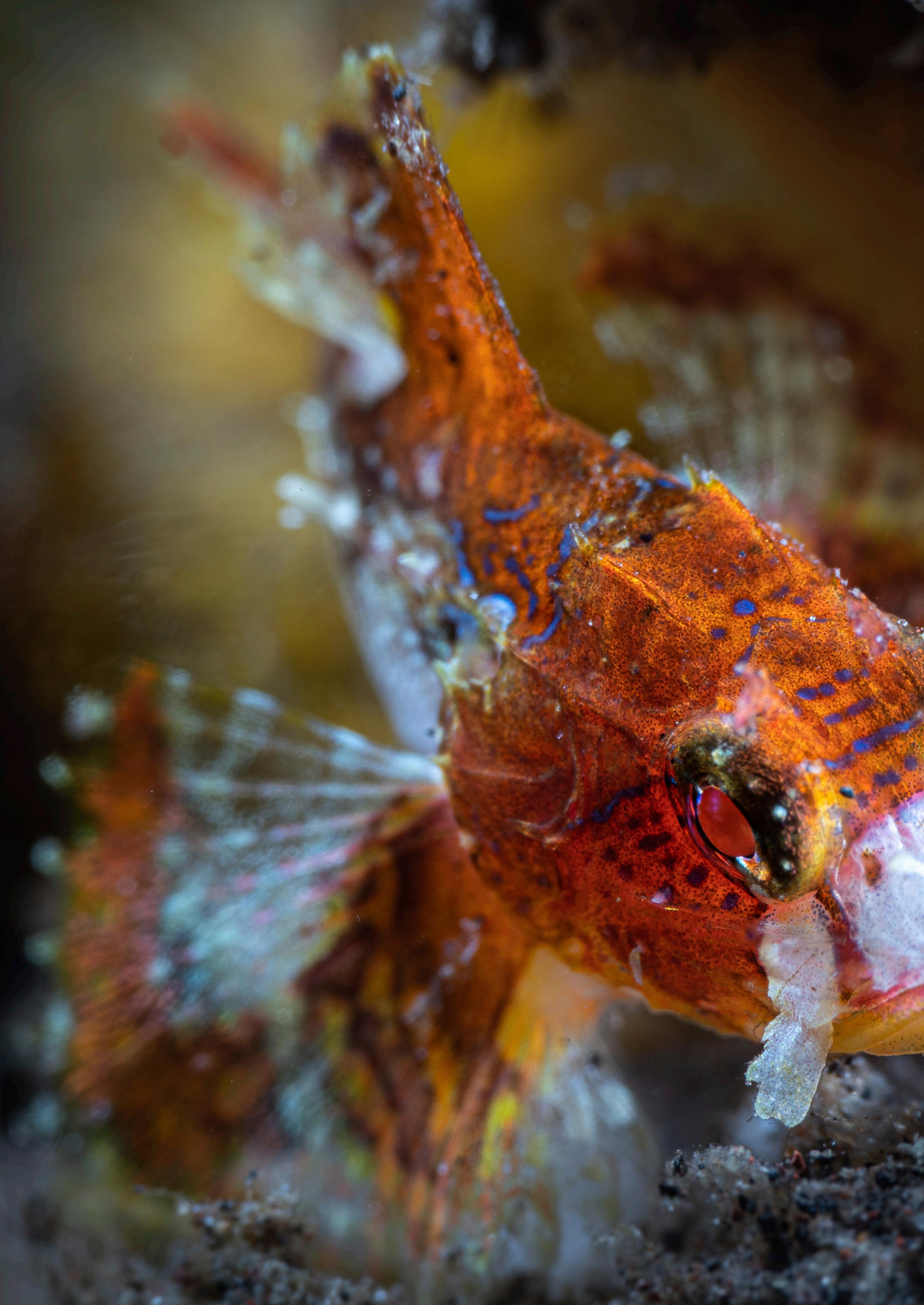
HOW TO TAKE PART
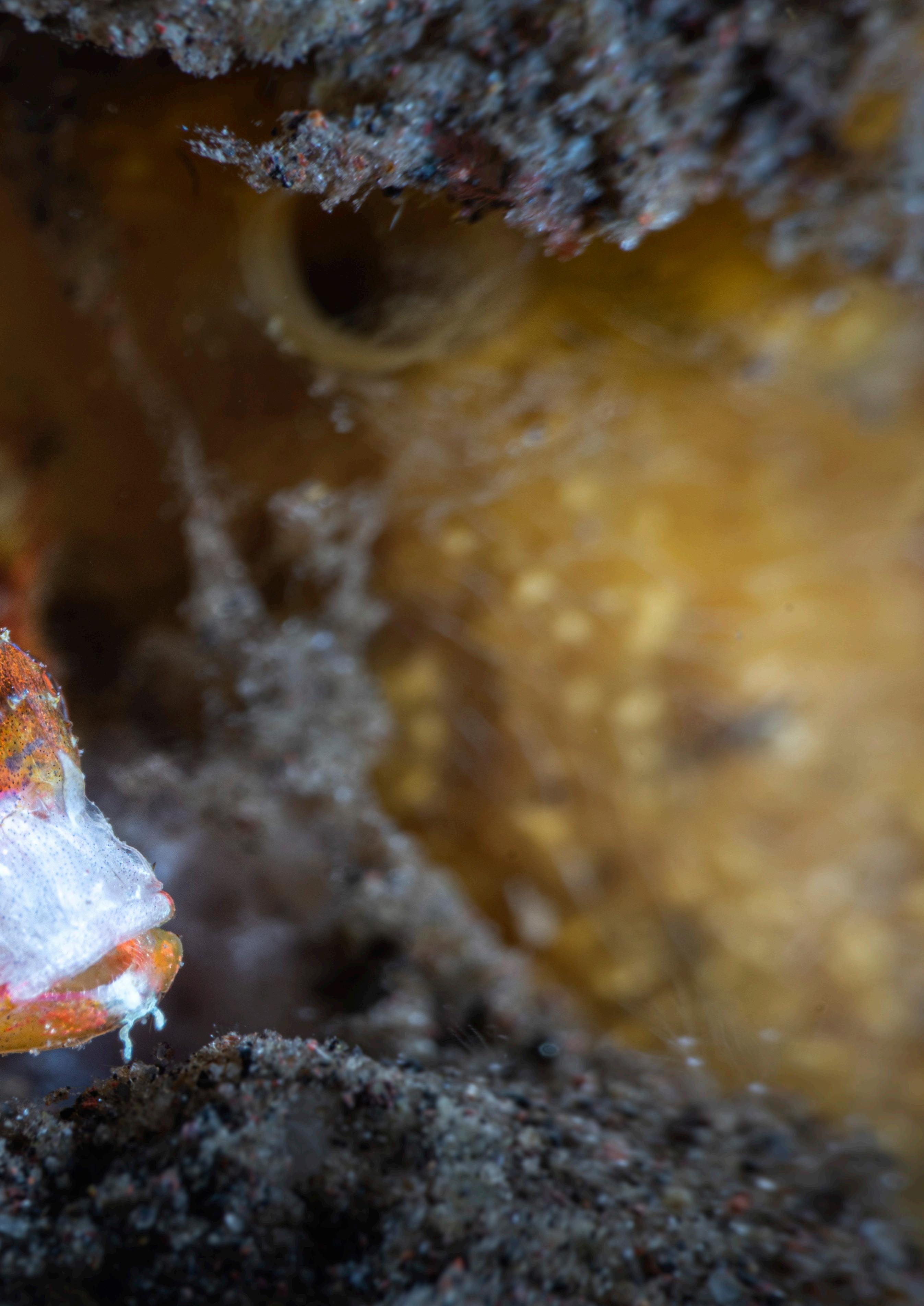
Register for EDA Membership to take part in Digital Online and get the chance to win some amazing prizes. Membership gives you access to all of EDA’s annual events and activities. SUBMISSION DEADLINE Thursday 6th April 2023 at 11:59pm (GST) ENTER DIGITAL ONLINE EDA’S UNDERWATER PHOTOGRAPHY AND FILM COMPETITION 2023 WWW.EMIRATESDIVING.COM
Photo by Sultan Althahab – Digital Online 2022
DIGITAL ONLINE 2023
EDA’S UNDERWATER PHOTOGRAPHY AND FILM COMPETITION
SUBMISSIONS OPEN: Monday 6th March 2023 |
SUBMISSIONS CLOSE: Thursday 6th April 2023 at 11:59 PM (GST)
DIGITAL ONLINE AWARDS & EXHIBITION OPENING NIGHT: Thursday 18th May 2023 at Deep Dive Dubai

EVENT PARTNER PRINTING PARTNER AN EVENT BY THE EVENT
DIGITAL ONLINE’S MAIN OBJECTIVES ARE:
• To develop the human interaction with the underwater environment and highlight the beauty of its flora and fauna.
• To gather information on the number of underwater photographers in the UAE.
• To discover new promising underwater photographers locally and internationally. Digital Online is open to all photographers and videographers of all skill levels with a valid EDA Membership status. EDA membership must be renewed if expired or acquired in order to take part: www.emiratesdiving.com/membership-form
DIGITAL ONLINE 2009-2023
Digital Online – EDA’s Underwater
Photography and Film Competition, is about to celebrate its 14th year! The competition was introduced by EDA in 2009 to resident photographers to develop a relationship and human interaction amongst those unfamiliar with the underwater world environment. The competition holds both local and international marine life categories to offer variety between our local and international diving enthusiasts. The film category was introduced as an extension to the competition in 2012 to share our underwater world through motion pictures and deliver a better understanding of the habitats and surroundings.
The event sees continuous and steady growth with new underwater photographers taking part and joining our regular annual participants. The enthusiasm and passion strives on, and the drive to bring our underwater world’s conservation to the forefront increases even
more so. The purpose of Digital Online is to keep our underwater world visible by displaying its hidden beauties and to exemplify its importance to all life on Earth through the powers of its ecosystems.
The event has attained equal success with nondivers who come to support the participating photographers and videographers at the annual Awards & Exhibition Opening Night. Whether it’s through discussions, or articles
published for our readers through our free quarterly magazine, Divers for the Environment, the inspiration the event brings, is a success in its own right.
COMPETITION CLAUSE
EDA does not disclose photographers’ names during the judging process. The competition is run fairly and without prejudice, professionally adhering to all of Digital Online’s rules and guidelines throughout.
70 DIVERS FOR THE ENVIRONMENT | MARCH 2023 UNDERWATER PHOTOGRAPHY
The Digital Online 2022’s Awards Night and Exhibition opening at Deep Dive Dubai.
THE DIGITAL ONLINE RULES AND GUIDELINES 2023
RULES AND GUIDELINES
• Digital Online is open to all photographers and videographers of all skill levels with a valid EDA membership status. EDA membership must be acquired, or renewed if expired in order to take part which can be done through the EDA website: www.emiratesdiving.com/membership-form
• Each competitor can only win one prize.
• Winners will be asked to choose their own prize in order of winning status.
• Participants are obligated to follow environmental conservation regulations and to respect the underwater world during the process of taking their stills and video. Be advised that any damage to the underwater world, including the disruption of the natural habitat of marine life, provocation through touching, displacing, feeding or annoying, is prohibited and will disqualify the images or the photographer/videographer.
• By entering the competition, entrants declare that they own copyright of the submitted photographs and films, and it entails an automatic acceptance of all the rules. EDA reserves the right to publish images in the ‘Divers for the Environment’ magazine, EDA’s social media pages and on the EDA website. Images will also be used in any future promotional material for EDA events and competitions royalty free, but copyright remains with the photographer. Use of images or video will require no additional written or verbal permission from the photographer or videographer.
• Images (photos or videos) must not have already been submitted to previous Digital Online competitions.
• Photos and videos must be taken underwater unless specified in a category description.
PHOTOGRAPHY CATEGORIES
• Manipulation is restricted to colour correction, brightness, contrast, sharpening and cropping, except for the Creative Photography category. The Digital Online judges reserve the right to examine RAW/untouched images in the other categories if requested.
• Removing backscatter is allowed to an extent, this does not include the removal of subjects such as fish or divers, or cutting and pasting sections of images from one to another, except for the Creative Photography category.
• The winners will be announced and their work displayed at the award and exhibition night on the 18th of May 2023. Participants who do not make it to the evening of the event, will be asked to collect their prize from the EDA offices.
• We pledge to run this photography and video competition ethically, and with integrity. Our judges have volunteered their time to help. The photographers’ details remain hidden to the judges during the judging process.
• All judges’ decisions are final.
HOW TO ENTER
• Submissions may be entered from Monday 6th March 2023.
• The entry deadline is Thursday 6th April 2023 at 11:59pm (GST – Gulf Standard Time).
• Submit entries via email to photo@ emiratesdiving.com with the requested category detail information.
• File names should include participant’s name and the category:
1. Your Name – Macro.jpg
2. Your Name – Wide Angle.jpg
3. Your Name – Best of the UAE.jpg
Photographers may enter one image per photography category. The categories are open to photos taken with any type of camera: DSLR, mirrorless or compact.
DETAILS TO INCLUDE WITH EACH PHOTO SUBMISSION:
• Photographer Name
• Category
• Location
• Story Behind the Shot
• Camera & Gear
• Settings
1. MACRO
Definition: Photographs taken with close-up equipment, portraying underwater flora and/or fauna. The photographer may not crop the original more than 20%. The original image may be requested.
2. WIDE ANGLE
Definition: Photographs taken with a wide angle lens (or adapters that provide an equal field-of-view), with or without human presence, portraying the natural beauty of the underwater environment.
3. BEST OF THE UAE
Definition: Any underwater subject taken in the UAE or Musandam.
4. BLACK & WHITE
Definition: Black and white photography is timeless and elegant. Focus on tonal contrast, shapes and textures and the composition of the shot.
4. Your Name – Black & White.jpg
5. Your Name – Behaviour.jpg
6. Your Name – Creative Photography.jpg
7. Your Name – Underwater Dimensions.mp4
• Photo entries must be saved in jpeg format and should be sized between 2000 and 6000 pixels in the longest dimension. Please limit your images to a maximum file size of 5MB. Images will be viewed on a monitor and should be in the Adobe RGB 1998 or sRGB colour space.
• Video submissions must be in mp4 format.
• Photography and video entries are to be sent electronically through WeTransfer.
• You will receive an email to confirm your registration with photos and/or video upload. If you do not receive one within 24 hours, your email may not have come through and you may need to try again.
HOW PRIZES ARE AWARDED
Once the judging is complete, the winners will be able to choose a prize available to them on the list they will receive via email. Digital Online Judges award a 3-way point system to each photograph/ video consisting of Technique, Composition, and Impact which is added to give the image or video’s total grand score.
Best of show with the highest points will get first choice. 1st place winners by highest score will choose a prize before all other winners, 2nd place winners before 3rd place winners, etc. Please note, each individual can only win one prize. If photographers get a multiple win, their highest scoring image will win a prize and the other will get a highly commended mention which will also be displayed at the event.
5. BEHAVIOUR (New Addition for 2023)
Definition: An underwater photograph showing marine life action, such as feeding, cleaning, schooling, mating, fighting, etc.
6. CREATIVE UNDERWATER PHOTOGRAPHY
Definition: This field is wide open. It can involve a simple workflow used to capture a unique look of a photo. Or it can be a complex post-processing technique that is used to bring out the mood and textures in an image. Photos entered into this category can be taken in any underwater environment –including controlled environments (e.g. pools, tanks). The main subject can be anything ranging from an abstract concept to a person (a diver, freediver, model, etc.) to a fish. There are no post-processing (photoshop) limits in this category. This category is designed to let your imagination swim free.
VIDEO CATEGORY
YOU MAY ENTER ONE FILM WITH THE FOLLOWING TITLE:
7. UNDERWATER DIMENSIONS
Definition: Looking for films of all genres – documentaries, narratives, shorts and animation films. Film subject must focus on all aspects of our underwater world including but not limited to: ocean exploration, wildlife, environmental, conservation and oceanography.
• All film genres will be accepted.
• Content must focus or relate to the ocean.
• Non-English films must have subtitles.
• If music is used, it must be from a public domain or royalty-free.
• Film length should be 5 minutes or less, including credits.
• Winning films will be chosen on creativity and the ability to tell a story that leaves the audience better informed and/or moved by the ocean.
71 MARCH 2023 | DIVERS FOR THE ENVIRONMENT UNDERWATER PHOTOGRAPHY
THE SPONSORS AND PRIZES
Digital Online’s 2023 Prize Sponsors will be offering this year’s 21 winners the following prizes to choose from: NOTE: Participants are only able to win one prize each. Entrants with multiple winning entries will be given priority in the points awarded.
1. EDA | www.emiratesdiving.com
Reef Check Course
This course is designed to teach you everything you need to know to conduct full-scale Reef Check surveys and collect high-quality data for our global database. In this programme, you will learn about marine conservation issues, the role of citizen science, as well as how to identify key indicator fish, invertebrates, and substrates selected by Reef Check for assessing coral reef health.
Upon completion of this course, you will be able to join the EDA Reef Check team and assist in our regular underwater surveys in the UAE, as well as other underwater surveys in the Indo-Pacific region. This 4-day course includes both classroom and fieldwork, and an exam.
2. CREST DIVING (2 Prizes) | www.crestdiving.com
CREST Dive Computer CR-5
3. FOLDING FINS (2 Prizes) | www.foldingfins.com
Win a pair of the World’s first folding fins with the cutting-edge SeLock® folding system.
4. GRAND STORES (2 Prizes) | www.grandstores.com
1. SEALIFE ReefMaster SL350 RM-4K Underwater Camera
• Image Stabilisation
• 2.0” 230K Hi-res TFT colour LCD
• Expandable memory up to 128GB
• 14 megapixel Panasonic CMOS image sensor
• 4K Ultra HD Video @ 30fps and 1080p HD video @ 60 fps
• All details: https://bit.ly/3H8lWn4
2. SEALIFE SportDiver SL400-U Underwater Smartphone Housing
• Moisture sensor
• Vacuum pressure alarm
• App to control all camera settings
• Compatible for Android and all iPhones

• Unique visual and audible protection underwater
• All details: https://bit.ly/3Rcucr2
5. XR HUB | www.xrdiving.com
An Issotta Housing for GoPro with tray and handles.
6. FREESTYLE DIVERS | www.freestyledivers.me
Online Core Marine Conservation Course (E-Learning)
This course offers you a unique opportunity to take the plunge into the world of marine conservation and learn all about the ocean environment and its importance to planet earth on your own time. It includes 5 online webinars covering the following topics.
• The Blue Planet
• Marine Ecosystems
• Marine Biodiversity
• The State of the Reefs
• Marine conservation
After the course, should you wish to continue your exploration of the world of marine conservation, we offer a range of courses both on land and in the water, so that you too can help make a difference and save the seas!
7. AL MAHARA DIVING CENTER | www.divemahara.com & ROYAL M HOTELS & RESORTS | www.royalmhotels.com
Two tank boat dive in Abu Dhabi with kayak tour of the Eastern Mangroves for two people, with one night stay, bed & breakfast double occupancy at the Royal M Hotels & Resorts.

8. BURMUDA DIVING CENTER | www.scubadiving.ae
A Garmin G1 dive computer.
9. DIVERS DOWN | www.diversdownuae.com
6 Dives Package to dive the East Coast’s dive sites. Includes tank and weights.
10. GOBLIN DIVE CENTER | www.facebook.com/GoblinDC
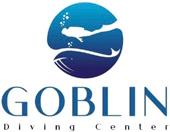
5 Dives Package to dive the East Coast’s dive sites. Includes tank and weights.
11. SANDY BEACH DIVE CENTRE | www.divesandybeach.com

Two tank boat dive on East Coast (Fujairah) with or without equipment, including tank and weights.
12. AL BOOM DIVING | www.alboomdiving.com
Two tank boat dive on East Coast (Fujairah) with or without equipment, including tank and weights.
13. NEMO DIVING CENTER | www.nemodivingcenter.com
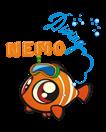
Two tank boat dive with or without equipment, including tank and weights.

14. SUNDIVE BYRON BAY | www.sundive.com.au
Destination Dive Package – A 2 day dive package for one person (up to 3 dives per day) at Julian Rocks Marine Park, Australia.
15. PADI (3 Prizes) | www.padi.com
PADI Digital Underwater Photography Course
16. DIBBA BAY OYSTERS | www.dibbabay.com
AED 200 dining voucher to the Dibba Bay Fishing Harbor outlet in Dubai.
72 DIVERS FOR THE ENVIRONMENT | MARCH 2023
UNDERWATER PHOTOGRAPHY
THE DIGITAL ONLINE JUDGES
DAVID SERRADELL Underwater Photographer and Veterinarian
With an eternal love for the sea and all its creatures, David grew up in Barcelona next to the shores of the Mediterranean Sea, where he spent more hours underwater than at the surface.
He practiced as a veterinarian in Spain while being in the water as much as he could, but soon moved to Baja California Sur, Mexico to follow his dream of working in ocean conservation and capturing it with his camera.


It was here that he further explored the path of underwater photography and videography. David wants to further promote the messages of marine conservation to protect the oceans that give life to us all.
YOUTUBE: www.youtube.com/@davidserradell
INSTAGRAM: www.instagram.com/dserradell_photo
DAVID DILEY | SCARLET VIEW MEDIA Filmmaker, Underwater Cinematographer and Digital Colourist
David is a multi-award winning Filmmaker, Underwater Cinematographer and Digital Colourist from the UK best known for his work with sharks and large marine megafauna as well as his multi-award winning feature documentary, “Of Shark and Man”. His profile has increased rapidly thanks to his work on a wide variety of projects for film and television, alongside his commercial work for a number of household brands.
David is the owner of Scarlet View Media, a high end boutique Production House in the north of England, and is a Panasonic Professional Ambassador and Angelbird Media Creative.
WEBSITE: www.scarletviewmedia.com
FACEBOOK: www.facebook.com/daviddileyfilmmaker
Wilson McCourtney is an underwater cinematographer, documentary filmmaker, and a wildlife conservationist.


Having grown up in Florida, he developed a connection with the natural world at an early age that has fuelled his creative career and solidified his mission in life which is to protect our oceans and save wildlife.
In 2020 he played an instrumental role in passing the Kristin Jacobs Ocean Conservation Act which outlawed the import and export of shark fins in Florida. He directed a feature film called “Fighting For Sunshine” which is about saving sharks in Florida, minimising the horrific effects of Red Tide, and rescuing pelicans from fishing line entanglement which is slated to be released in 2024. When he’s not underwater or fighting for the planet, Wilson spends his time in Portland, Maine with friends and family hiking in the woods and exploring the vast wilderness of the NorthEast.
YOUTUBE: www.youtube.com/wilsonmccourtney
FACEBOOK: www.facebook.com/wilson.mccourtney
INSTAGRAM: @dreamreefwilson | @dreamreefcinema | @fightingforsunshinefilm
Simone is an Italian underwater photographer, who has been awarded in several prestigious competitions and published internationally. After over 10 years of corporate life in Dubai, he moved to Australia where he co-owns and manages Sundive Byron Bay, a PADI 5 Star Dive Centre offering dives at the amazing Julian Rocks in Byron Bay. After travelling to and photographing many unique diving destinations worldwide, he also runs expeditions with Sundive to help others experience and photograph his favourite ones such as the Sardine Run and Djibouti. Simone was the Overall Winner of Digital Online for two consecutive years until he became a judge for the competition and has been a main feature contributor to the EDA magazine, ‘Divers for the Environment’.
FACEBOOK: www.facebook.com/SimoneCaprodossiPhotography
INSTAGRAM: www.instagram.com/scaprodossi
Mohamed is a son of the Arabian Gulf. Coming from a long line of legendary pearl divers and fishermen, a strong bond ties him to the deep blue. He started his passion as a freediver and a spear-fisherman at an early age and naturally fell in love with the beauty of the underwater world.

Mohamed started his underwater photography in 2008 which won him several awards and to which he has been published internationally since. His eye-catching and distinctive style is aimed at pushing the limits of how photographers represent life below the waves. Mohamed has dedicated himself to conservation and to the Art of Underwater Photography, putting forth the message, “The Ocean has given our ancestors everything, now it is our turn to give back”. As a marine scientist with a masters degree in Environmental Science, he works closely with sea turtles, dugongs, dolphins, sharks and all other exotic species, as well as being responsible for many rare scientific discoveries in the Arabian Gulf region. Mohamed is also a PADI Instructor, a PhD candidate at UAE University, and an affiliate at Mohammed bin Rashid Academy of Scientists (MBRAS).
INSTAGRAM: www.instagram.com/b47r
ALLY
Project Manager, Editor, Graphic Designer, Photographer & Videographer
Ally joined EDA in December 2004 when she created and introduced the organisation’s quarterly magazine, “Divers for the Environment”.

She played a central role in the development of Digital Online –EDA’s Underwater Photography and Film Competition from its launch in 2009, as well as introducing the film category as an extension in 2012 to share our underwater world through motion pictures, and has managed the event since inception. Today, Ally continues to oversee the EDA team and develop the brand, manages design and production of the magazine, handles photography and videography, and runs the organisation’s events and social media, all in the name of ocean conservation.
WEBSITE: www.emiratesdiving.com
INSTAGRAM: @emiratesdivingassociation | @eda_uae
73 MARCH 2023 | DIVERS FOR THE ENVIRONMENT
WILSON MCCOURTNEY
Underwater Cinematographer, Filmmaker & Wildlife Conservationist
MOHAMED ALMUSALLAMI Underwater Photographer and Marine Biologist
UNDERWATER PHOTOGRAPHY
LANDES | EMIRATES DIVING ASSOCIATION
SIMONE CAPRODOSSI | SUNDIVE BYRON BAY
Underwater Photographer

ANILAO
THE MACROFAUNA PARADISE FOR UNDERWATER PHOTOGRAPHY WORKSHOPS

FEATURE AND PHOTOGRAPHY MARWA EL-AGROUDY
As this trip was an underwater photography trip, there were workshops and photo review sessions to be done between the dives. As tiring as that was, especially with having 4 dives a day, it was rewarding.
When I first visited the Philippines in 2018, I wasn’t an experienced diver yet! I had recently been certified a PADI Advanced Open Water diver, and I only had a GoPro. I had no idea what nudibranchs or squat lobsters were. I still enjoyed the diving though so when my husband and I had the opportunity to go and dive in the Philippines, we simply jumped at it.
I knew how amazing diving in Anilao was, and how it is considered a haven for macro photography and muck diving, so I added it to my never-ending diving destinations wish list. When my husband and I had our minds set on the Philippines, Anilao specifically, we started weighing our options regarding where to go and where to stay. As this was a first for us, we ended up deciding on an underwater photography trip with a travel agency. It was our first time to go on such a trip and we were quite thrilled about the idea.
We had ourselves booked with Bluewater Photography & Travel for their annual Anilao
photography trip and their choice of accommodation/dive centre, was none other than the Crystal Blue Dive Resort which had come highly recommended by my Filipino diving friends.
The resort is nestled on a hill slope that overlooks the Balayan Bay offering incredible views of the bay and the surrounding islands. It has a dedicated camera room for photographers which makes it a lot easier for divers and their cameras. The rooms face the bay, and they come equipped with an AC and a ceiling fan so there is no compromise on comfort. There is also a spa and relaxation area for whenever you feel like kicking back to do just that.
Did I mention the sunsets already? The most beautiful ones I have ever seen. Additionally, you won’t need to worry about food and beverages as it is all covered. Believe me when I say that you won’t want to miss a meal during your stay at the resort. And on top of all of
that, the staff are the kindest and friendliest you could ever meet.
Diving in Anilao was unlike anything I experienced before. There are a lot of sites within the vicinity of the resort, and the number of different species one can see was mind-blowing. I ticked off quite a few of my list of species to see and photograph during that trip, and that included the hairy frogfish. Woohoo! And if you are a nudibranch fan, then Anilao is the place to go as nearly 500 species have been identified there alone. Now if that’s not exciting enough, then you might need to know that the resort holds an annual nudibranch festival where you can go and learn more about them and maybe document new finds. No wonder Anilao is called the nudibranch capital of the world.
Besides that, you can go muck diving which was a first for me. During my first muck dive, I asked myself what on earth were we doing on that sandy bottom dive site, what could we possibly

76 DIVERS FOR THE ENVIRONMENT | MARCH 2023 UNDERWATER PHOTOGRAPHY


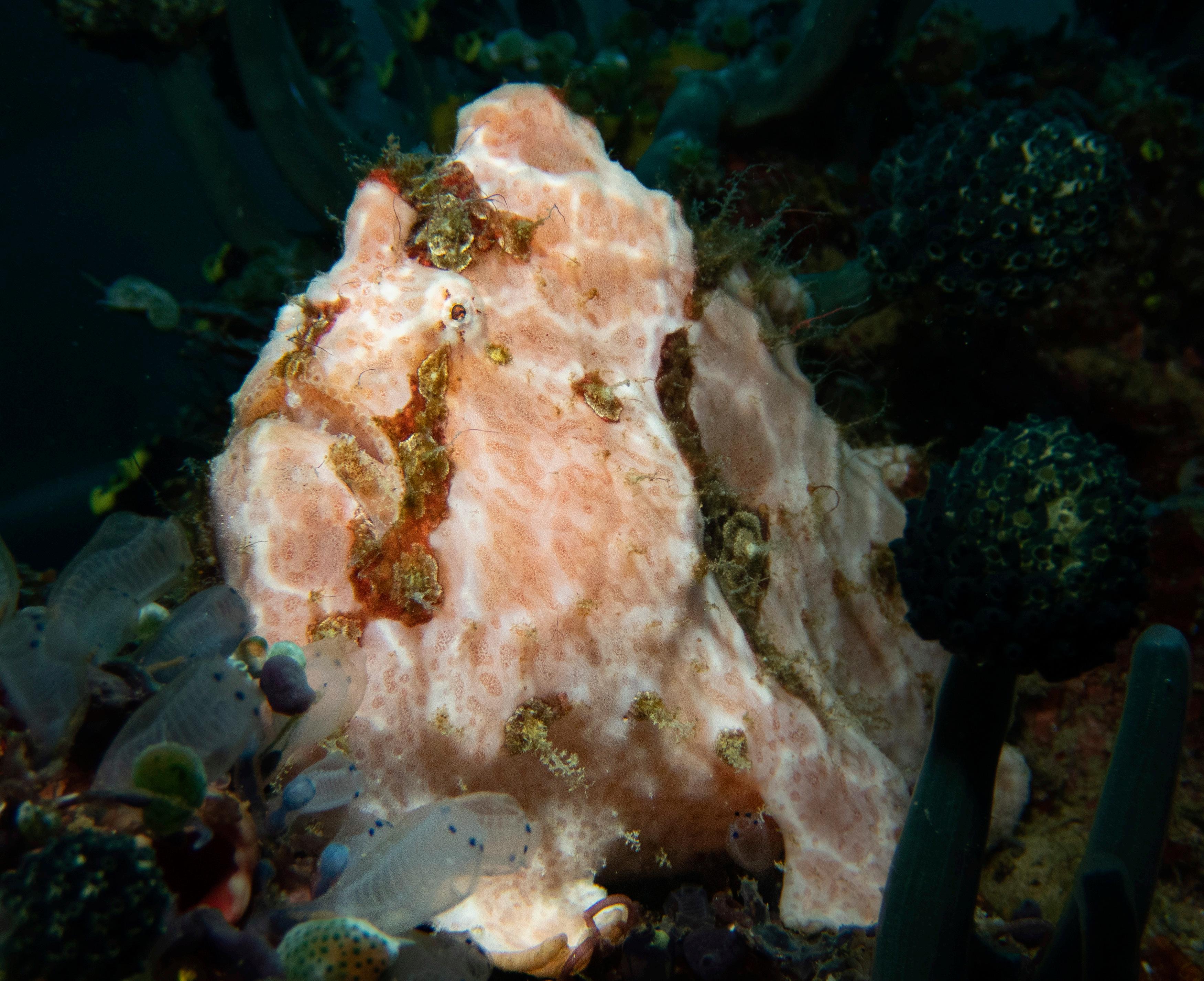
UNDERWATER PHOTOGRAPHY
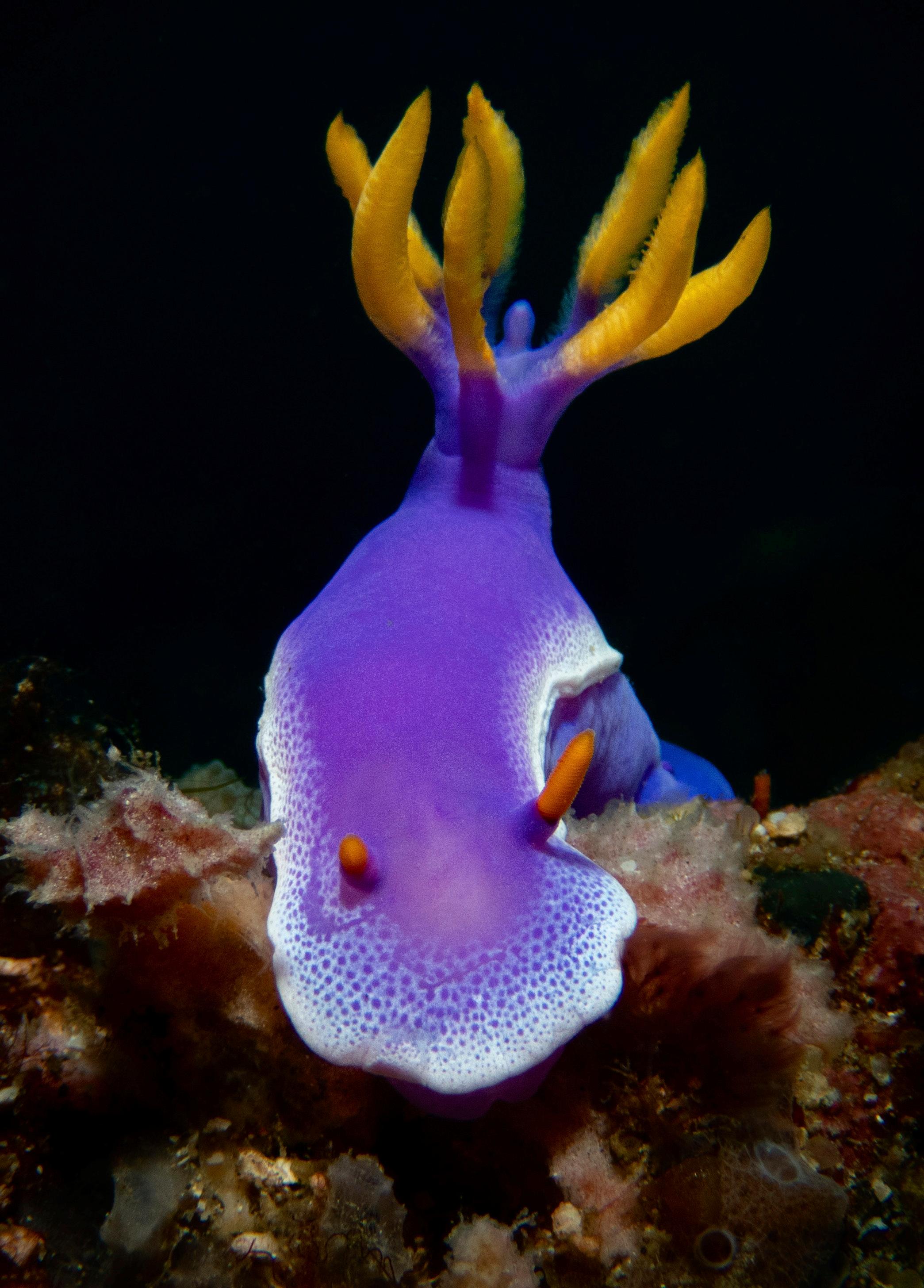
UNDERWATER PHOTOGRAPHY
see there? Let me tell you, there was a lot to see. I was totally taken by surprise at what the divemaster was able to spot in such terrain.
Another thing that the resort offers is blackwater diving where you get to see all those alien-looking creatures that only come out at night. For the dive, a rope is attached to a buoy where strong lights are hung along the rope every couple of metres and dropped into the water. Despite that it is easy to get disoriented because of the lack of reference points. You will be thoroughly briefed though, so there is no need to worry. I have to admit that taking photos and video was quite a challenge with my TG-6, but what was around me was amazing so I simply enjoyed it even if I couldn’t photograph it. I felt I was swimming in space. It was magical!
What I also love about Crystal Blue Resort and diving with them, is their 4 divers per boat policy which is great for photography because the dives are not rushed. What makes it even

sweeter, is that their divemasters are spotters, which means they are trained to look for the tiniest critters for you. How about that?



As this trip was an underwater photography trip, there were workshops and photo review sessions to be done between the dives. As tiring as that was, especially with having 4 dives a day, it was rewarding. The review sessions allow your photos to be critiqued offering constructive feedback regarding what is good, and what can be improved.
The workshops on the other hand, introduced you to lighting and photography techniques so there was always something new to learn, and I loved that. We had Helen Brierley as our trip leader, and she was amazing with her advice in photography and photo editing. Besides Helen, we also had Mike Bartick, the resort’s photography pro, and he was such a great help as well in many regards. I had not had any expectations about this trip really since I hadn’t been on one before, but I can honestly
say that it was both beneficial and enjoyable. So for divers who wish to up their game in underwater photography, a similar kind of a trip may not be such a bad idea.
In conclusion, whether you are looking to only dive, you want to concentrate on underwater photography, you want to try something new, or you just want to relax, Crystal Blue Resort has it all.
My husband and I had a wonderful time. I loved everything about the resort, and even when we weren’t diving, there was always something else to do. I know I will be back Anilao, and I can hardly wait.
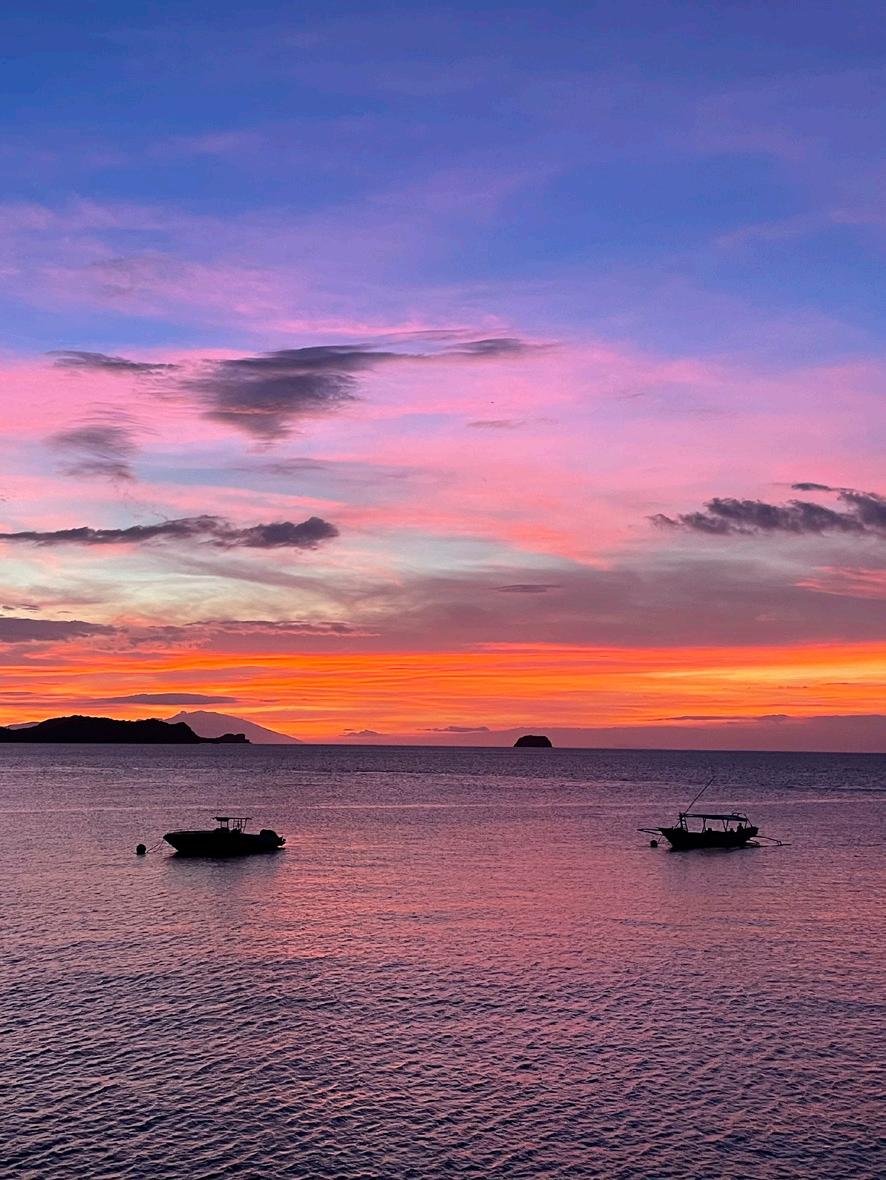
CRYSTAL BLUE RESORT
For more information regarding the Crystal Blue Resort’s diving packages and workshops, visit their website: www.divecbr.com


79 MARCH 2023 | DIVERS FOR THE ENVIRONMENT
UNDERWATER PHOTOGRAPHY
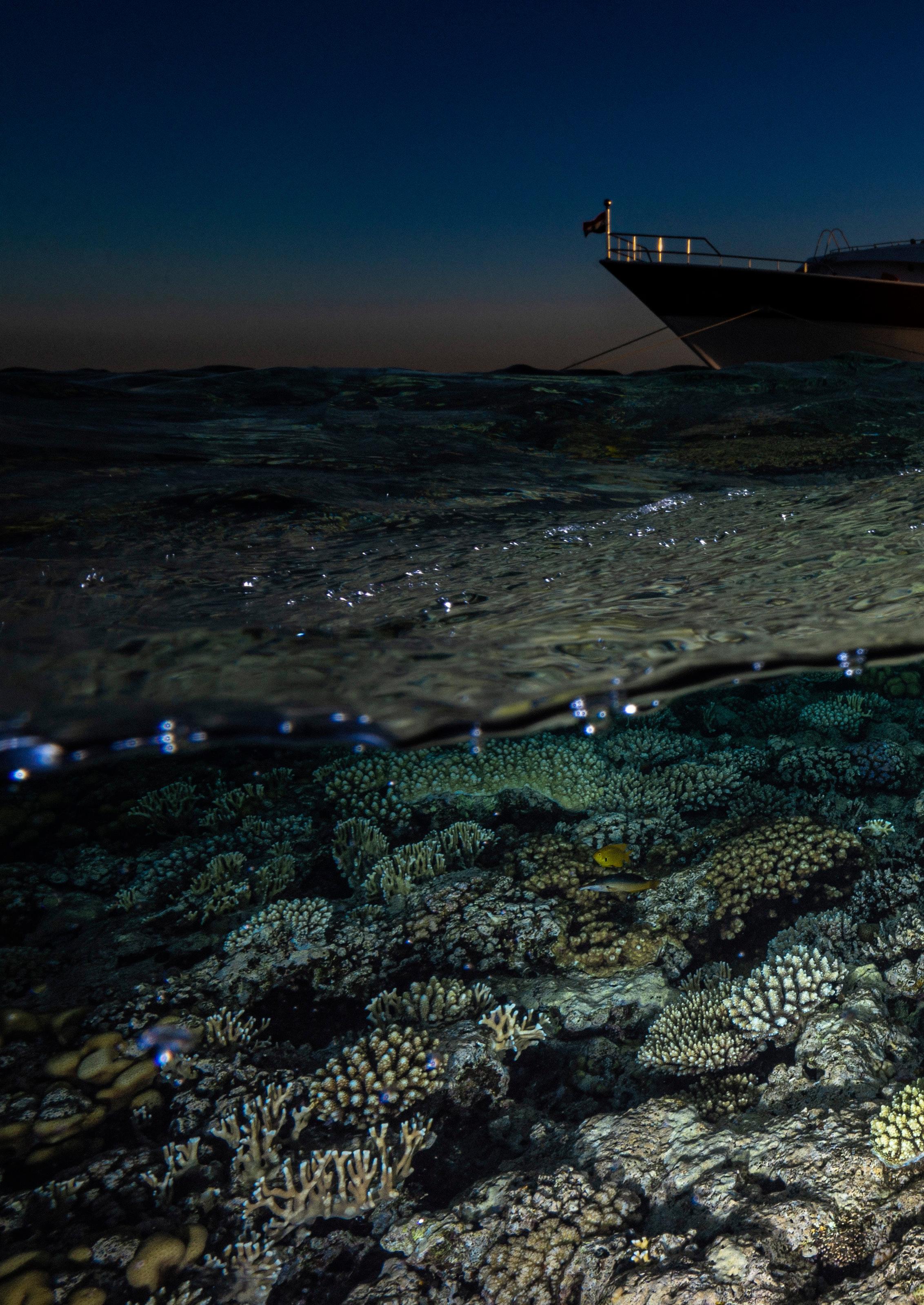
AROUND THE WRECKS & REEFS OF THE RED SEA

spectacular
FEATURE TONY SIDGWICK PHOTOGRAPHY TONY SIDGWICK & JON SHERMAN
Fantastic visibility,
reefs and legendary wrecks – the Red Sea is one of the world’s most popular diving destinations for good reason.
COVER PHOTO: Thomas Reef by Carlos Donoso Lillo – www.carludiveandtravel.com
Fantastic visibility, spectacular reefs and legendary wrecks – the Red Sea is one of the world’s most popular diving destinations for good reason.

For most divers, a trip to the Red Sea has become almost a rite of passage, but this is not the main reason for its significance. It has been a vital shipping route for centuries, with merchant vessels from East Africa and the Indian Ocean linking up with trade caravans in ports at the northernmost tip of the Gulf of Suez, who would then make the land crossing North to the Mediterranean by the shortest route across the Sinai Peninsula, or head west towards Cairo to link up with the Nile River.
With the opening of the Suez Canal in 1869, the Red Sea became the world’s most essential shipping route, allowing vessels to sail directly from the Indian Ocean to the Mediterranean without having to make the much longer journey around the African continent, and shortening the distance between the Arabian Sea and London by around 8,900km.
It’s importance to global shipping also means that it has been a hotly contested body of water in all major conflicts that have passed through the region, from the two World Wars to more recent regional disputes. As a result, many ships that fell victim to these conflicts are now incredible wrecks for divers to explore, the most famous being the SS Thistlegorm (more on that later).
Conflicts aside, as an extremely busy, yet
treacherous maritime passage, the Red Sea itself has claimed an astounding number of unwitting navy and merchant vessels across its hundreds of sand bars and reefs, many of which now sit only a few feet below the ocean’s surface.
However, the many reefs that make the Red Sea so treacherous are also what make it a spectacular diving destination, with several dive sites offering a tantalising combination of wreck and reef in one.
THE EMPEROR DIVERS WRECKS & REEFS LIVEABOARD
There are a range of options for Red Sea cruises from Emperor Divers, but we opted for one that we felt would offer the best of both worlds. Our journey departed from the Egyptian beach resort town of Hurghada, and took us across the Red Sea into the Gulf of Aqaba, past Sharm El Sheikh, before looping back down around the southern tip of the Sinai Peninsula, and then back down the coast to Hurghada – a voyage of five nights and six days.
Our experience was on the lovely Emperor Superior, a clean, comfortable and well-run trideck liveaboard yacht. The lower deck boasts the more affordable cabins with bunk layouts, whilst the main deck features the larger twin and double cabins, the dive equipment area and dive platform at the stern, as well as a large and comfortable salon where the briefings are held, the dining area and galley, which puts out very respectable Middle Eastern and international fare (honourable mention goes
to the falafels, which are on another level!).
On the upper deck is the outdoor bar and chillout area, and the more upmarket cabins, with double beds and ocean views, as well as the bridge and a forward lounge area, and on top of that is a spacious flybridge with the best views of the surrounding ocean.
Upon arrival, you’ll spend the first night in port whilst everyone arrives. Then, the following morning you’ll wait for the nod from the Egyptian Coast Guard before heading off into the Red Sea for your first day of diving.
DAY 1: FANOUS REEF AND DOLPHIN HOUSE
Our first stop was a reef a short voyage East of the Hurghada coastline called Fanous, so named after the small lighthouse which marks it out to passing vessels. It’s a pleasant introduction to the Red Sea experience with interesting reefs and good visibility, and we spotted a Frogfish and our first Blue Spotted Ray – a subtle hint of things to come.
Then we ventured on to Dolphin House, rather ironically named, as the site was decidedly cetacean-free on all our visits. It is nevertheless an enjoyable dive through a sandy-bottomed valley between two reef walls, to an expansive bed of impressive reef structures on the other end, before turning around and coming back.
In the absence of dolphins, you’ll have to instead turn a close eye on the reefs to spot the good stuff. Aside from the reef fish, we saw
82 DIVERS FOR THE ENVIRONMENT | MARCH 2023 DIVING DESTINATIONS
an octopus, a few morays and two colourful nudibranchs.
And a couple of Blue Spotted Rays.
We stayed moored to the reef for the evening, and did our first night dive at the same site. Though it was interesting diving in the very clear waters under the lights of the four dive yachts moored around us, the most interesting part was the two large lionfish which joined us for the entire dive, using our torchlights to hunt on the seabed. They followed us around like puppies, so we had to avoid descending too close to the bottom in case we bumped into one.
There were two Blue Spotted Rays sitting on the seabed under the yachts.

DAY 2: GEZIRA SEYUL AND THE DUNRAVEN
The next morning featured a jaunt northward to the Gezira Syul (Syul Island) Reef and Lagoon for the next two dives. On the first dive along the reef wall, we had our first encounter with one of the Giant Moray Eels which are native to the area. Though we’ve seen hundreds of morays in our years diving in the Arabian Gulf and Gulf of Oman, it was still breath-taking seeing these monstrous sea serpents up close. With a head the size of a melon, Giant Morays can grow to 3m long, and weigh up to 30kg. This reef also boasts some spectacular coral structures and plenty of colourful reef fish.

The boat repositioned itself into the lagoon
on the other side of the island for the next dive, where there were some more beautiful coral gardens, and the biggest stonefish we’d ever seen. Here was where we began to appreciate the fantastic visibility the Red Sea has to offer, with 30m of clear sea all around us for both dives.


Our next stop was our first wreck of the trip, and a fantastic way to kick off the wreck diving experience. A 19th century sail and steam cargo ship, the Dunraven struck the reef where it now rests in 1876. The collision tore the hull open and the crew abandoned ship before the Dunraven sank, rolling over to rest upside down on the seabed at around 30m depth at its lowest point.

Today, the hulk of its hull offers three main entry points at the bow, stern, and through a large opening in the middle around the engine room. We descended at the massive propellor and rudder and first penetrated at the stern, for a beautiful swim through the cavernous hull past the boilers and engine room, where you’ll encounter lots of lionfish and huge, glittering schools of silvery translucent glassfish, which are spectacular as they catch the light.
Then you exit at the bow, before swimming around the outside of the hull, where we saw a huge Napoleon Wrasse, before a gentle ascent up the reef wall, passing two large morays, some large groupers and beautiful corals along the way. One of the morays fixed me with an intense stare for a few seconds, and then barfed at me. I had no idea morays could barf. Fascinating.
DIVING DESTINATIONS
DAY 3: WOODHOUSE REEF & THOMAS REEF
Our next four dives would be spread across these two enticing reefs. Woodhouse Reef involves a fantastic wall dive with amazing visibility and beautiful coral gardens with some particularly large fan corals adding a real touch of spectacle. Curious pipe fish up to a foot long swam alongside our masks, dancing in and out of the bubbles from our regulators, and we also saw a few crocodile fish. However, for fans of the Blue Spotted Ray, this is the main event – we counted no less than 15 in one dive, with 5 of them all bunched together in one sandy patch.
Thomas Reef involves a deep wall to shallow reef dive, where you’ll get to see colourful reef fish gathering round cleaning stations for a quick once over from the tiny cleaner fish. The more adventurous divers can remove their regulator and let the little fish give their teeth a polish. This dive was also memorable as we

came across one of the huge Giant Morays out on a swim, which was truly a sight to behold!
DAY 4:
SHARK REEF AND THE YOLANDA
Shark Reef is a gorgeous drift dive along a towering wall reef, with plenty to spot as you pass by, not least the huge school of circling Big Eyed Jacks we descended into. At the end of the wall, you ‘hop off the conveyor belt’ onto a shallower flat reef, just past which the most unusual sight greets you: A single toilet, sitting alone and upright on the seabed, like Neptune’s own crapper. Further along the reef, you’ll realise that the first toilet is not, in fact, alone. There’s a whole pile of them, along with broken containers spilling their cargo of stacked bathtubs onto the ocean floor.
This is the spilled cargo of a Greek cargo ship, the Yolanda, that ran aground at Shark Reef in 1980. However, during a heavy storm in 1987 it fell off the reef and came to rest
below at 160m. Fortunately, it left its cargo behind at 20m, which worked out well for our underwater potty selfies!

Like the poorly named Dolphin House, Shark Reef was conspicuously free of sharks. Did see some Blue Spotted Rays though. After two dives here, it was back to the boat to transfer to the main event…
DAY 4 & 5: THE SS THISTLEGORM
A legendary dive site the world over, the SS Thistlegorm was a British cargo ship that was on its way to support the Allied war effort in 1941, packed bow to stern with military equipment across three decks. Trucks, motorbikes, boots, rifles, artillery shells and even whole steam locomotives filled the large cargo ship when it was happened upon by some opportunistic German Heinkel HE 111 bombers as they were on the hunt for a completely different convoy.

84 DIVERS FOR THE ENVIRONMENT | MARCH 2023 DIVING DESTINATIONS
Going after the biggest ship in the convoy, the unlucky Thistlegorm, they dropped two bombs on it, one of which started a fire in the cargo hold that quickly spread to the stored ammunition.
The explosion was catastrophic, folding a huge section of the inches-thick steel of the top deck back over on itself like cardboard, and flinging the two 70-tonne locomotives off the top deck like toys, which now rest about 30m away from her on the seabed. The blast almost tore the ship in half, to sink in a V-shape and come to rest on the ocean bed with a big void in its middle that offers some lovely penetration points for divers.
The Thistlegorm’s huge popularity owes to the fact that she sits at about 30m at her lowest point, making her accessible to most recreational divers. We were fortunate on our visit in that there were only three other liveaboards moored at the site, when often

there can be up to ten boats crowded around it. This meant that we didn’t have to contend with hordes of other divers packed into every nook and cranny of the wreck, making it a far more enjoyable experience.
Usually, you will complete two dives of this wreck, one to explore its interior, and the other to explore the exterior of the top decks and the surrounding debris field, including the two steam locomotives which now play home to a cluster of lionfish in the open cavities of their front boilers, alongside some morays and stonefish around their base.

During the descent, it’s important to hold on to the mooring line, as a strong current flows past the site that has whisked away several unwary divers over the years. Legend has it, according to our dive team, that one poor Japanese lady was found clinging to the base of one of the oil rigs that can be seen on the horizon about five kilometres away!
Due to its location and the currents, visibility isn’t great outside the wreck, although conditions improve as you get closer. We first descended into the big space left in the middle of the ship by the explosion. We instantly encountered two crocodile fish nestled in the debris, which consists of crates of ammunition, shells, boots and two Universal Carrier armoured vehicles tumbled amongst the wreckage.

Penetrating into the lower deck, you’re instantly treated to the spectacle of a cargo hold packed wall-to-wall with WWII trucks, some with motorcycles in their truck beds, others with crates full of rifles and boots. You’ll have to keep an eye out for the lionfish dotted about, and the keen-eyed divers will spot the occasional nudibranch clinging to a rusty truck.
You’ll do a full loop of the lower deck before ascending through the big cargo access hatch to the deck above for another loop, and then out to the top deck. By this time, it’ll be time to
85 MARCH 2023 | DIVERS FOR THE ENVIRONMENT DIVING DESTINATIONS
ascend up the mooring line for the safety stop.
For the second dive, we explored the ship’s top deck structures and exterior debris field. A good spot for a photo, if visibility permits, is the huge bow, which towers a good 40 feet above the seabed, and as already mentioned, the steam locomotives sitting on the seabed nearby.
Despite the huge popularity of this wreck, and its relative ease of access, this dive is NOT recommended for novices or those who suffer from claustrophobia. Ideally, you should have your Wreck Diving Speciality certification. With some of the deeper and more cramped parts of the wreck, with only about two feet of space between the trucks below and the steel beams above ready to catch your tank, and possibly having to contend with a wreck full of other divers, it is not a situation you want to freak out in.
One fortunate aspect is that, due to the site’s
popularity and thousands of divers visiting each year, the wreck has been finned almost completely free of silt, so you won’t have to contend with clouds obscuring your visibility at any point. It is, by most accounts, one of the most spectacular wreck dives to be found for recreational divers anywhere in the world.

We didn’t see any Blue Spotted Rays though, which was weird.
DAY 5:
GUBAL BARGE AND DOLPHIN HOUSE
After our morning dive, we left the Thistlegorm for a site called Gubal Barge, which is not much more than a rusted hulk surrounded by a shallow reef. However, what we initially anticipated to be a boring dive turned out to be great for ocean life.

As soon as we descended, we came across two big Crocodile Fish and a Stone Fish, and as we explored the rest of the reef, we spotted

a beautiful Electric Ray swimming along the seabed. And then for the main event, a big Eagle Ray about 3ft across came swooping right through our group, before looping round and doing another flyby. On the way back to the boat we spotted a couple more Stone Fish and an octopus. Overall, a great dive!
FINAL DAY:
DOLPHIN HOUSE, UMM KUMAR, AND EL MINA
Another fruitless attempt to see dolphins for our morning dive was redeemed somewhat by an incredible encounter with a curious octopus perched atop a coral. As we approached it, instead of hiding, it hopped off the coral and swam right past us, before landing on another piece of reef, and treating us to a spectacular colour show for a few minutes. Born for the stage, obviously…
As we made our way back towards Hurghada our penultimate stop off was Umm Kumar. On
86 DIVERS FOR THE ENVIRONMENT | MARCH 2023 DIVING DESTINATIONS
the reef side of the trip, this was the Grand Finale. A breath-taking wall dive with the most spectacular coral structures we’ve ever seen –towering hollow pinnacle structures, some as high as 50ft, absolutely teeming with life inside –lionfish, glassfish, morays – which could be seen through openings dotted around the structure.
Close to the base of the biggest tower was a cool cave with a nice swim through for great photos, and our last Giant Moray of the trip guarding the entrance. As we explored the reef wall nearer the surface, we had a close encounter with a big Titan Triggerfish, which thankfully decided not to take offence to our presence.

The last stop before returning to port is the El Mina wreck, an Egyptian minesweeper that was sunk just off the coast of Hurghada by Israeli fighter jets. There’s not much to say about this site other than it’s an interesting stop-off on the way home. The surrounding
coral bed is all but dead, but the wreck itself is an eerie reminder of the destructive power of modern weaponry. Lying on its side, you can clearly see where the blast from the missile that sunk it tore open the side of the ship, as well as the sizeable bullet holes from the jets’ machine guns. The wreck is too treacherous to penetrate, but you can easily point your torch into the many doorways and portholes on the main deck’s structures.
Then it’s back to the Superior for the short jaunt back to port, and a fond farewell to the excellent Emperor Divers team and the crew of the Superior who made the trip such a pleasure.

EMPEROR DIVERS LIVABOARDS

Got a question? Send them an email at reservations@emperordivers.com. www.emperordivers.com





DIVING DESTINATIONS
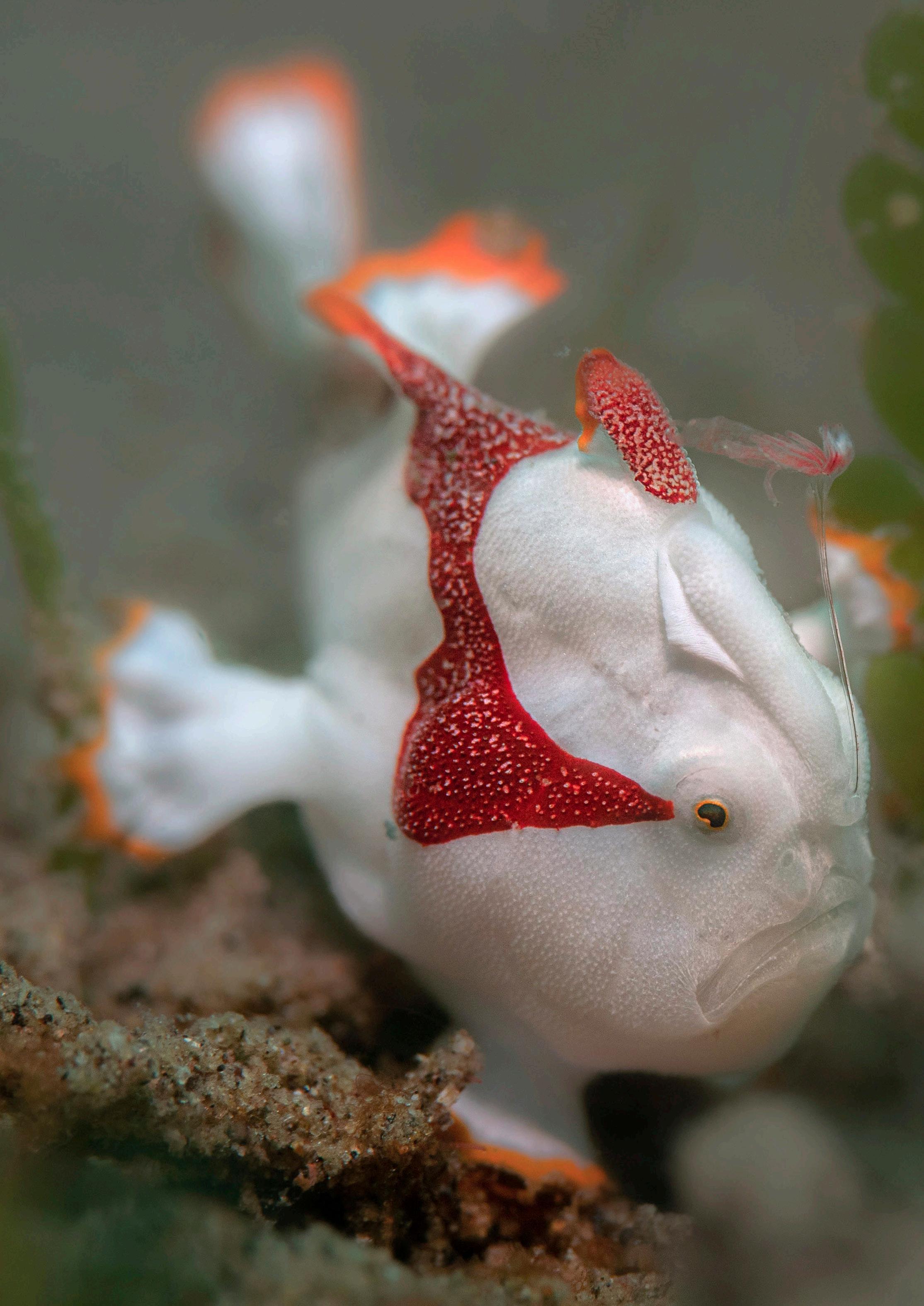
DAUIN
THE PHILIPPINE’S CAPITAL OF MUCK DIVING

FEATURE AND PHOTOGRAPHY ALDO GALANTE
It would be impossible for me to describe all of the marine species encounters I had on the sandy coast of Dauin. However, I can say that it is the place where the most frogfish can be seen on a single dive. All of this combined makes it the perfect diving getaway. We cannot ask for more from Dauin. It’s an extraordinary place!
COVER PHOTO: Warty Frogfish (Antennarius maculatus).
Dauin is a coastal municipality located 15km south of Dumaguete, on the island of Negros Oriental. You can get there via Dumaguete Airport from Manila or Cebu, and then drive for about 30 minutes until you reach Dauin. You can also reach Dumaguete by ferry from Cebu, Bohol or Siquijor, and from there it takes about the same amount of time by car to reach Dauin.
Diving is a major industry in Dauin. Several marine reserves and dive sites are located along the Dauin coast and on the Island of Apo, located off the coast. I have been very fortunate to visit the beloved Dauin several times since 2006. I have watched the growth of this area over the years, and in my humble opinion, I would say this is the capital of muck diving in the Philippines. It’s definitely the closest I’ve come to the Lembeh Strait, in Indonesia. That is why macro photography enthusiasts
and lovers of rare species, such as the critters found along the black sand shores of Dauin, return to this area whenever they can.


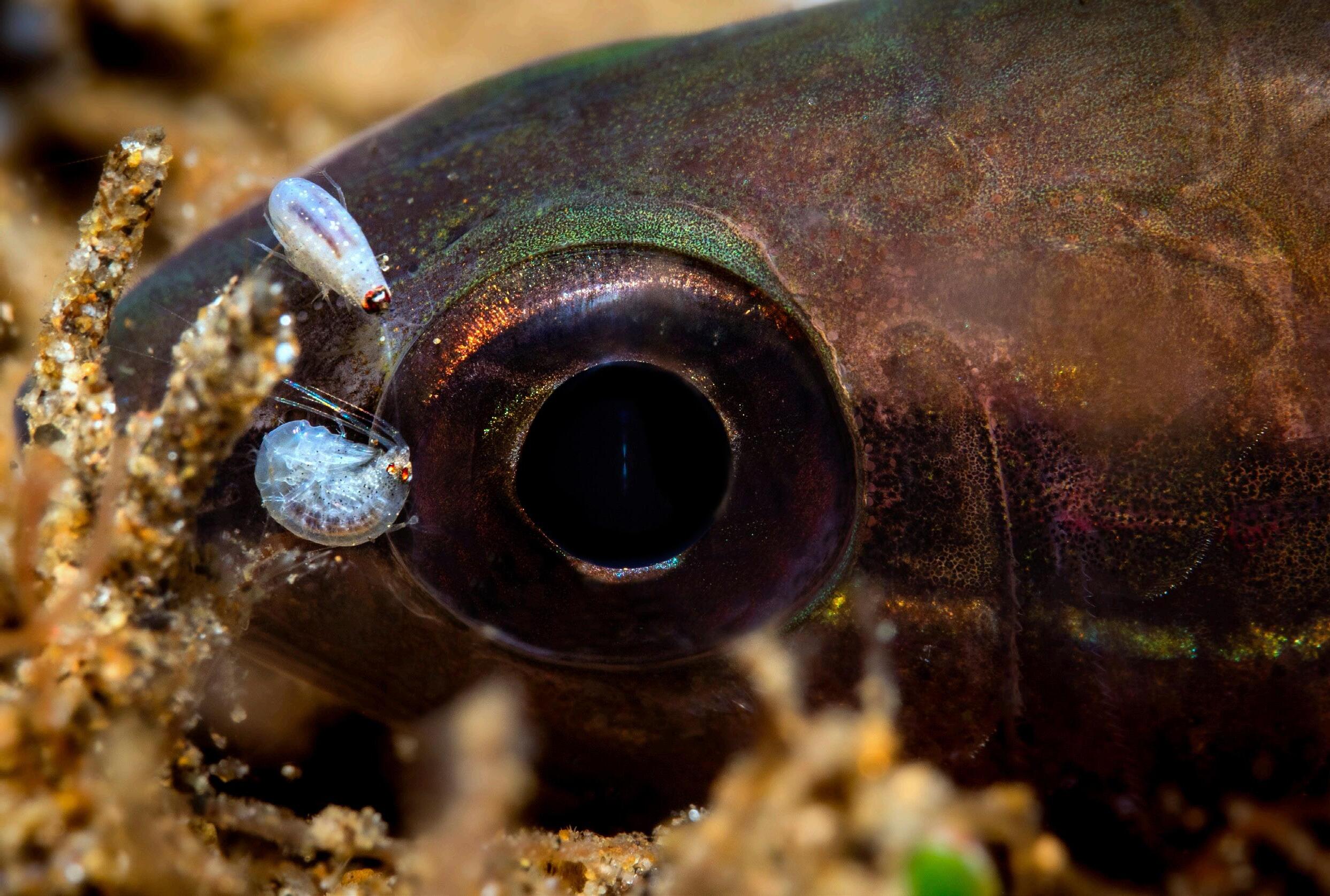
For my latest trip, I have to thank my experience to the Atlantis Dive Resort which I had won a prize for from the Hippocampus underwater photography competition I had taken part in along with other divers from all around the world. My prize was an all-inclusive week which included the accommodation, all meals, and unlimited diving.The hotel was beautiful and we got an amazing room overlooking the pool.
The hotel is fully equipped for divers and photographers of all levels, as well as for nondivers. My wife Luciana, who had a great time, enjoyed the beach, the pool, snorkelling at the house reef, she loved the beautiful spa and the delicious meals. The truth is, we fully enjoyed everything that the Atlantis had to offer.
DAUIN
As for diving, it is the coast of Dauin where muck diving (or diving in volcanic black sands) takes place. From Dauin, you can dive at more than 20 dive sites and they are all very close to the Atlantis hotel’s area, including their spectacular House Reef where I spotted two large Commerson Frogfish close to one another.
Starting from north to south, I could describe all the wonderful dive spots such as Mainit, San Miguel – north and south, Talisay, Sahara Point, Bonets Corner, Dauin Sanctuary – north and south, Ginama Point, Bahura, and Pyramids, but the one that deserves a special mention is Masaplod – north and south. This particular dive site gave us one of the best moments – perhaps the best of our lives. There are so many species to see, including seahorses, several types of frogfish (one of my favourites), wonderpus, mimic and blue ring octopuses;

90 DIVERS FOR THE ENVIRONMENT | MARCH 2023 DIVING DESTINATIONS
ABOVE L-R: A fish and its parasites; Warty Frogfish (Antennarius maculatus); A Whip Coral Goby (Bryaninops yongei) with a Wire Coral Crab (Xenocarcinus tuberculatus); A sea urchin shell (called a test) and a Glossodoris sp nudibranch. OPPOSITE PAGE: A trio of Ornate Ghost Pipefish (Solenostomus paradoxus).
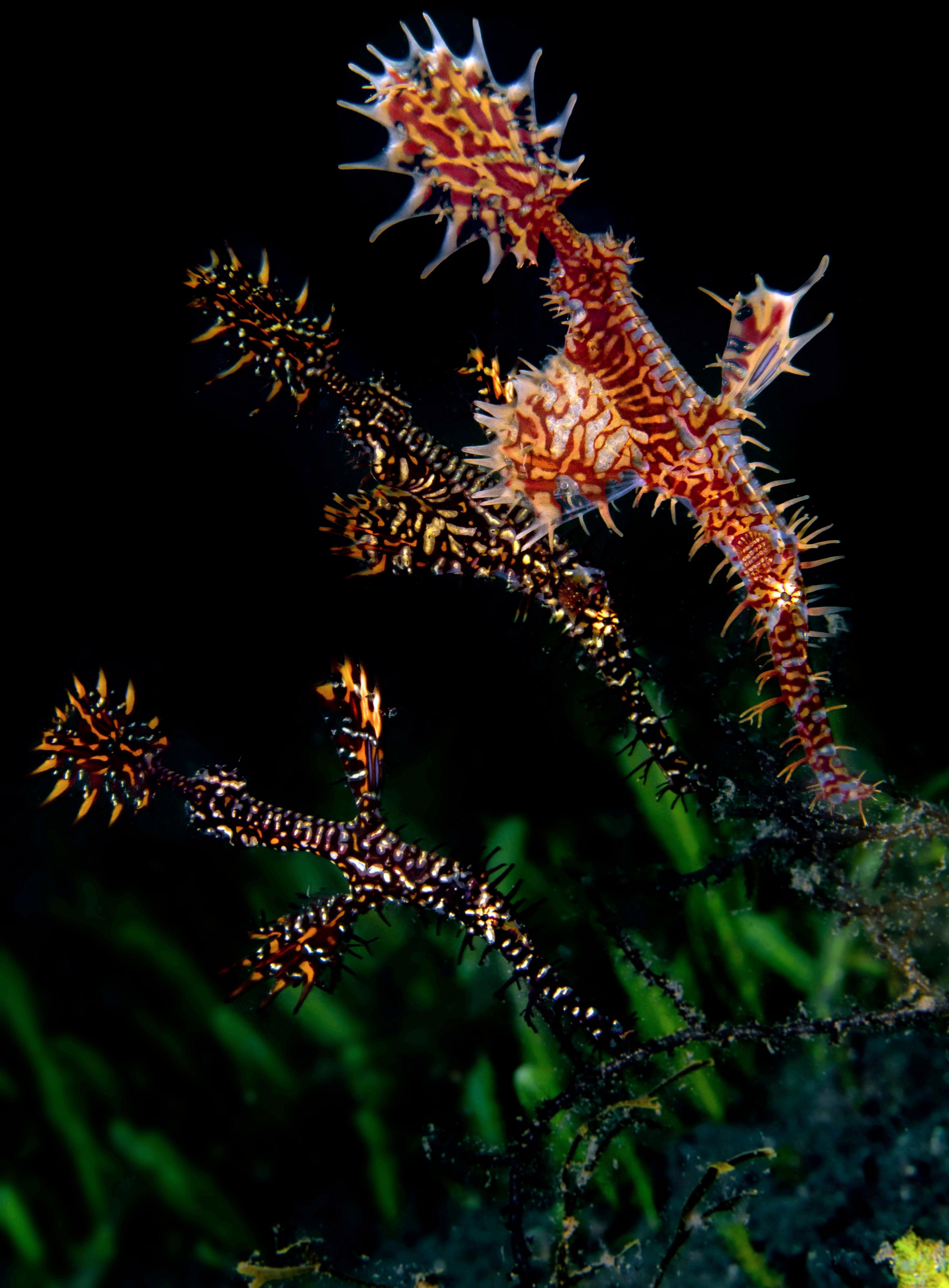
DIVING DESTINATIONS
in short it is an extraordinary place and it’s only 10 minutes away from the hotel. This dive site’s particularity is its sand. It’s very fine and somewhat paler in colour, so if you are not careful with the movement of your body and fins, you can easily spoil the dive for others by completely depleting the visibility.
APO ISLAND
For those who love majestic and colourful reefs, full of soft corals inhabited by sea turtles and pelagics of different species, then the island of Apo, about 12km from Dauin is the place to be. This is an iconic dive spot and one of the most famous in the Philippines. The healthy reefs around Apo Island boast over
400 documented species of corals – that’s 65% of the world’s corals found in one place! This island has several diving spots that are carried out according to the currents of the day, such as the famous Rock Point – east and west, Mamsa Point, Cogon Baluarte, Chapel Point, Coconut Point, Cars and Tires Point amongst others. Sadly, the dive site called Clownfish City, which I was able to dive in the past, was unfortunately deteriorated by a major hurricane that crossed the island a few years ago. The rest of the reefs in Apo remain splendid, clean and vibrant.
The Atlantis Dive Centre also runs a day’s excursion that takes place on a traditional

local boat with comfortable seats and a bathroom on-board. You will enjoy 3 dives at the island. It includes lunch and drinks, and you will return back to the resort at about 4pm, thus concluding a perfect day with a memory full of underwater images.
In addition to the Island of Apo, the dive centre also organises night and Blackwater dives on demand; as well as day trips to the nearby island of Siquijor (about 20km away by boat) to enjoy its vibrant walls full of soft and hard corals.




OSLOB
If you like whale sharks, there is also the
92 DIVERS FOR THE ENVIRONMENT | MARCH 2023
DIVING DESTINATIONS
ABOVE L-R: Magnificent Anemone Shrimp (Ancylomenes magnificus); Crab species not identified; Candy Crab (Hoplophrys oatesii); Verconia romeri nudibranch; Harlequin Shrimp (Hymenocera picta).
possibility to do a full day’s excursion organised by the hotel to neighbouring Oslob (on the Island of Cebu), where diving and snorkelling with the whale sharks is a guarantee.
It would be impossible for me to describe all of the marine species encounters I had on the sandy coast of Dauin. However, I can say that it is the place where the most frogfish can be seen on a single dive. All of this combined makes it the perfect diving getaway. We cannot ask for more from Dauin. It’s an extraordinary place!



THE NON-DIVING
But it’s not all about the diving here. You can

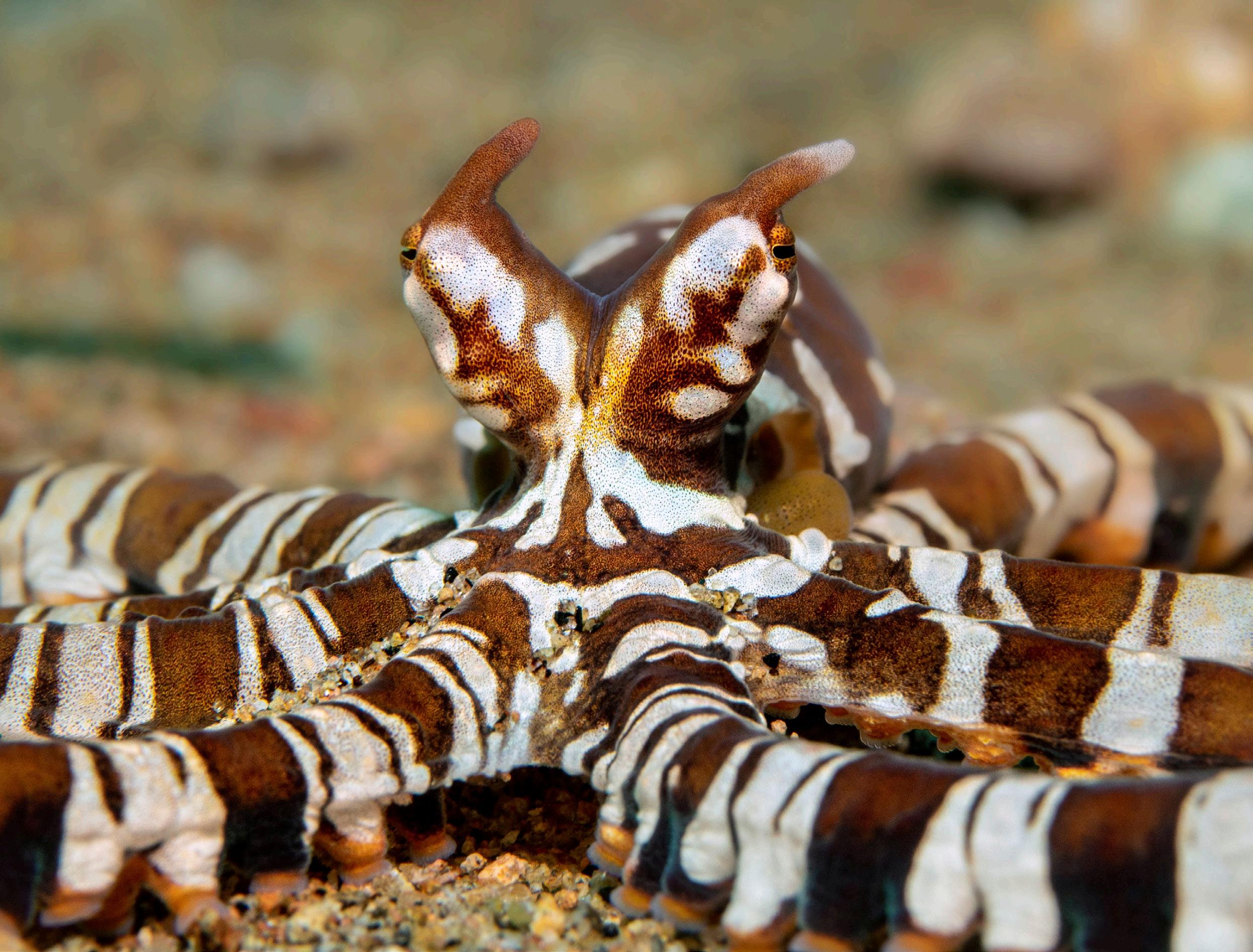
also visit the old Church, the market, the waterfalls of Casaroro, go mountain trekking, visit its black sand beaches and its white sand beaches in the southern area of Dauin at Zamboanguita and Siaton, in addition to those of Apo where you can snorkel in all the different spots.
Walking around Dauin is very interesting and you can enjoy the excellent cuisines at the restaurants and bars such as Fin Bar, Lokal Resto, Anahaw, Soga and Frontemare, the exquisite Italian pizzeria located right on Dauin beach.
If you have time, I also recommend a visit to Dumaguete to see its waterfront and market
where delicious seafood caught in the area can be tasted.
In short, I fully recommend this remote diving destination to anyone who has the possibility to travel there. If you want the 5 star experience, I strongly suggest staying at the Atlantis Dive Resort (https://atlantishotel.com/dumagueteresort) where everything is customised for your personal experience, from the welcome, to the farewell. It’s hard to leave after having spent an incredible week in a beautiful room with 5 daily dives (all on Nitrox), and having tasted the best culinary delicacies every day.
Until the next dive!
93 MARCH 2023 | DIVERS FOR THE ENVIRONMENT DIVING DESTINATIONS
ABOVE L-R: Wonderpus Octopus (Wunderpus photogenicus); A species of Dragonet; Hummingbird Bobtail Squid (Euprymna berryi); Innerspot Sandgoby (Fusigobius inframaculatus); Seahorse species not identified.


NEW YEAR, NEW YOU, NEW PLANET! HOW TO TURN YOUR PASSION FOR PARADISE INTO POSITIVE OCEAN CHANGE FEATURE PADI This year, join PADI in helping to create better conditions for our global population, help local communities flourish and help restore our shared blue planet. COVER PHOTO: Fiji by Markus Roth.
“If SUSTAINABLE TOURISM, which aims to counterbalance the social and environmental impacts associated with travel, was the aspirational outer limit of ecotourism before the pandemic, the new frontier is REGENERATIVE TRAVEL, or leaving a place better than you found it” – New York Times
This year, join PADI in helping to create better conditions for our global population, help local communities flourish and help restore our shared blue planet.
“It’s time to evolve from the concept of doing no additional harm to healing our blue planet. Regeneration is just that. It is the continual cycle of rebirth, of revitalising our synergistic relationships with one another, and of restoring our planet and all the species that call it home.
By healing local communities, establishing a collaborative relationship with nature and, most importantly, shifting our collective perspectives to one of giving back – rather than taking – we can regenerate our watery home. To have a future, it must be our future”
– Julie Andersen, Global Director of Brand for PADI Worldwide
PADI’S TOP SIX REGENERATIVE DESTINATIONS
The next time you choose to travel, why not commit to booking that epic bucket list adventure and supporting local conservation at
the same time? You can even offset your carbon usage from flights thanks to PADI’s travel programme. PADI has partnered with The Ocean Foundation to support The SeaGrass Grow Programme, empowering you to mitigate the carbon from your next holiday.You can donate to the programme every time you book a trip with PADI Travel, or simply make a donation seagrass offsets your carbon usage.
These beautiful spots, where tourism spending benefits local conservation, will give you hope for our blue planet. So, by travelling to these local destinations, you are supporting their conservation efforts.
1. REVILLAGIGEDO ISLANDS, MEXICO
If you dream of magical manta encounters and being surrounded by schools of hammerheads while being buzzed by an orca, then the Revillagigedo Islands are perfect for you. Affectionately known as the Galapagos of Mexico, it is a diver’s paradise – and a UNESCO World Heritage site. Drop in on Roca Partida and often you’ll have to choose between swimming with a school of giant tuna, being surrounded by Galapagos and Silky sharks, or meeting a whale shark. You can literally choose your own adventure.

Sail to the most well-known of the island chain, Socorro, on a liveaboard this spring for a chance to witness the pelagic lover’s paradise. As the seasons transition from winter
to spring, lucky explorers get the chance to have intimate encounters with manta rays, bottlenose dolphins who seek out divers for some playful interactions and games they’ve created entirely unique to the pod, and even the occasional humpback whale off the coast of Mexico. Getting to the remote Socorro Island is easier than you may think. Simply hop on a direct flight to Cabo, Mexico and then board your PADI Liveaboard.
Making a Positive Impact: Scientists have discovered through tagging – many of the same animals found in these waters migrate between Galapagos and Coco Island as well – moving from seamount to seamount. This in part helped drive protection for the threatened pelagic species. In 2017, 148,087 square kilometres (57,177 square miles) was declared a marine park – Mexico’s largest fully protected marine reserve, free from fishing and other extractive activities. Diving fees are a considerable source of income for the protection of the park.
2. SOUTH AFRICA
If you are looking for the ultimate land and sea safari, then South Africa is the perfect location for you. Consider summer – for great weather as well as sea conditions in both Cape Town and Durban.
Head south to Cape Town to snorkel – or dive – with the playful fur seals of Hout Bay hiding
96 DIVERS FOR THE ENVIRONMENT | MARCH 2023 DIVING DESTINATIONS
Manta Ray by Jay Clue
amid the kelp or head out on a cage diving expedition to meet their arch enemy… the Great White Shark. From sunrise breaches, to sunset spy hops, you’ll never forget your encounter with the “white pointers” in the shark capital of the world. And while the Great Whites get all the attention, you’ll be absolutely enthralled with the over 100 other species – many of which can only be found in South African waters. We especially love the antics of the Pajama Shy Sharks in the gorgeous bull kelp forests.
The south coast of Durban offers incredible diving that is a tad bit more tropical (by about at least 25 degrees) than the cold waters of Cape Town. Visit Aliwal Shoal to swim with their resident Tiger, Bull, Oceanic Blacktip and Dusky sharks in some of the most epic shark diving in the world. Not a diver? No problem!
You can snorkel with these sharks as well. The Shoal offers amazing diving and a cast of characters from friendly leatherback turtles to massive brindle bass. Further north is Sodwana, a largely untouched divers paradise where beach launches (and landings) are as exciting as the residents. Pods of dolphins, whale sharks, large schools of fish, manta rays and even the occasional white shark can be found on the many dive sites in the area. Both are marine reserves (part of South Africa’s 42 reserves) ensuring you are supporting the local protection of these amazing spots.
Making a Positive Impact: South Africa was the first country to protect Great White Sharks – and cage diving contributes more than 74 million rand to the economy – truly making sharks more valuable alive, than dead. Terrestrially, though not as well-known as Kruger, KwaZulu Natal offers some fantastic safari adventures – and can easily be part of a trip to Aliwal Shoal or Sodwana.We particularly love Manyoni Private Game Reserve also known as Zululand’s Rhino Reserve – and is a leader in rhino species conservation. Not only do you have the chance to encounter black and white rhino, you can also participate in –and support – rhino conservation. Your South Africa spring diving experience can be booked with 36 PADI Dive Centres

3. FIJI
Those looking for great visibility and exciting marine animal action should head to the warmer waters of Fiji any time of the year!
Of the 333 islands to choose from, Beqa Lagoon off the coast of Vitu Levu in Fiji offers a shark haven where in just one dive you can see bull sharks, whitetip reef sharks, blacktip reef sharks, nurse sharks and even tiger sharks! And making this event even more magical is that the massive shark gatherings will take place amongst the vibrant hues of healthy coral.
Fiji is known for its massive amount of marine species as well as being the “soft coral” capital
of the world. From pristine reefs first explored by Jacques Cousteau, to areas still remaining to be discovered, you’ll be delighted by the incredible colours of the swaying coral and visits from blue ribbon eels, manta rays, school of bumphead parrotfish, and even pilot whales.
Making a Positive Impact: Fiji is once again open to international travellers and offers the chance to witness one of the world’s prime examples of the soft-coral ecosystem, known as Rainbow Reef. But it is not just colourful reefs that make Fiji such a special place to explore this spring. A recent study in Fiji found that bull sharks form friendships with each other! Researchers studied data collected over 3,000 shark dives in Fiji’s Shark Reef Marine Reserve (SRMR), one of the world’s most sought-after diving destinations. SRMR is located in the Beqa Channel, off the southern coast of Viti Levu, and is a striking example of collaboration for conservation.
The shark is revered by local Fijians and legend has it that Dakuwaqa, the ancient shark god, provides protection for the people when at sea. So not only will you be exploring Fiji’s underwater world with your dive buddy, but you will likely encounter a pair of bull shark BFFs on your dive too!
4. THE BAHAMAS
Or, head to the Caribbean, where the Bahamas plays hosts to some of the most spectacular mega-fauna in the world.We love the trifecta… Bimini, Grand Bahamas and Tiger Beach.
Plan a trip to Bimini to catch up with bull sharks, hammerhead sharks, friendly dolphin pods, and graceful schools of eagle rays. You’ll feel like you stepped back in time to an island still not heavily commercially developed and traversed by golf carts. Bimini can be explored by divers and snorkellers alike – and is absolutely stunning above and below the surface. Head to nearby Honeymoon Beach to swim with the local group of rays and don’t miss some of the wrecks sunk as artificial reefs which are always hosts to large schools of colourful fish.
Grand Bahamas offers a larger island vibe with incredible shark dives, gorgeous coral structures, turtles by the dozens and plenty of reef fish. It also features a freshwater cavern and cave system that is still being explored.
From Bimini or Grand Bahamas, you can head to the most spectacular tiger shark gatherings in the world. Tiger Beach offers the chance to take part in some of the greatest shark diving experiences in the world. You’ll get up-close encounters with not only tiger sharks but lemon sharks, the occasional hammerhead and plenty of whitetip reef sharks in the crystalclear azure waters that only an aquarium can top in terms of visibility.
Making a Positive Impact: The Bahamas is a
97 MARCH 2023 | DIVERS FOR THE ENVIRONMENT DIVING DESTINATIONS
Photo by Jay Clue
model in shark conservation, with incredible research coming out of the home of “shark week”. Like the fact that scientists discovered this summer at the Shark Lab that sharks form lifelong bonds and have complex social structures – they are literally the opposite of mindless predators! In addition, the Bahamas have created the first shark sanctuary in the Atlantic Ocean in 2011, with over 40 shark species now residing in the 630,000km of protected area. This has ultimately helped shark tourism in the Bahamas contribute to $100 million in the economy every year – and has also kept their conch and lobster industries flourishing thanks to a healthy ecosystem full of apex predators. Why not meet some toothy new friends in the shark diving capital of the world while contributing your tourism dollars to a country that is a leader in marine conservation? Your Bahamas diving experience can be booked with 19 PADI Dive Centres.
6. GALAPAGOS ISLANDS, ECUADOR
The Galapagos Islands, a naturalist’s dream destination, are found over 600 miles (1,000 kilometres) off the west coast of Ecuador. Despite easy access by plane, the Galapagos are a wild wonderland, full of endemic species both above and below the water. Marine iguanas, Galapagos penguins, sea lions and Galapagos sharks along with schooling hammerheads, whale sharks, manta rays and mola mola are the delight of scuba divers.
While diving in the Galapagos off the coast of Ecuador is fantastic all year long, May offers a unique opportunity to truly see it all. This is because May brings calmer, warmer and more clear waters to this world-famous dive site. As a result, the Galapagos – which is one of the most protected places on Earth – is teeming with large schools of hammerhead sharks and manta rays, in addition to sea horses, turtles, penguins, sea lions and marine iguanas. Where else can you dive with a dinosaur?
Dive sites in the Galapagos tend to be volcanic in nature with a few corals scattered here and there. Channels around the islands boast heavy currents which work like pelagic highways. Because the best dive sites in the Galapagos are distant (as is the case of Wolf and Darwin Islands) or spread out, joining a liveaboard is the best way to fully experience the archipelago
There is literally no place more spectacular underwater than remote Darwin and Wolf islands in the Galapagos. And you can only reach them on a boat. On the far outer reaches of the archipelago, Darwin Island and its famous dive site, Darwin’s Arch, are the highlight of any liveaboard tour in the Galapagos. Manta rays, sea turtles, dolphins, eagle rays and the occasional whale shark wow divers with their presence. The real showstopper are the huge number of sharks
brought in by the strong current. You’re likely see schools of hammerheads, silky sharks, blacktip sharks and Galapagos sharks.
Making a Positive Impact: The Ecuadorian government has just established over 60,000+ kilometres of new marine reserves in the Galapagos. Plus, four Latin American countries have come together to ban all industrial fishing between Mapelo, Galapagos and Cocos – providing an additional 500,000 square kilometres of protected waters for the hammerhead sharks, turtles, tuna and manta rays that frequent these waters. A trip here in 2022 not only supports the country’s ecotourism efforts, but further supports expanding the protection of this world heritage site. Your Galapagos diving experience can be booked with 5 PADI Dive Centres.
EPIC DIVES THAT SHOW OFF THE BEST OF OUR SHARED BLUE PLANET
This year, take your new skills and explore some of the best places our shared blue planet has to offer. Here are PADI’s top picks for the best dive sites of 2023.

1. BAJO ALCYONE: Cocos Island, Costa Rica
Cocos Island, which lies far from the Costa Rican Pacific coast, is only accessible by liveaboard but is consistently ranked as the top destination in the world for hammerhead diving with this world-class dive site. The
98 DIVERS FOR THE ENVIRONMENT | MARCH 2023 DIVING DESTINATIONS
The Galapagos by Neil Andrea
seamount known as Bajo Alcyone rises to 82 feet (25 metres) below the surface and is regularly home to large shoals of hammerhead sharks. The diving can be tricky, but the plan is simple. Divers descend to the top of the seamount, wedge themselves between the rocks and watch the action above. This is truly an epic site and worthy of a place on the list!
• Dive Type: Shark
• When to Go: June to November for the best marine life. December to May for the best water conditions.
2. SS THISTLEGORM: Ras Mohammed, Egypt
The best wreck dive in the world, the SS Thistlegorm lies in the northern section of the Red Sea. As a popular day trip and liveaboard stop, it’s easily accessible from Sharm El-Sheikh. The wreck itself was a 420 foot (128 metre) British transport ship. Unfortunately, she met her fate in 1941 when she was sunk by a German air attack.Today, she remains a window into history with a visible cargo of trucks, jeeps, motorcycles, tanks and even a locomotive.
• Dive Type: Wreck
• When to Go: March to May; September to November
3. BLUE CORNER: Ngemelis Island, Palau
Blue Corner is a dive for the ages. It consists of a reef-covered wall that runs along the side of Ngemelis Island in Palau. While the dive is great at any time due to the massive schools of fish, this dive site shows its best face when the currents are strong (think more current, more fish – it’s never been more apt). Divers use reef hooks to carefully attach to the wall and watch a number of pelagic species swim past. Common sights include tuna, sharks and eagle rays. Many Blue Corner alumni claim that they have never seen so many sharks on a single dive.
• Dive Type: Drift
• When to Go: November to May
4. MANTA NIGHT DIVE: Kona, Hawaii
Certainly one of the most unique night dives, the Manta Night Dive is a ballet for manta rays Just off the coast of Kona is an artificially illuminated area where divers descend to the sandy observation areas. As the light attracts plankton, mantas arrive to take advantage of the feast. All the divers need to do is relax and enjoy the show while the graceful manta rays turn and spin overhead.
• Dive Type: Night
• When to Go: April to October
5. CENOTE ANGELITA: Tulum, Mexico
There are thousands of cenotes scattered throughout the Yucatan Peninsula of Mexico, and many of them could easily find a spot on this list. But the mystical quality of Cenote Angelita makes it hard to ignore. At approximately 100 feet (30 metres), the clear freshwater is
separated from the saltwater below by a layer of hydrogen sulphate. The appearance of this cloudy substance is otherworldly and makes for fantastic underwater photography.
• Dive Type: Cave
• When to Go: May to September
6. TIGER BEACH: Grand Bahama Island, Bahamas
Known for shark diving, the Bahamas is a wonderland of fantastic dive sites. While you can swim with hammerheads, oceanic whitetips, and reef sharks, at Tiger Beach, you’ll find daily encounters with tiger sharks. Several large sharks show up daily for their provided feast. While you wait on the sandy bottom, the sharks circle around the group dining on the chum. There’s also a chance to see nurse, lemon and Caribbean reef sharks at this famous Bahamas shark dive site.
• Dive Type: Shark
• When to Go: October to January
7. SECRET BAY (MAINIT MUCK): Anilao, Philippines
A wonderland for macro lovers and underwater photographers, Secret Bay, or Mainit Muck as it’s known locally, is a must-dive site in the Philippines. This site is quite shallow at between only 10 and 70 feet (3 and 21 metres), but it is abundantly productive for macro marine life and critters. Many divers have reported sightings of mantis shrimp, rare nudibranches, gobies of all types, and even wonderpus octopus. The site is also a fantastic night dive when Ambon scorpionfish, bobbit worms, seahorses, frogfish, and other nocturnal species become active.
• Dive Type: Muck/Macro
• When to Go: October to May
8. SILFRA FISSURE: Thingvellir National Park, Iceland
Diving between continental plates may sound
risky, but scuba divers flock to Silfra Fissure year-round for the pleasure. Granted, these plates are moving so slowly, that you will never know it. With 300 foot (100 metre) visibility, exploring the space between the North American and Eurasian tectonic plates is a dream. Glide along with the aquatic grasses full of blues and greens before snapping a picture between the rock faces of the plates.
• Dive Type: Freshwater
• When to Go: June to September for the best conditions; October to May for fewer crowds
9. SARDINE RUN: Agulhas Bank, South Africa
Certainly an adventurous dive, the sardine run attracts pelagic-loving scuba divers to South Africa on an annual basis. During a few weeks from May to July, millions of sardines swim up the coast in order to reach Durban where they spawn. On the way, many predators wait to feast on the tiny fish. These larger animals include dolphins, birds, sharks and whales. Diving the sardine run requires patience as dive boats spend many hours on the chilly seas searching for bait balls. When one of these congregations is finally found, divers jump in quickly to see the feeding frenzy.

• Dive Type: Pelagic
• When to Go: May to July
10. CAPE KRI: Raja Ampat, Indonesia
Raja Ampat seems to be on every diver’s bucket list these days. There is good reason for it, and Cape Kri is one of the dive sites that put this region on the map. A few years ago, scientists recorded the most fish species on a single dive at this site. The diving conditions at Cape Kri are suitable for all levels. You just need to dive into the warm water and slowly glide along the healthy coral reef, taking in all the colourful life around you.
• Dive Type: Coral Wall
• When to Go: All year round
99 MARCH 2023 | DIVERS FOR THE ENVIRONMENT DIVING DESTINATIONS
Pod of Dolphins in Egypt | PADI
PUSHING THE ENVELOPE:
Deep rebreather divers are not just exploring new and rarely visited dive sites, they are also entering uncharted territory when it comes to the physiological effects of such dives. Two recent studies by hyperbaric researchers, among them DAN Europe’s own Costantino Balestra, are contributing to a small but growing trove of data.
Unlike open circuit divers, who are limited to whatever fixed gas blends they are carrying in their cylinders, closed circuit rebreather (CCR) divers have the ability to manage the composition of their breathing gas during the dive.They use this ability to maintain an optimal partial pressure of oxygen (PO2) and thereby minimise their inert gas loading. As a result, using a CCR enables shorter decompression times when compared to open circuit scuba.
In addition, being on a CCR drastically reduces the amount of gas a diver uses – an important factor considering the difficulty and cost
of obtaining helium in many regions of the world. All these factors have contributed to making the shift from open circuit to CCR an important trend in technical diving over the past two decades. New manufacturers of rebreathers and electronic controllers have entered the market, CCR technology is maturing and becoming more reliable, and deep CCR dives are becoming more common.

However, there is a catch. Our knowledge of decompression and other physiological aspects of immersion relies heavily on data from a very large number of dives, the vast majority of which is relatively shallow. At depths down to 50 metres, we have a pretty accurate idea what works and what doesn’t for the average person. With increasing depth however, data becomes more scarce. Although there is a solid body of research from commercial and saturation diving to great depths, the conditions under which these dives are conducted are very different from the “bounce” (i.e., surface-
to-surface) dives performed by technical divers, so that the insights from this research have only limited applicability.
The decisions on decompression procedures made by deep technical and CCR divers are somewhat speculative because the decompression algorithms they use are validated only for lesser depths.
DEHYDRATION, REDUCED LUNG FUNCTION, UNPREDICTABLE BUBBLES
In an effort to change this unfortunate situation, two physiological studies published in 2021 are contributing to a small but growing body of knowledge. The first study was conducted during an expedition to Tahiti, whose primary objective was the collection of samples from recently discovered coral reefs in the mesophotic zone at depths of 90 and 120 metres. The divers were physically fit men, most of them in their 30s, with extensive experience. The total number of dives was 16.
100 DIVERS FOR THE ENVIRONMENT | MARCH 2023 HEALTH
RESEARCH
FEATURE
BLÖMEKE
NEW
INTO THE PHYSIOLOGY OF DEEP REBREATHER DIVING
TIM
Researchers measured a range of physiological parameters, including spirometry (lung performance), body mass (as an indicator of hydration), hematocrit, short-term heart rate variability (HRV), and critical flicker fusion frequency (CFFF) as a potential indicator of cognitive impairment.
The researchers main findings were that there was a considerable loss of body mass due to dehydration – a decrease by 3.5kg, from 73.5 to 70kg, for the median – as well as a significant reduction in lung function immediately after diving, from which the divers eventually recovered. While CFFF is still being evaluated as an indicator of cognitive performance , the fact that no change was observed is consistent with our understanding of the use of helium to reduce narcosis and the excitatory effects of breathing hyperbaric oxygen.
In the second study, researchers accompanied a wreck diving expedition to the Red Sea, with dives to depths of 64, 97, and 123 metres. Albeit again all male, the group of divers was more diverse than the first in terms of age, body composition, and physical fitness. The focus of this study was on decompression stress, measured by a recording of venous gas emboli (VGE), or bubbles, using cardiac and subclavian Doppler echography, conducted 30 and 60 minutes after surfacing.
Costantino ‘Tino’ Balestra is a professor of physiology at the Haute École de BruxellesBrabant, as well as DAN Europe’s VP of Research and Education. He was a member of both research teams and kind enough to share some of his insights from the two studies with Alert Diver.
“One thing that is becoming clear to us is that it is very difficult to predict an individual
diver’s VGE counts based on their saturation and desaturation, even if you take factors like age, fitness, and BMI into account,” Balestra explained. “In some people, we are seeing bubbles where there shouldn’t be any. Other people don’t seem to bubble much even though they dive relatively aggressive profiles. Individual factors appear to play a large role.
With regard to the Tahiti study, Balestra said, “Our key findings here were the temporary reduction of respiratory function and the dehydration after very deep dives. We can assume that these dives put a significant amount of strain on the body of the divers.”
HUMAN SUBJECTS & RESEARCH ETHICS
Conducting research into deep CCR diving has a number of challenges. “Deep CCR dives are not very common, and they tend to take place far away from university laboratories. Opportunities for research are rare, and we are charting new territory here,” Balestra said. “And there are other limitations. As a researcher, I can observe and take measurements, but I can’t tell people how to dive. That would be very unethical. Deep CCR diving is risky, people are putting their bodies on the line, and it has to be one hundred percent their own decision.”
OUTLOOK, AND A WORD OF ADVICE
There’s been a clear trend toward the increased use of rebreathers for deep diving, and Balestra believes this trend won’t go away any time soon. “There are so many exciting things to see, and people are fascinated by the technology,” he said. However, when asked what advice he would give to someone who is considering getting into this kind of diving, he urges caution. “First you should ask yourself, how many dives will I do per year? CCRs are far more complex to use than open circuit
equipment, and it takes a lot of practice just to keep your skills sharp. In addition, a rebreather is a very expensive machine. If you do less than fifty dives per year, then I doubt it’s worth it, in terms of both risk and cost.”
And for those who decide to take the plunge?
“From a hyperbaric science standpoint: Don’t be too certain that your decompression protocol will keep you safe from DCS. There is more to it than that. What you do in your daily life and even immediately before diving may be as important as your choice of gradient factors.There is some interesting new research in that direction, and it applies not only to people who go to 120 metres. Move. Get some exercise. Here at DAN Europe, we are seeing a recent uptick in DCS incidence that we believe is related to people leading more sedentary lifestyles during the pandemic.”
REFERENCES
Dugrenot, E., Balestra, C., Gouin, E. et al. Physiological effects of mixed-gas deep sea dives using a closed-circuit rebreather: a field pilot study. Eur J Appl Physiol 121, 3323–3331 (2021).
Balestra, C., Guerrero, F., Theunissen, S. et al. Physiology of repeated mixed gas 100-m wreck dives using a closed-circuit rebreather: a field bubble study. Eur J Appl Physiol 122, 515–522 (2022).

ABOUT THE AUTHOR
Tim Blömeke teaches recreational and technical diving in Taiwan and the Philippines. He is an avid cave, wreck, and CCR diver, as well as a contributing editor and translator for Alert Diver. You can follow him on Instagram at @timblmk
101 MARCH 2023 | DIVERS FOR THE ENVIRONMENT
HEALTH

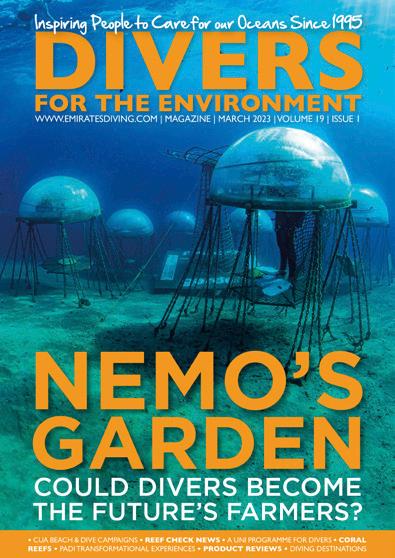
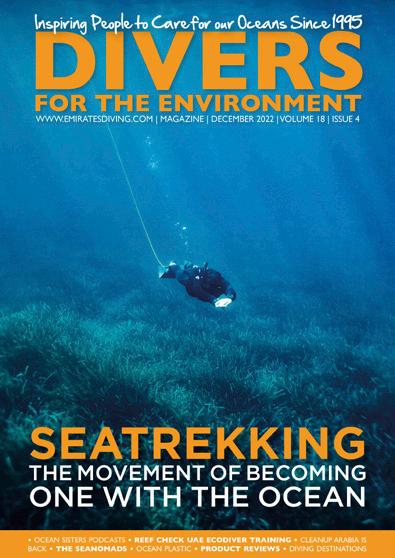
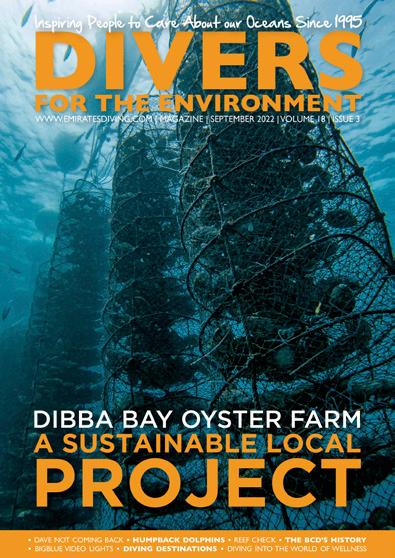
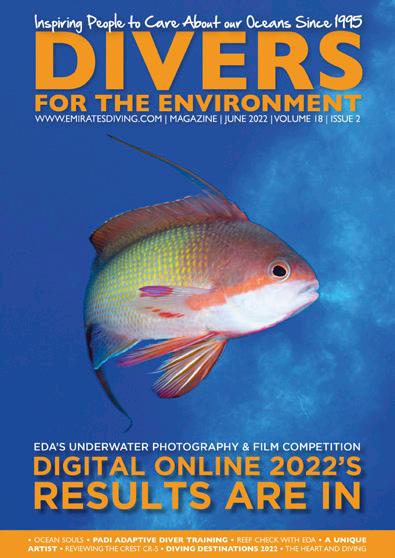
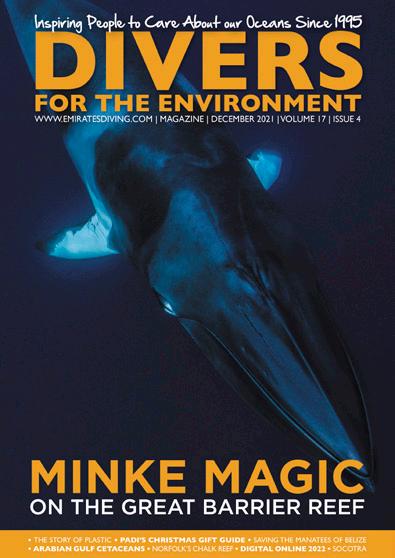
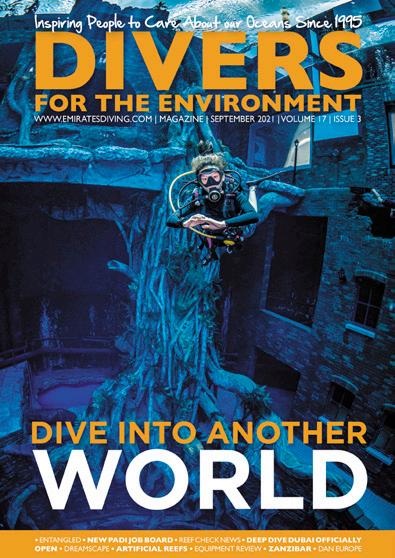
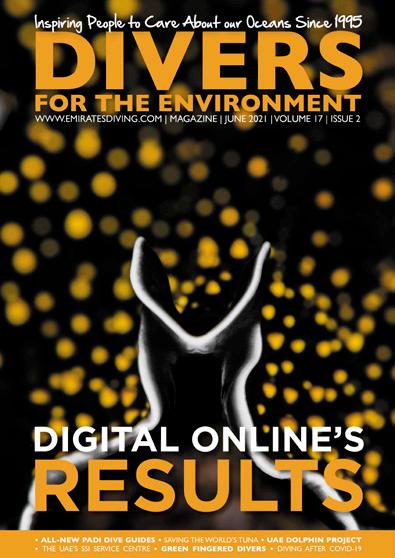






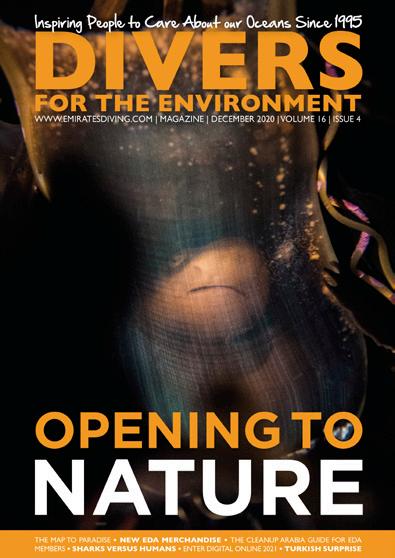
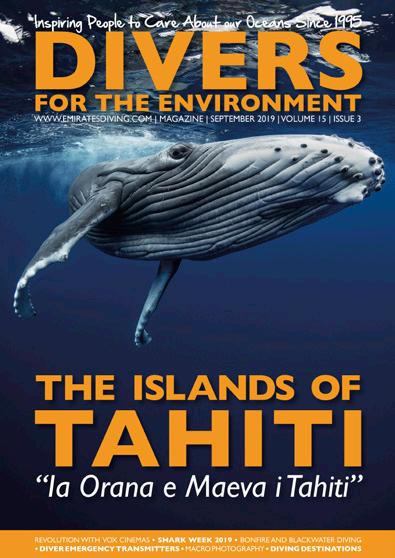



FOR THE OCEANS OCEAN STORIES | CONSERVATION | DIVE TRAVEL Tel: +971 4 393 9390 | Email: projects@emiratesdiving.com | Website: www.emiratesdiving.com EDA is a non-profit NGO accredited by UNEP as an International Environmental Organisation. CLICK HERE EXPLORE ALL OUR BACK ISSUES Beautiful photography and captivating stories, by divers for divers!
UPCOMING EVENTS
DIVE MENA EXPO
CO-LOCATED AT THE DUBAI INTERNATIONAL BOAT SHOW
1-5 March 2023 | 3pm-8pm | Dubai Harbour
Calling all divers to join alongside well-known scuba divers, explorers and underwater photographers to learn about new techniques, technologies and thrilling experiences whether you are a dive school, dive professional, or avid enthusiast. This is the place to be in March.
DIGITAL ONLINE 2023
OPEN FOR PHOTOGRAPHY & FILM ONLINE SUBMISSIONS
6 March - 6 April 2023 at 11:59pm (GST – Gulf Standard Time)
THE AWARDS & EXHIBITION NIGHT
Thursday 18 May 2023 | 7pm | Deep Dive Dubai

We are very much looking forward to this year’s Digital Online – Underwater Photography & Film Competition Awards & Exhibition Night social with our partners at Deep Dive Dive. We have some inspiring new Judges on the panel, and our prize sponsors have offered this year’s winners some incredible prizes. We hope you will join us in congratulating this year’s winning photographers and videographers, and enjoy the evening mingling with other members to see the new photography and film work that will be on display.
REEF CHECK ECODIVER TRAINING
BECOME A CERTIFIED REEF CHECK DIVER
EMAIL: reefcheck@emiratesdiving.com if you would like to receive the next available training dates. Places are limited and on a first come, first served basis.
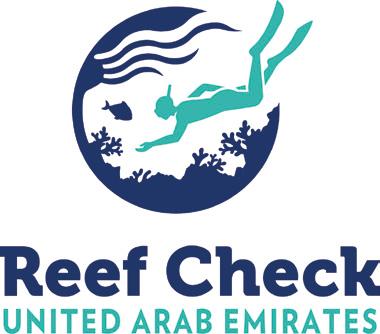
When you join a Reef Check EcoDiver training, you will learn about our local ecosystems and you will be able to participate in our regular survey dives which will help us to understand the threats our corals are facing by providing important data. This 4-day course includes both classroom, fieldwork, and an exam.
Upon completion of this course, you will be able to join the EDA Reef Check team and assist in our regular underwater surveys in the UAE, as well as other underwater surveys in the Indo-Pacific region.

BOARD OF DIRECTORS
Chairman | HE Essa Al Ghurair
Vice Chairman | Juma Khalifa Bin Thalith
Financial Director | HE Major General Khalfan Khalfan Quraiban Al Mheiri
Secretary General | Jamal Abdulla Buhannad
Head of Technical Committee | Dr Juma Khalifa Alrahoomi
Head of the Women’s Committee | Maitha Al Qader
Board Member | HE Talib Ali Aldhuhoori
Board Member | Abdulla Salem Alruwaihy
Board Member | Ahmed Sultan Al Hasawi Al Tamimi
EXECUTIVE TEAM
Co-Founder | Ibrahim Al Zu’bi
Email: projects@emiratesdiving.com
Project Director | Ally Landes
Email: magazine@emiratesdiving.com, photo@emiratesdiving.com
Admin Assistant
Email: projects@emiratesdiving.com
Reef Check Trainer | Rania Shawki Mostafa
Email: reefcheck@emiratesdiving.com
Health, Safety & Technical Chief Inspector | Mohamed Faraj Abdulla Jaber
Email: inspection@emiratesdiving.com
MISSION STATEMENT
Our mission is to conserve, protect and restore the UAE’s marine resources by emphasising and promoting the underwater environment and environmental diving.
LEGISLATION
EDA is a non-profit NGO registered with the Ministry of Community Development as per the Ministerial Decree No. 149.
The Decree stipulates the following responsibilities for EDA:
• Ensure environmentally respectful diving practices in all EDA members.
• Support the diving industry within the UAE by coordinating the efforts of the diving community.
• Promote safety in the commercial and recreational diving fields through standardisation of practices.
• Preserve historical aspects of diving within the gulf region and enhance environmental education to diving and non-diving communities through EDA projects and events.
PUBLISHED BY
Emirates Diving Association
P.O. Box 33220, Dubai, UAE
Office Location: Jumeirah 1, Al Hudaiba Awards Buildings, Block B, 2nd Floor, Office #214
Tel: +971 4 393 9390
Email: projects@emiratesdiving.com
Website: www.emiratesdiving.com
While every effort and care has been made to ensure the accuracy of the information contained in this publication, the publisher cannot accept any responsibility for errors or omissions it may contain.
No part of this publication may be reproduced in a ny form or by any means without the prior written consent of the publisher.
Copyright © Emirates Diving Association 2023
SOCIAL MEDIA CHANNELS
www.Facebook.com/emiratesdivingassociation
www.Instagram.com/emiratesdivingassociation (EDA News)
www.Instagram.com/eda_uae (Digital Online Gallery)
www.twitter.com/EDA_UAE
www.YouTube.com/@emiratesdivingassociation
www.Issuu.com/allylandes
PRINTED
103 MARCH 2023 | DIVERS FOR THE ENVIRONMENT ROUND-UP
Publishing LLC DID YOU KNOW? SHARK NEWS: ISSUE 07 | JANUARY 2023 Welcome to the quarterly issue of Shark News – the official IUCN Species Survival Commission (SSC) Shark Specialist Group (SSG) magazine. Shark News provides a forum for the exchange of information on all aspects of shark, ray, and chimaera conservation matters for SSG members and the general interested audience. DOWNLOAD THE JANUARY 2023 ISSUE: Low Resolution (78.3 Mb): https://bit.ly/3XwSdet High Resolution (110.3 Mb): https://bit.ly/3JcdQg6
BY Al Ghurair Printing &


104 DIVERS FOR THE ENVIRONMENT | MARCH 2023 DUBAI INTERNATIONAL BOAT SHOW 1 5 2023 MARCH Supporting Maritime Authority Official Magazine Partner Co-located with Organised By Hosted at BOATSHOWDUBAI.COM/DIVER/REG FREE ENTRY WITH YOUR DIVING LICENSE YOUR WORLD AROUND THE OCEAN Our dedicated show for the UAE and GCC diving community is the perfect location for everyone; if you are a dive school, dive professional or avid enthusiast, this is the place to be – immerse yourself in the underwater world at the Dive MENA Expo, which will be showcasing all the gear and gadgets from equipment and electronics. Join us alongside world-famous professional divers, explorers and underwater photographers to learn about new techniques, technologies and thrilling experiences. And don’t miss out on the dive pool demonstrations Join us at the Dubai International Boat Show, 1 – 5 March






















 Ibrahim Al-Zu’bi
Ibrahim Al-Zu’bi
































































































































































































 BY ANNIE BAUER-CIVIELLO, REEF CHECK DIRECTOR, RESTORATION PROGRAMME
BY ANNIE BAUER-CIVIELLO, REEF CHECK DIRECTOR, RESTORATION PROGRAMME





 BY REEF CHECK MALAYSIA
BY REEF CHECK MALAYSIA








































































 COVER PHOTO: Hippocampus kuda
COVER PHOTO: Hippocampus kuda
































































































































































